Absolutely everything you need to go bikepacking: the complete guide to what you need to take
Whether you’re a seasoned traveller or just getting started, here’s our guide to make sure you don’t forget anything and for advice on what to take
- (opens in new tab)
- (opens in new tab)
- (opens in new tab)
- Sign up to our newsletter Newsletter


Bikepacking is a wonderful way to spend a holiday or weekend. You get to know the area far more intimately that just staying in some accommodation or camping. Even travelling somewhere fairly local, you’ll experience a very different side of it on a bike than you ever would otherwise.
Like with any holiday or bike ride, there are the many usual things that you really don’t want to forget. So, drawing on our long experience, we’ve put together a guide detailing all the items we take on every bikepacking trip – plus a few optional extras (marked with an asterisk).
If you’ve been riding bikes for a while – and are generally quite an outdoorsy person – you’ll likely have most of the items on this list already. But for those just getting started, for each of the items we’ve included links to both a high-value and a high-end version – each of which we rate and will serve their purpose well.
We learnt the hard way that if an item is a little out of your price range you’re much better off making do with what you currently own and saving up. Go too cheap and it either won’t work sufficiently well or will soon need replacing – ending up costing more than if you had just saved up in the first place!
And if you're after any tech related advice, such as whether to go with clipless or flat pedals for bikepacking, you can find those supporting articles elsewhere on the site.
The expanded list: all you'll need
Items marked with an asterix are ones that can probably be done without on shorter trips.
| Clothing | Bags | Camping gear | Tools and spares | Vital accessories |
| Socks | Handlebar bag | Sleeping mattress | Inner tubes | Phone |
| Shorts | Saddlebag | Sleeping bag | Puncture repair | Wallet / keys |
| Jersey | Helicopter tape | Ground sheet / bivvy bag | Tyre levers | Head unit |
| Arm warmers | Helicopter tape | Tent | Allen keys / chain tool / spoke key | Wall charger / battery pack / cables |
| Rain jacket | Frame bag | Camping stove | Pump | Front and rear lights |
| Gloves | Top tube bag | Coffee making | Quick link | Suncream, chamois cream, lip balm |
| Sunglasses | Stem bag | Row 7 - Cell 2 | Tyre boot* | Lock |
| Shoes | Panniers | Row 8 - Cell 2 | Mech hanger* | Waterbottles |
| Helmet | Rack | Row 9 - Cell 2 | Brake pads* | Headtorch |
| Gilet | Row 10 - Cell 1 | Row 10 - Cell 2 | Cassette tool* | Bike phone mount* |
| Insulated jacket | Row 11 - Cell 1 | Row 11 - Cell 2 | Gear cable* | Penknife* |
| Trousers / tights | Row 12 - Cell 1 | Row 12 - Cell 2 | Adjustable spanner* | Row 12 - Cell 4 |
| Fleecy mid layer* | Row 13 - Cell 1 | Row 13 - Cell 2 | Row 13 - Cell 3 | Row 13 - Cell 4 |
If it's a longer trip that you're going on and you're interested in some specifics. Over here we talk about the kit we used on our two weeks bikepacking around central Europe, for wild camping and wandering around the cities. And if you'd like to find out about the adventure itself, here's the full write up of our bikepacking trip from Budapest to the mountains of Slovakia.
Clothing
Given that you’ll be riding your bike for a fair portion of the day, some quality cycle-specific clothing is a must. Also, even when bikepacking in the height of summer, you will need to bring a surprising number of layers.
Dawnbreak is the coldest point of the day and with the harsh morning daylight blaring through your tent or bivvy bag, you’re not going to be able to put off getting up for long and will need some sufficiently warm clothes.
But even if you won’t be camping, when stopped in exposed locations, you can get cold surprisingly quickly – trust us. But obviously, you don’t want to take more than you need. After much experimentation, we’ve settled on this range of clothing as being the most packable and adaptable for the range of conditions you’re likely to meet.
Socks
It’s well worth bringing two sets of socks. Not only does it allow you to wash one pair while wearing the other, but if you get caught in a downpour, you’ll very much appreciate the option to pull on some dry ones.
dhb Aeron Light Weight Merino Sock
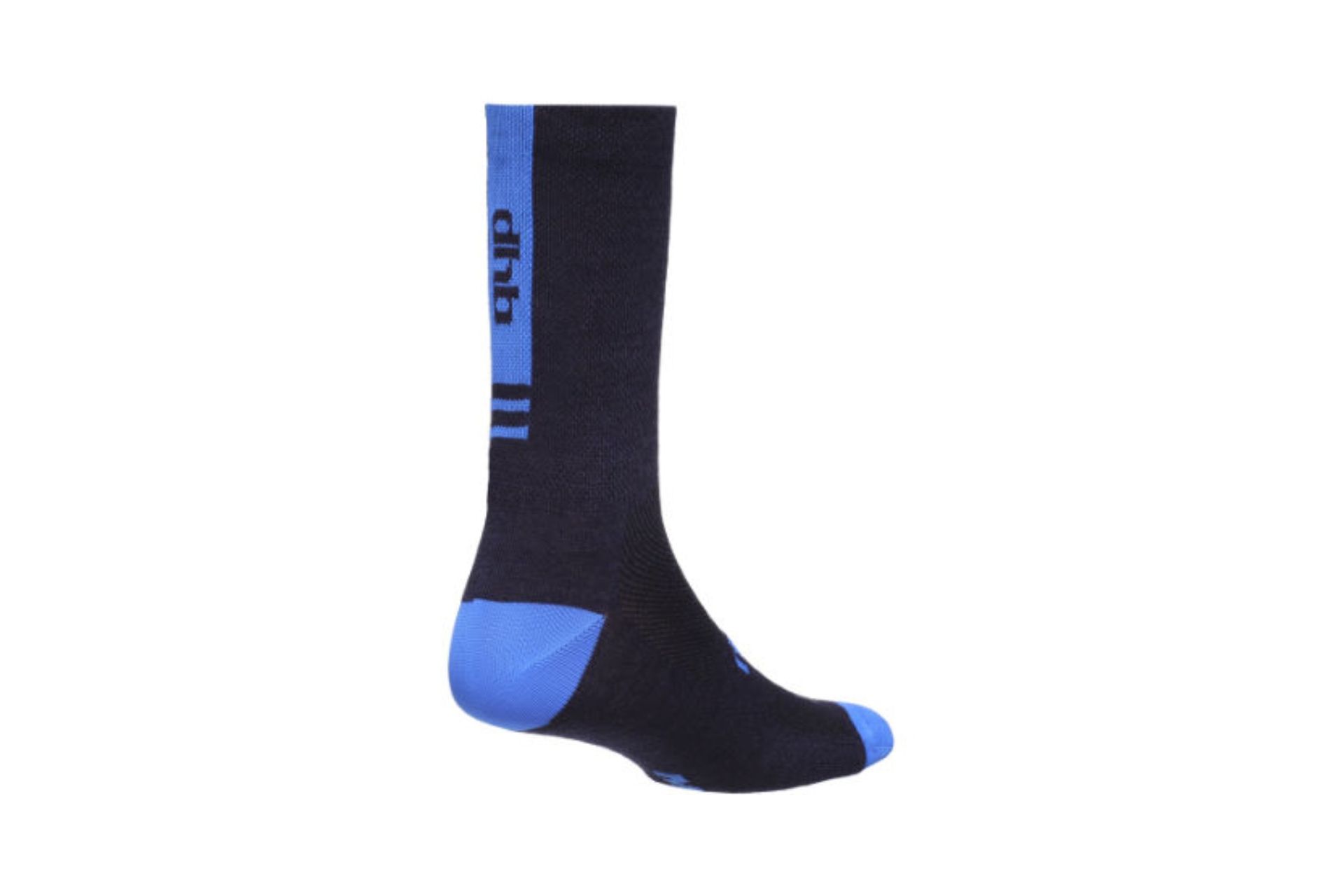
Although any socks will do the job, if you have the choice, a lightweight merino pair are the ones to go for. Merino wool has natural anti-bacterial properties and will go a long way to keeping your feet fresher when out and about all day.
You could even get away with not washing them every evening – but of course that wouldn’t be something we know from experience…
Rapha Merino Socks

A little more expensive, but that’s reflected in the quality of the construction. The wonder fabric of merino also combines good thermal insulation as well as being fast wicking – so they are warm in the cold and also comfortable in the heat.
Shorts
A good set of cycling shorts is very important for bikepacking, as you’ll generally be spending longer in the saddle than you usually do. A comfortable chamois and a good fit is really a must. We have a full guide with all the information you need to know about shorts (opens in new tab), but here are two highlights.
Even more so than with the socks, it’s very important to bring two. Bacteria can grow quickly in shorts so they really must be washed every time before being reworn, otherwise you could find yourself with some potential ride ending saddle sores.
dhb Classic bib shorts

Available in both men's and women's fit, these dhb bibs are a brilliant entry level option, offering comparable comfort to shorts much more expensive. For much more information about these shorts, you can read our full review. (opens in new tab)
It’s also worth bearing in mind that it can be good to have shorts from two different brands. This way the seams are in different locations and can help reduce irritations that don’t present themselves on shorter rides.
Rapha Core Cargo bib shorts
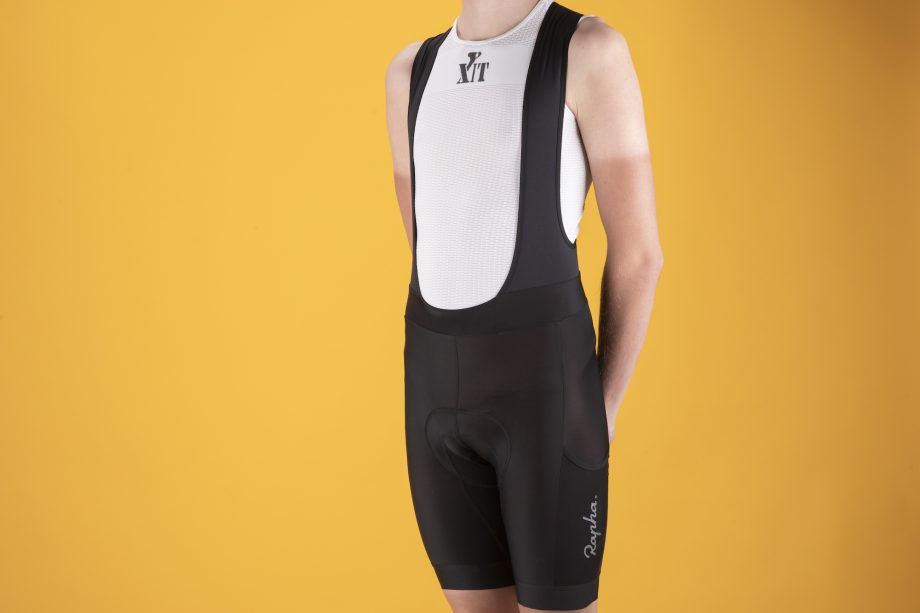
Not only do these have a great chamois and a perfect fit, but they also offer extra storage options with mesh pockets on the thigh and lower back. They were so good that we awarded them a full 10/10 in our review.
These aren’t exactly a necessity, but they come in so handy – once you’ve experienced shorts with cargo pockets, it’s very difficult to go back.
Raha makes its Cargo shorts for both men and women.
Jersey
Any cycling jersey with rear pockets will do the trick for bikepacking. As with socks and shorts, bringing two sets does help with the washing.
Alternatively, you could bring one jersey and one normal T-shirt, if you want something a bit more relaxed for the evenings.
RC900 Merino Short Sleeve Cycling Jersey
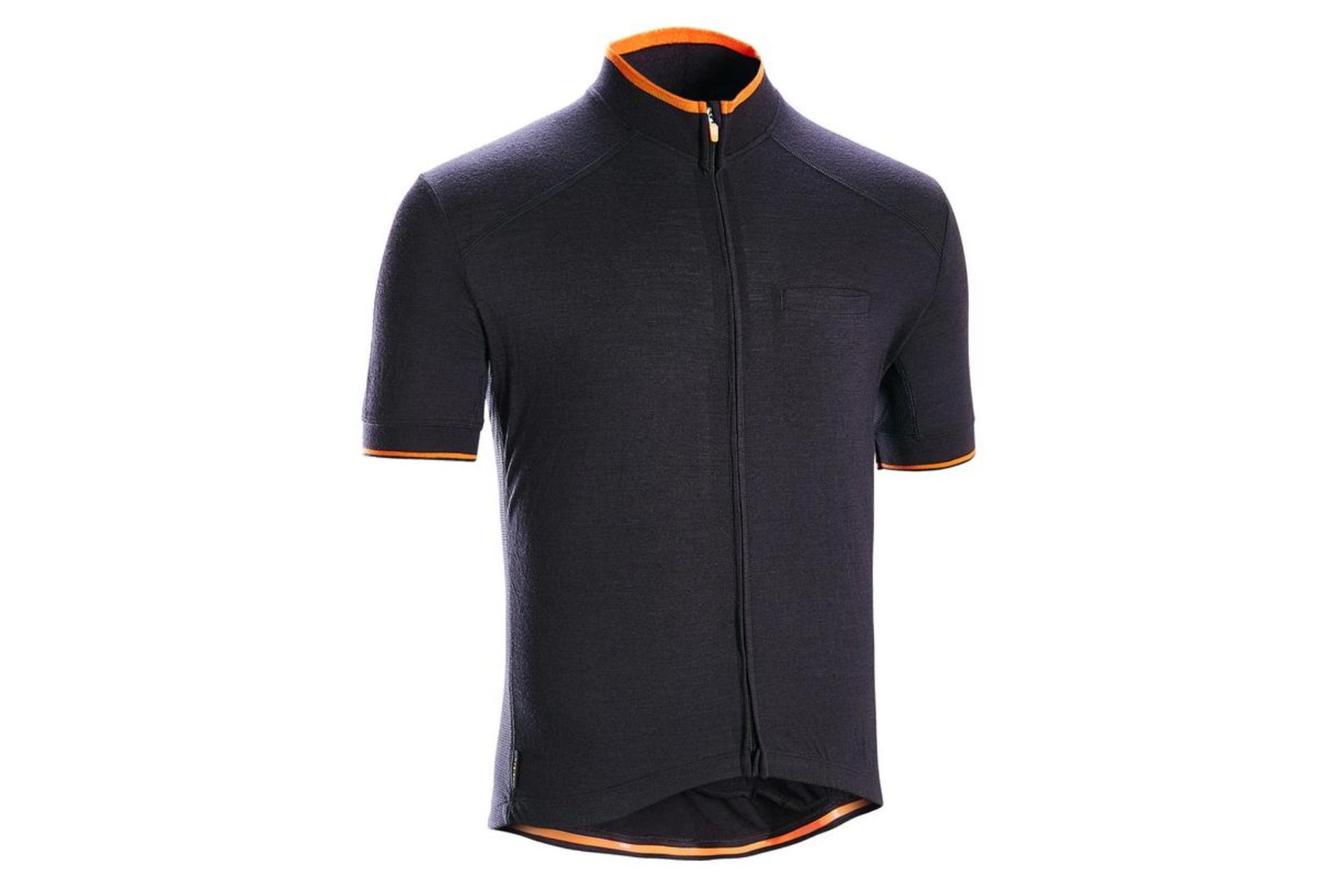
Merino is just as magical for jerseys as it is for socks, imparting all those wonderful qualities of odour reduction, thermal insulation and being quick wicking.
It makes a great addition for just your general cycling wardrobe, too. Because of the antibacterial properties, you can get a lot more use out of a merino jersey than a Lycra one before putting it in the wash.
Sadly we couldn't find this one in a women's fit.
Ashlu Merino Jersey 7Mesh

One downside merino jerseys do have is that the fabric isn’t as supportive as Lycra, meaning the pockets have a tendency to sag if loaded up with lots of heavy items.
7Mesh solves this problem by constructing the pockets from a polyester and elastane blend, meaning they’re just as supportive as any other jersey – but still retaining all the wonderful qualities of a merino jersey.
7Mesh makes this jersey in fits for men and women.
View item: Ashlu Merino Jersey 7Mesh at Sigma Sports for £130.00 (opens in new tab)
Arm warmers
These are so useful for temperature regulation on the go, you can just pull them up or down depending on the weather – rather than having to keep on stopping to pull on a layer and take it off.
They also keep you disproportionately warm for the size they actually take up, so represent a really space efficient way of keeping warm.
dhb Regulate Thermal Arm Warmers

These are really some of the best, they’re a lot cheaper than many other options, but they perform the job perfectly – keeping you warm and actually staying up. There’s almost no need to spend more.
Assos armWarmer_evo7 arm warmers

But for those who want the ultimate in arm warmers, there is Assos’ offering. Built with the quality that is synonymous with the Swiss brand, these will last you season after season, all the while providing the same performance.
Rain jacket
Although you may already have a cycling rain cape, that’s not what we’re actually looking for here. The best rain jackets for bikepacking are much closer to ones you might use for hiking, hill running, or some other active sport. Cycling rain capes tend to be a bit too fitted, making them awkward for putting up a tent, or anything else off-the-bike.
You also want a rain jacket that will fit nicely over an insulated jacket – this pairing is quite lightweight and relatively low bulk, but it will keep you warm down to the temperatures you’re likely to experience when out in the early morning or late evening.
Quechua Men's Fast Hiking Ultra Lightweight Waterproof Jacket - FH 500
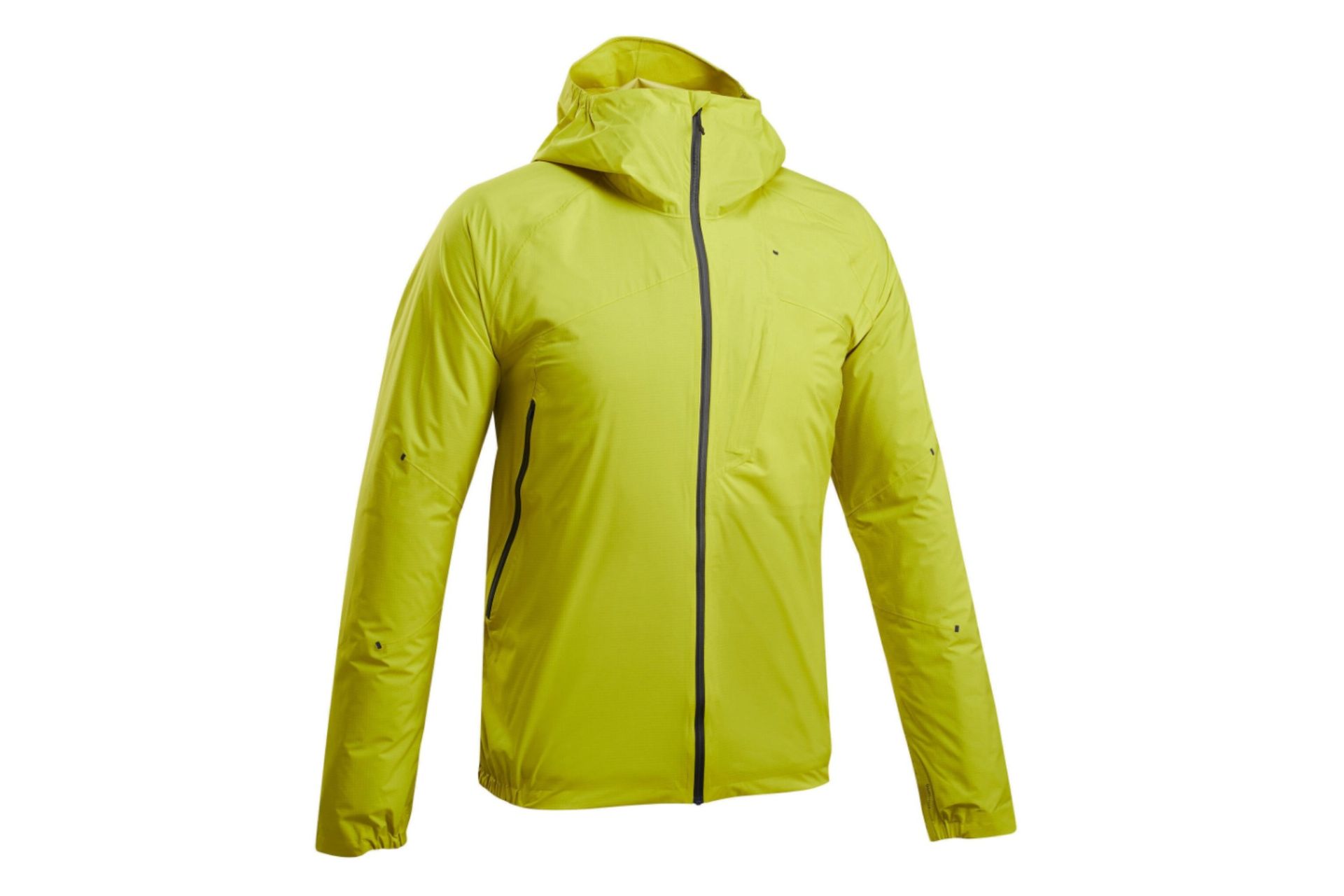
Not only does Decathlon produce some very competitively priced bikes, it also does a pretty extensive line in clothing.
This jacket has the right cut to be unrestrictive off the bike and will also be able to fit some layers in underneath – just what’s needed for bikepacking. It comes in both a men's and women's fit.
Gore Wear C5 GORE-TEX Trail Hooded Jacket
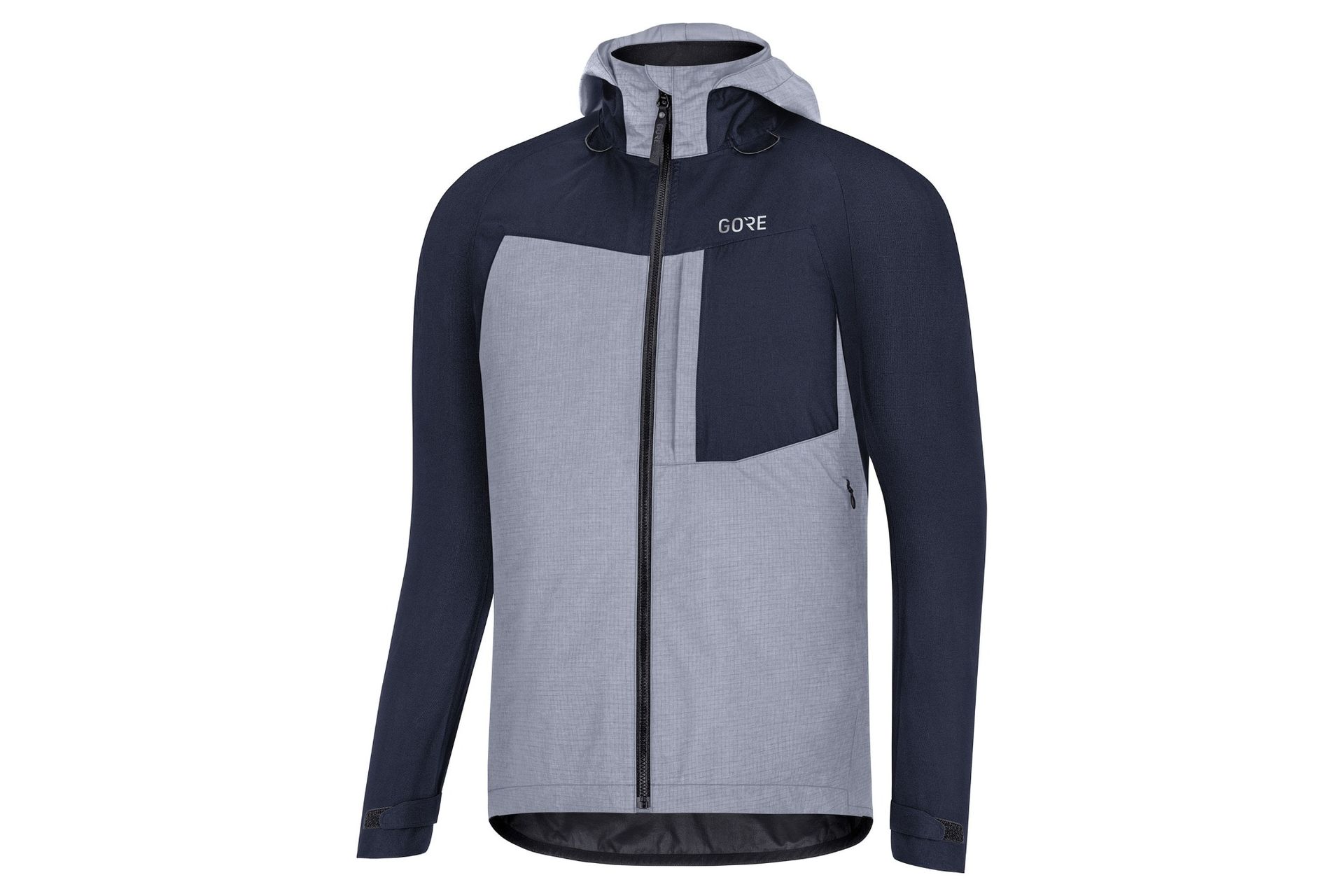
A little more cycling specific, mountain biking clothing generally offers a great compromise between a good general fit while also working well for cycling.
The nature of mountain biking means that there’s space for layers underneath – and it won’t be awkward for any stints off the bike. But on the other hand, the arms are made a little longer to still cover your wrists when reaching for the bars and the tail does have a bit of a drop to it.
There are men's and women's versions of this jacket.
Gloves
On cold mornings – or in the rain – your hands can easily end up unpleasantly chilly and stiff. Also, if you’re not used to spending this amount of time on the bike, a set of gloves can help mitigate and prevent any blisters.
Here we have only one item, as the mid-priced option is just simply the best. There’s really no point in spending any more or less.
But if you already have a set of gloves you’re happy with, then there’s no need to upgrade – better financially and environmentally to not buy new things unnecessarily. However, if you are looking for a new set, we can heartly recommend these.
100% Brisker Cold Weather Gloves
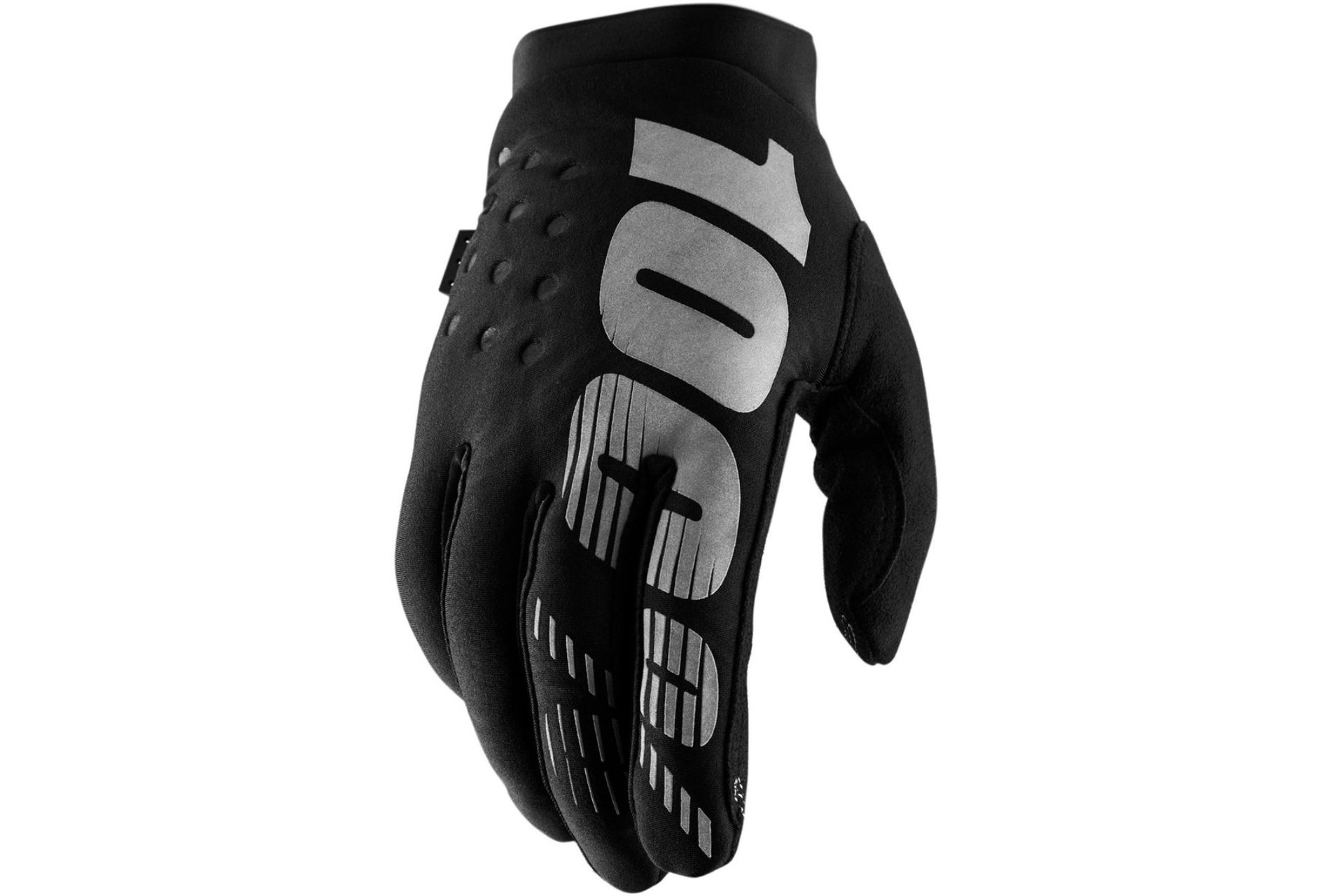
These are warm for their size but aren’t so hot that they can’t be worn in the summer for the primary purpose of protecting your palms. The total temperature range they can be used in is simply ridiculous.
The large reflective logo is great for indicating turns at night and the fingers work well with a touch screen. They’re super comfy and really hard wearing, there’s literally not a bad word to say about them.
Sunglasses
Keeping the sun out of your eyes, as well as bugs and bits of rock, makes for a much more pleasant ride – and it’s also important for your long term optical health.
You’ll very likely already have a set, but nevertheless, we’ll pop in our recommendations for a budget and more expensive version.
DeWalt Reinforcer Smoke Ploycarbon Safety Glasses

If you are after some really cheap sunglasses that can put up with the rigours of cycling, going for some designed for builders is the way to go. They have the necessary clarity and robustness, although they do forgo the anti-fogging and high-contrast visuals that fancier cycling specific lenses provide.
But at a tiny fraction of the cost of even mid-range cycling sunglasses, they do present an attractive option. You could even pick up a clear set for cycling in the dark.
Smith Optics Attack Mag MTB Photochromic Cycling Glasses

Photochromic sunglasses are a massive help for bikepacking, automatically adjusting the tint to the ambient light levels. You can pop these on in the morning and not have to give them a second thought, even as you ride late into the evening with the sun setting.
Shoes
Road cycling shoes are great for the efficient pedalling stroke and the support they provide, but those large and plastic cleats and very stiff soles aren’t the best choice for bikepacking.
You’re far better off with a set of mountain bike shoes with a 2-bolt cleat. These are a lot easier to walk around in, you won’t damage the shoe or cleat, and the pedals are much better at coping with a bit of muck.
You might not be planning on doing much walking, but trust us, for one reason or another you do always end up doing a fair amount. The best commuter cycling shoes for urban and gravel use can do dual duty, both allowing you to pedal efficiently and get around either in camp or when you're doing some sightseeing once you arrive. Although some have SPD cleat fittings, we reckon there's a case to be made for wearing flat soled cycling shoes for bikepacking.
Recon 2.0 Mountain Bike Shoes
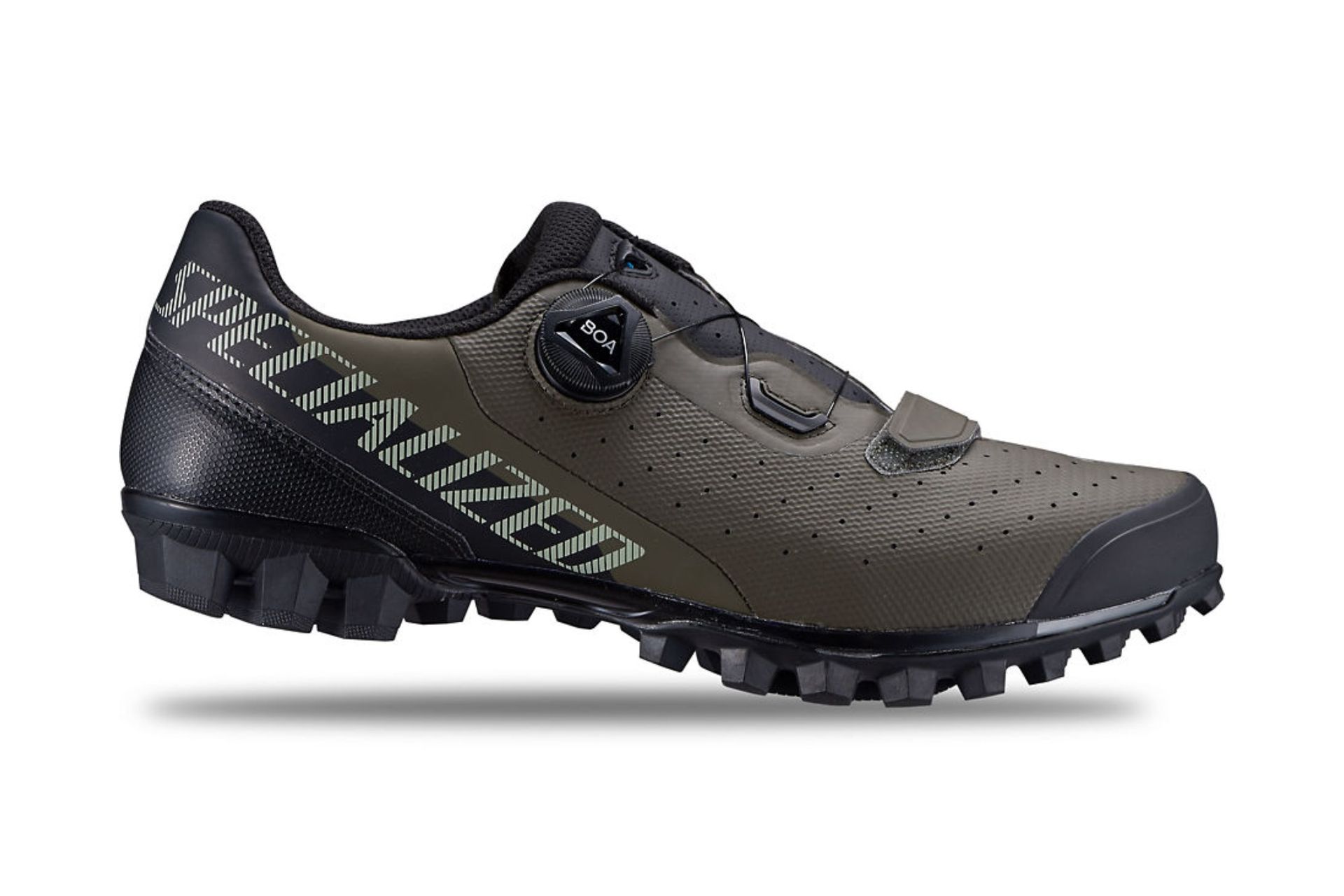
These shoes are ideal for bikepacking. The flexible forefoot makes these even easier to move about off the bike than an ordinary set of mountain bike shoes, but with a firm sole for the rest of the length, there’s not a significant loss in power transfer. You can read the full review here. (opens in new tab)
If you’re looking for a cheaper set, there’s the £99 Recon 1.0 with the same sole but Velcro binding. Or if you are fully committed to having two Boa dials which can be tightened and backed off in millimetre increments, there’s the £370 S-Works Recon option.
Under Armour Men UA M Locker III Slides
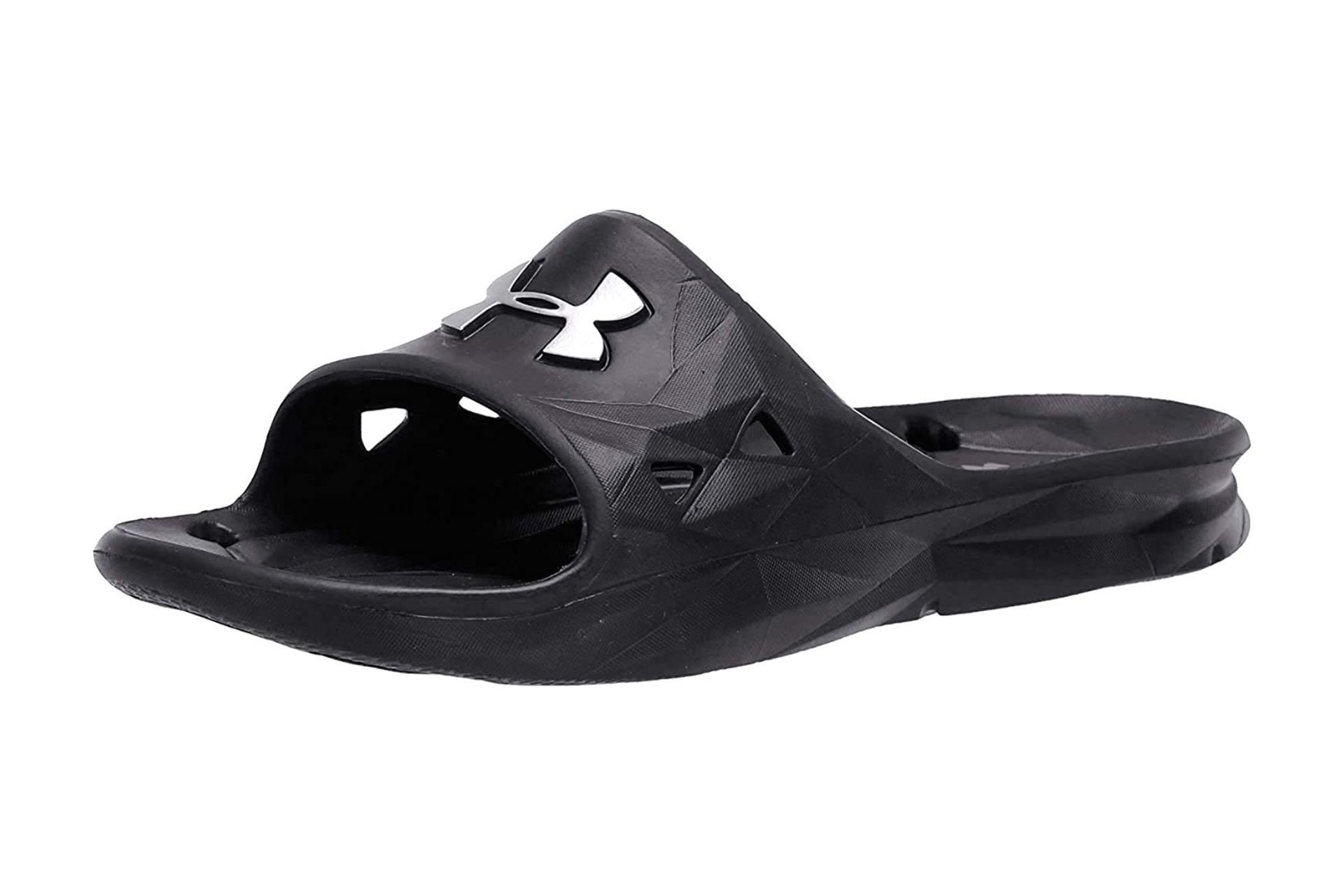
If you don’t have any shoes with a 2-bolt cleat and you’re not in a position to buy some, instead opting to use road shoes or trainers for riding, we very much recommend getting a set of sliders for your off-bike activities (best not try to ride in them!). They’re lightweight, easy to put on, and make it so much easier to walk across a field to go to the toilet in the morning.
And particularly if you’re camping, having some footwear you can quicky slip on is so surprisingly helpful that they’re often worth bringing even if you have mountain bike shoes.
Helmet
There’s nothing really bikepacking specific about this, more just a reminder to bring this along when packing – surprisingly easy to forget if you’re taking a car or train to the start point of your trip, rather than just rolling out the door.
We’ve pulled out a high value and a top end option here, but if you want to dig into a bit more detail, you should check out our helmet buying guide here.
Abus Macator helmet
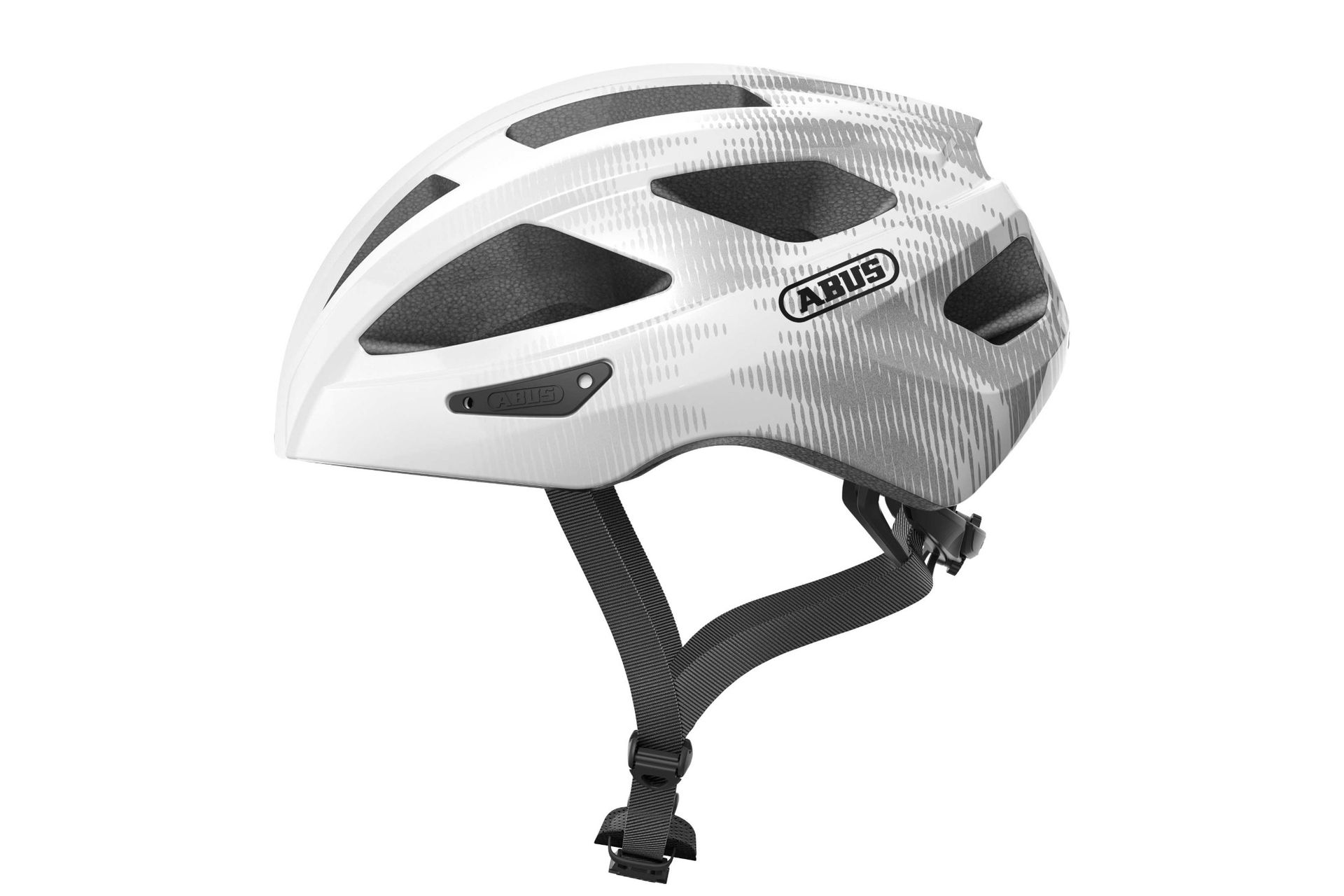
One of the best helmets out there for the price, the Abus Macator is comfortable, stylish, and highly adjustable. Our full review (opens in new tab), with all the details, is just here.
Giro Helios Spherical helmet
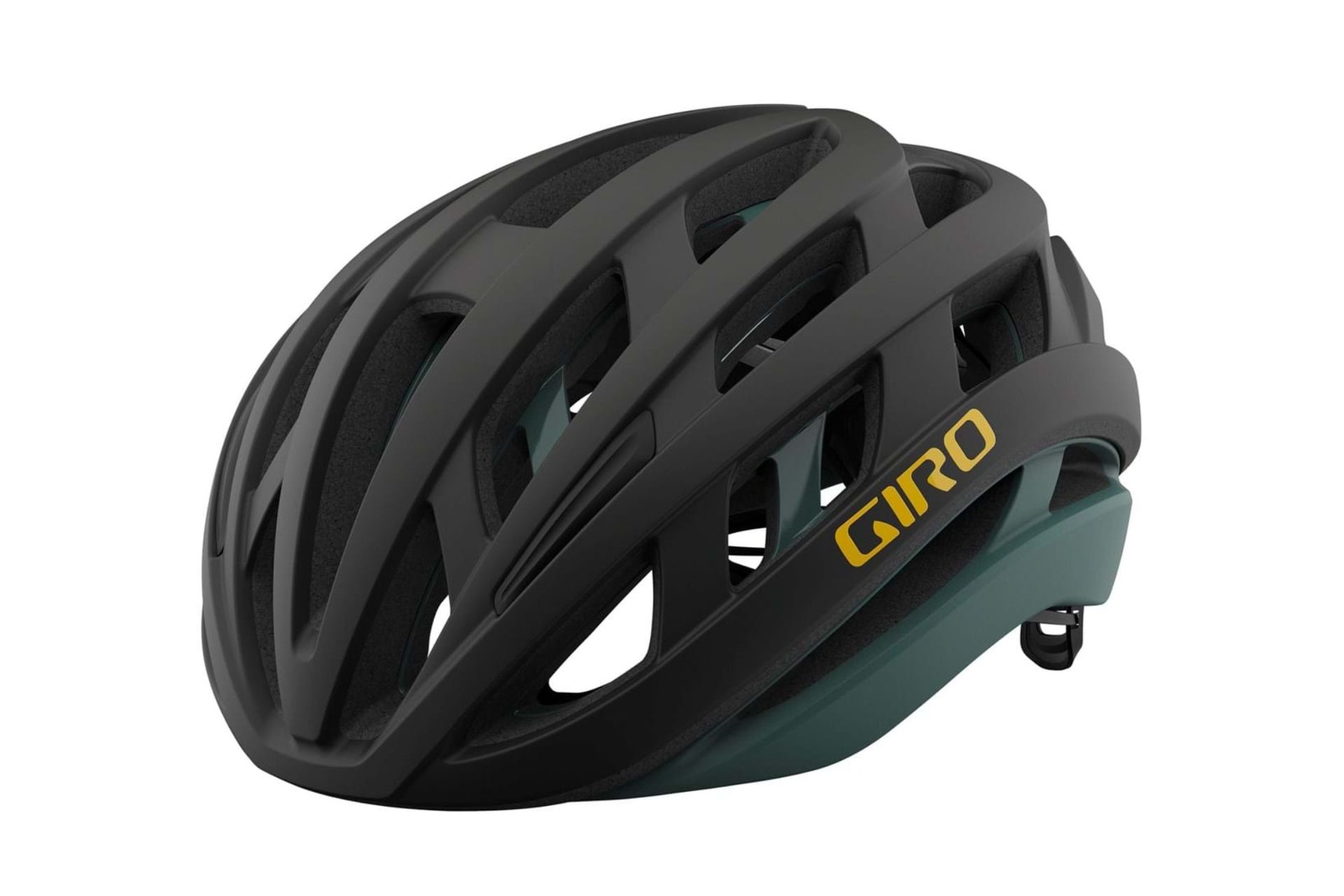
Incorporating MIPS technology for increased protection from rotational impacts, Giro’s Helios helmet is simply flawless, being lightweight and also having a perfect fit. More details can be found in our review (opens in new tab).
Gilet
You might not already have one of these, but an insulated gilet, or vest, is really one of the most useful pieces of kit for bikepacking. They can pack down super small, but keep so you warm on chilly mornings, exposed hill tops, and during al fresco meals in the evening.
They’re also incredibly useful for just general riding, when there’s a large temperature differential throughout the day. If you haven’t had one before, it’s very well worth getting one
dhb Aeron Polartec Alpha Gilet
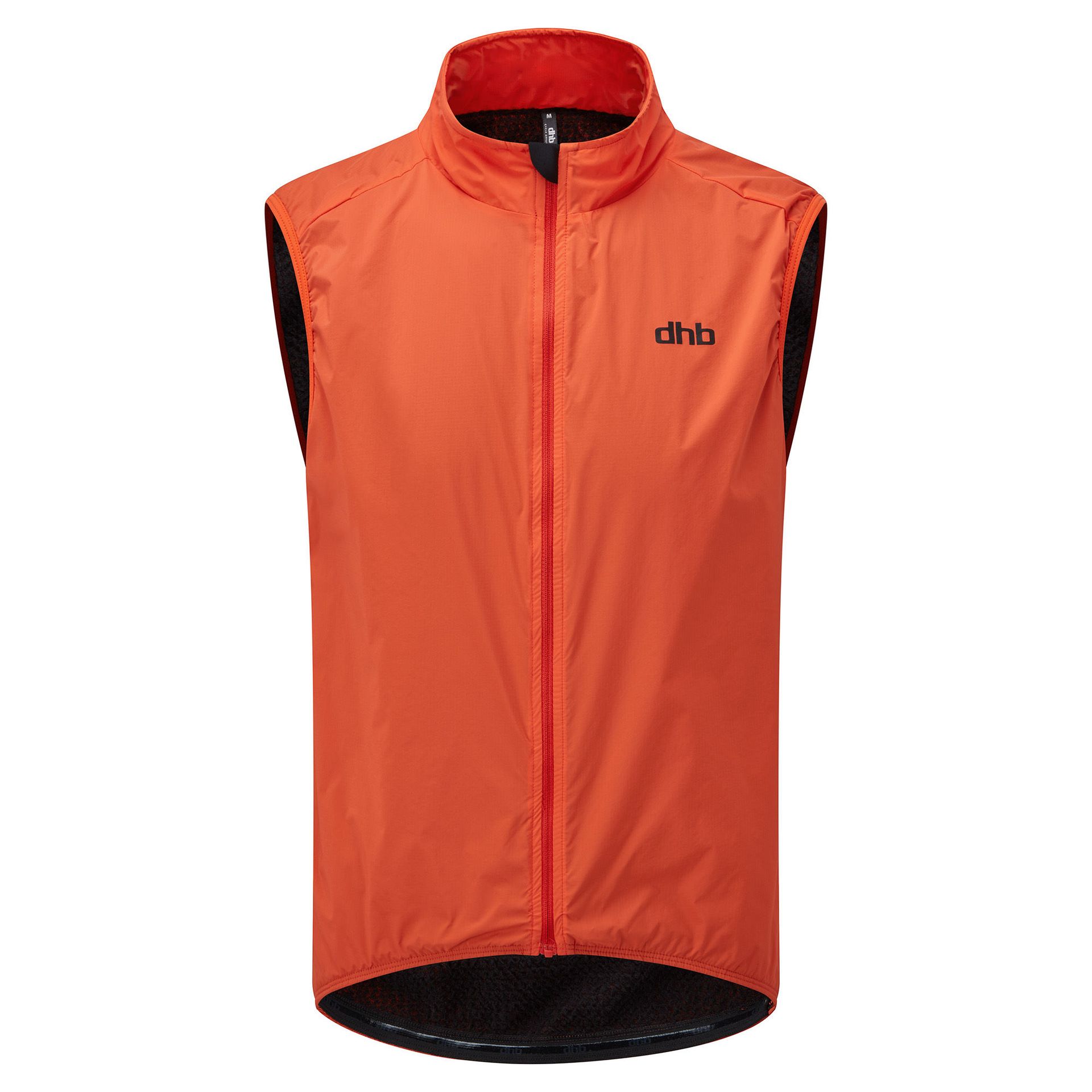
It really helps to get one which either has easy access to your jersey pockets – by a second zip or side ports – or one which has its own pockets, as this one does. Just makes it a lot easier to get to the things you need.
With this and a set of arm warmers, you’ll remain comfortable through huge swings of temperature. Staying pleasantly warm at around 10°C (which is the average summer low for much of the UK), but also with the option to pull down the arms and unzip the gilet, which should keep you cool enough up to 18°C.
By which point you’re probably due a stop anyway and can take off the warmers and gilet and stuff them away for the evening. This gilet comes in men's and women's fits.
Insulated jacket
Yes, there is a lot of emphasis on staying warm here, but that’s really just a reflection of the fundamental fact that to cool down you just need to take layers off – and so there isn’t much to say on clothing on that end of things once you’ve got a summer set of bib shorts, jersey and socks.
So, back on the topic of staying warm! Insulated jackets are lightweight and can pack down small, but still offer a great deal of warmth. You’ll essentially live in it in the early mornings and late evenings—it also allows you to go a little lighter weight on your sleeping bag.
And all these qualities insulated jackets have make them just so useful for everyday life—for the amount of use you’re likely to get out of it, it really is one of the best value things you can buy.
Föhn Micro Synthetic Down Jacket

You really, really want to get a jacket with synthetic down. This retains far more of its thermal properties when wet than natural down (which is essentially none) and will go back to offering its full original warmth once it’s dried out. Natural down, even when specially treated, is never quite the same.
This jacket from Wiggle’s in-house outdoor brand, Föhn, is one of the cheapest synthetic down jacket you’ll find – that is of sufficiently high quality. Although quite an investment, it’s well worth saving up for this one.
Patagonia Men's Micro Puff Synthetic Jacket
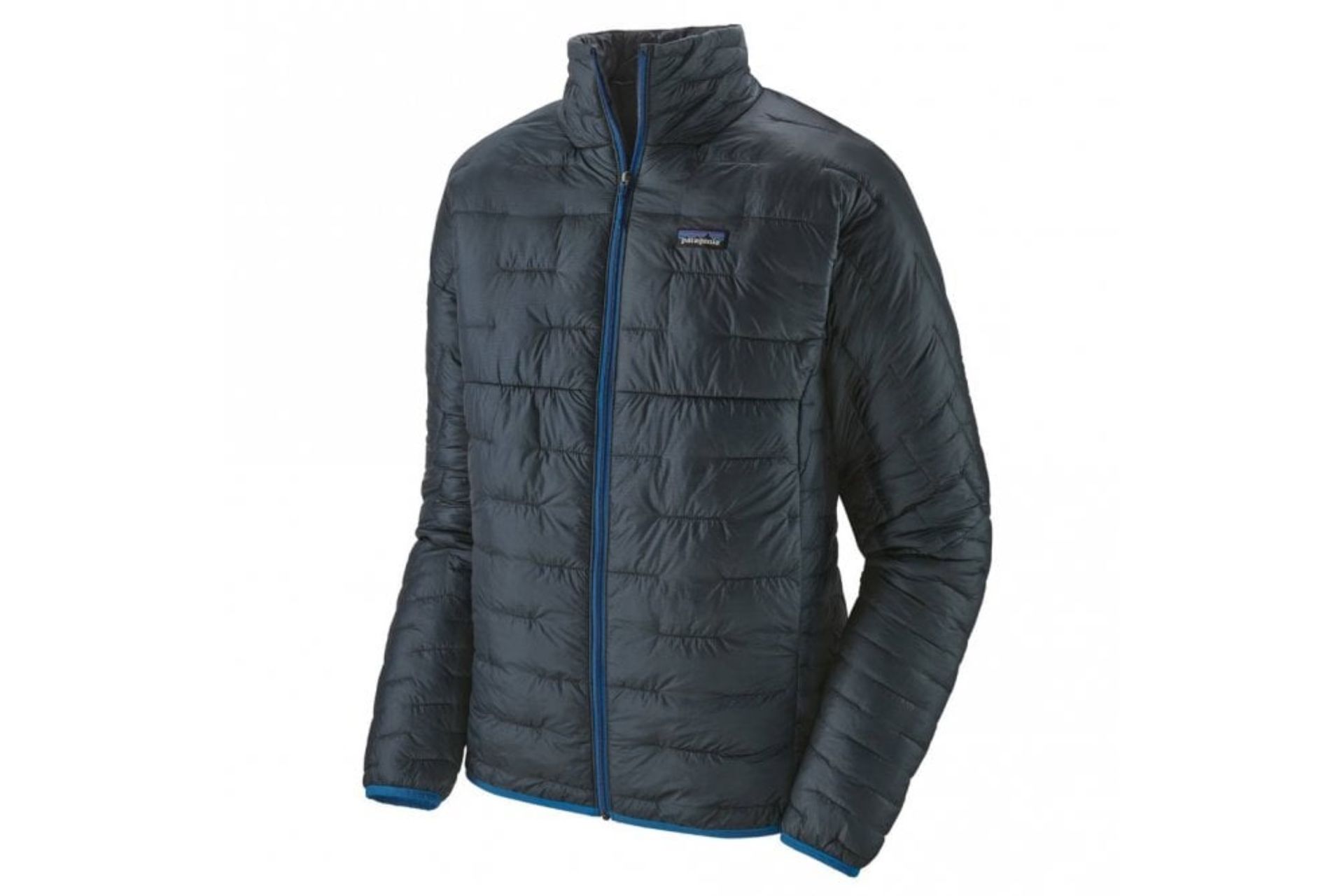
Much the same in function as a cheaper option, but with the excellent build quality, customer aftercare and environmentalism that’s an integral part of Patagonia’s ethos. It might cost quite a bit more, but at least you know that money is going towards the important things.
Trousers / tights
It really helps to have some form of leg wear other than shorts. Beyond just being an extra layer, it gives you something to wear in the evenings when you might not want to be hanging around in some skimpy Lycra.
We’ve got two very different options suggested here. Which is best for you will really depend on your circumstances, what your style is, and how long your trip will be.
Vaude Men's Farley Stretch Zip II Trousers
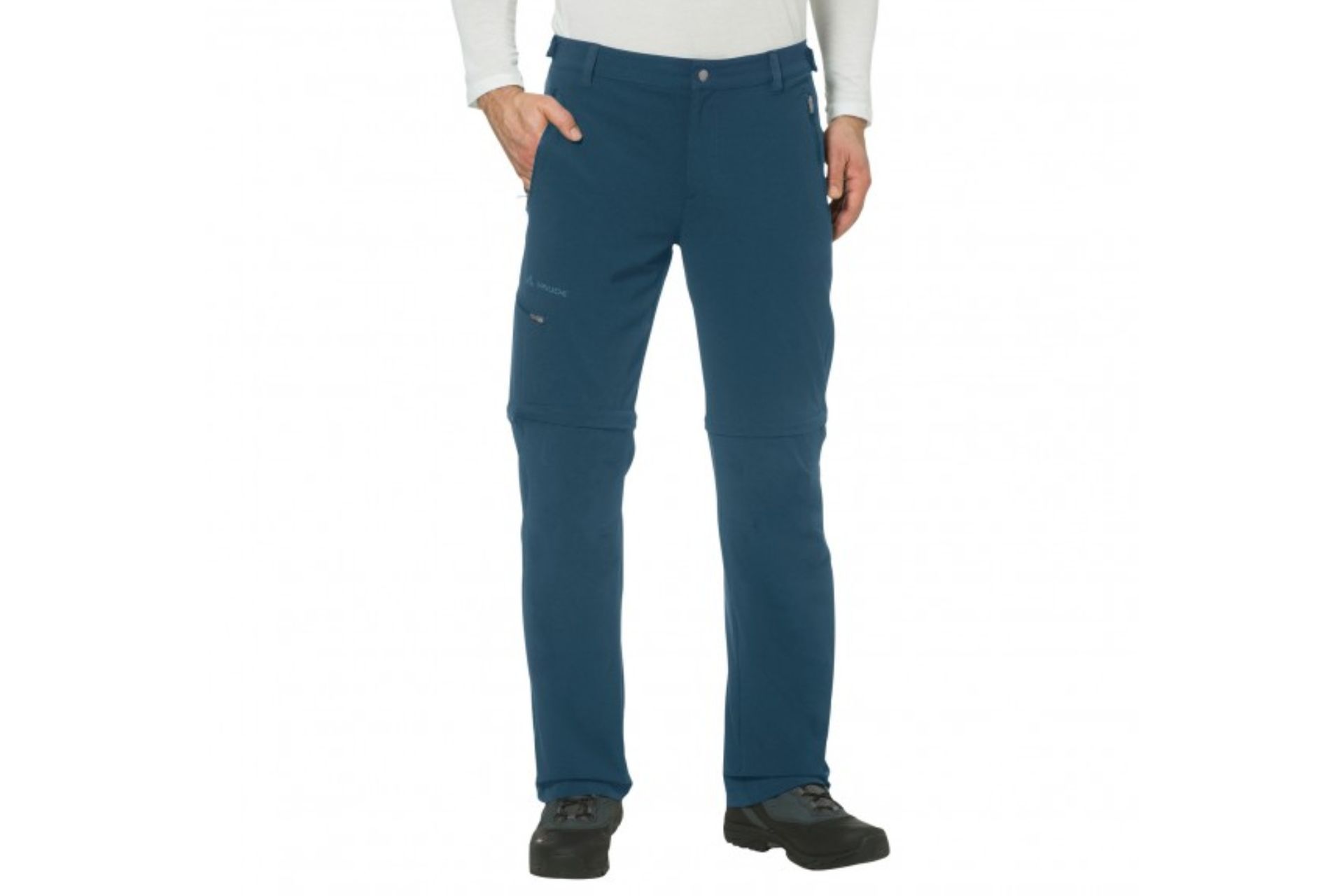
Zip-off trousers aren’t exactly a ground breaking concept, but they are super useful for bikepacking. These ones, which come in a men's and women's fit, are quite lightweight and will pack down small. Also, for warmer days, the ability to do without the legs is a great help towards keeping cool.
ETC Full Zip Tights

These tights - which ETC say offer a unisex fit - are so useful, they are another item you won’t understand how you lived without them. With a full-length zip down the side, they are super quick to take off and very easy to pull on – particularly over shoes.
They are a little more bulky than just a set of leg warmers. But in being so quick and easy to take on and off, they are most certainly worth it. Unlike leg warmers, they can also be worn on their own without needing a set of shorts, making these tights a little more versatile.
If you do any racing as well, these really help with staying toasty during the warm up, but being very quick to take off when it comes time to line up at the start.
Fleecy mid-layer
This is an optional extra. If you have arm warmers and a gilet, you essentially have a mid-layer there, it’s just in three parts. Although insulated jackets are very warm, they work best if you do have a fleecy layer in the middle.
For longer trips, we’d still take one. It’s nice to have something a little looser fitting that can be quickly thrown on – unlike a gilet and arm warmers. But for shorter trips where you want to carry as little as possible, this is one of the first items that can go.
Haglöfs Men's Astro Fleece Jacket

Going for a relatively slim fit makes it easier to combine the fleece with other layers, such as an insulated jacket and rain shell for when the weather is really miserable. It also goes a little way to reducing the weight and bulk.
You really want one with a full length zip. For the times that you’re throwing this over your jersey, a pullover tends to not play so well with all the things you might have stuffed in your pockets.
Bags
Bikepacking bags are a lightweight way to carry all the things you need for a two-wheeled trip – whether that’s a quick overnighter or a multiday affair. In (usually) attaching to the bike with simple straps, these bags are also highly versatile and enable you to use pretty much any bike – making bikepacking a more accessible way to get out into nature.
What bags are right for you depends on the length of your trip, whether you’re planning on camping, and how many extra items you intend to take.
For shorter trips which don’t involve camping, a large saddle bag and a big handlebar bag might be all you need. This system also ensures all your luggage is kept well out of the way of your knees, preventing any rubbing.
Sleeping gear is generally quite bulky – and if you add in a stove and a tent, you’ll find your bags quickly filling up. For the full outdoor experience, you will need a large frame bag, top tube bag and potentially also a stem bag to fit everything in.
Although a little heavier, don’t discount a rack and panniers as a potential carrying system. They tend to be a lot cheaper than a full complement of bikepacking bags and you’ll have more space as well as being a little easier to pack.
Remember, it shouldn’t be a struggle to fit everything in your bags. For one thing, you need to leave space for bringing on some food and for another, you’re going to find it incredibly frustrating when out riding if there’s only one very precise way the bag can be packed for everything to fit. You’ll either need to leave some things out or get another bag.
Handlebar bag
A true staple of bikepacking. These are an efficient way to carry a lot of things – only saddle bags tend to be larger. A handlebar bag also helps to even out the weight distribution of the bike, which can tend to get a little rear-end heavy.
Unlike a saddlebag, certain handlebar bags can be accessed while riding, which can help with fuelling, layering and photos. They are also out of the way of your legs, so no worries about continually hitting your knees on them.
LifeLine Adventure Handlebar Bag
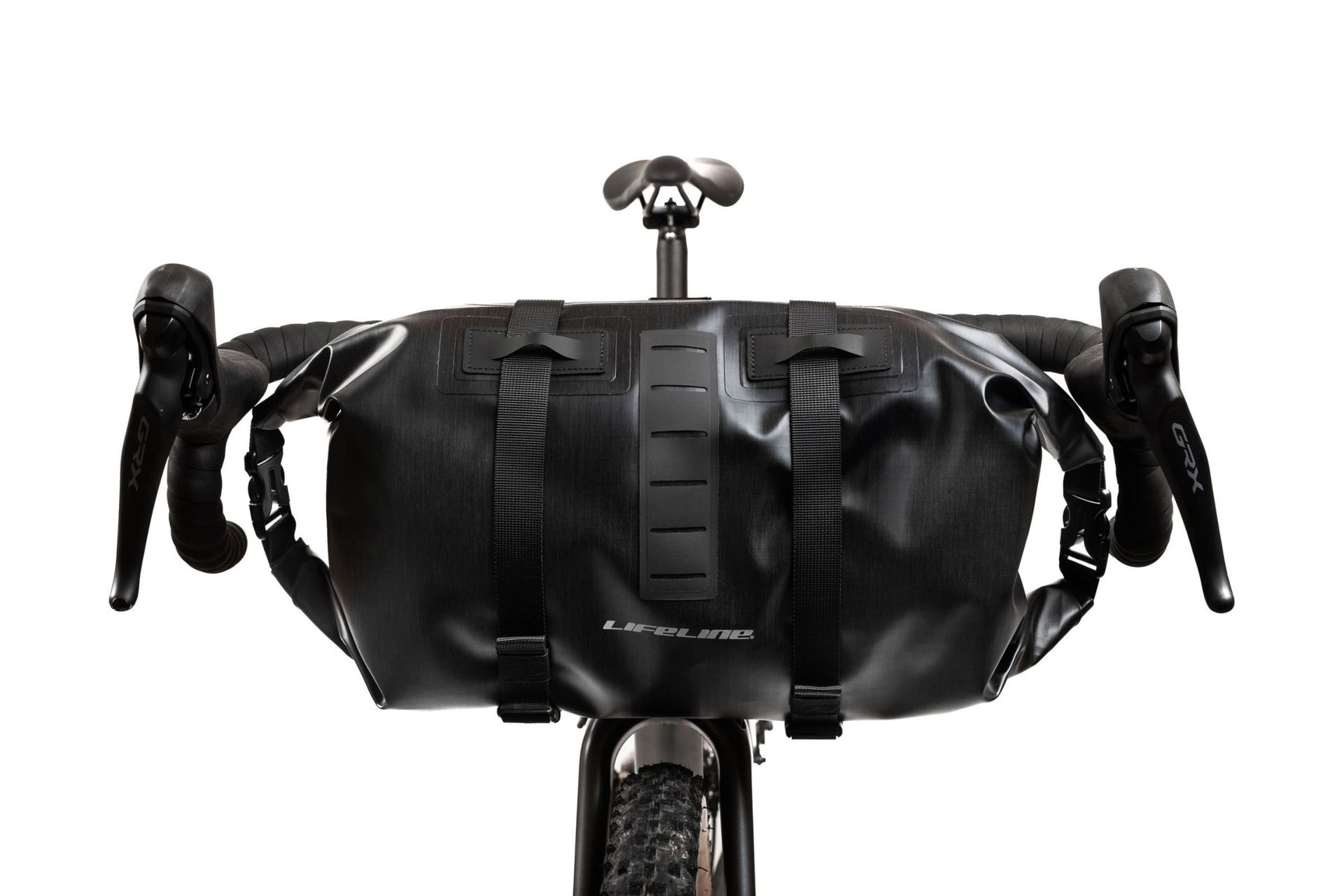
This is what we might call the classic style of handlebar bag. Essentially, a dry bag with straps and two roll-top entries at the sides. It is still an efficient way of carrying your things, but it tends to be a quite a pain to get your things in and out.
With this style of handlebar bag we tend to try and fill it with items we won’t be using until the evening. As they can be quite cheap, this style is still great for bikepacking on a budget.
Restrap Bar Pack

This is, without any exaggeration, the best handlebar bag we’ve come across. Unless you need to go for the cheapest available option, this is absolutely the one to get.
A large, vertically oriented roll top entry makes it super easy to get your things in and out – much more so than any design with a zip. The drawcord on top is great for stashing wet layers or packets of croissants and a front pocket with a Velcro flap makes it easy to access small items while on the move.
It’s even got a handy way to store a D-lock, making it so much easier to secure your bike – locks are generally quite a hard thing to find a place for.
For bikepacking trips which don’t involve camping, we find just this handlebar bag and a large saddle bag is all you need.
USA view item: Restrap Bar Pack at Restrap for $157.99
UK view item: Restrap Bar Pack at Restrap for £104.99
Saddlebag
There’s a lot of space behind the saddle, meaning this is the place most of your things will get stored. Remember to pack heavy things nearer the bottom as this will help reduce sway and issues the bag flopping down dangerously close to the tyre.
Like with handlebar bags, saddle bags are particularly good for storing compressible items, such as clothing, sleeping bags, or the canvas of a tent – so really make the most of this for bulkier items and use frame and top tube bags for more rigid things.
Zefal Z Adventure R 17L
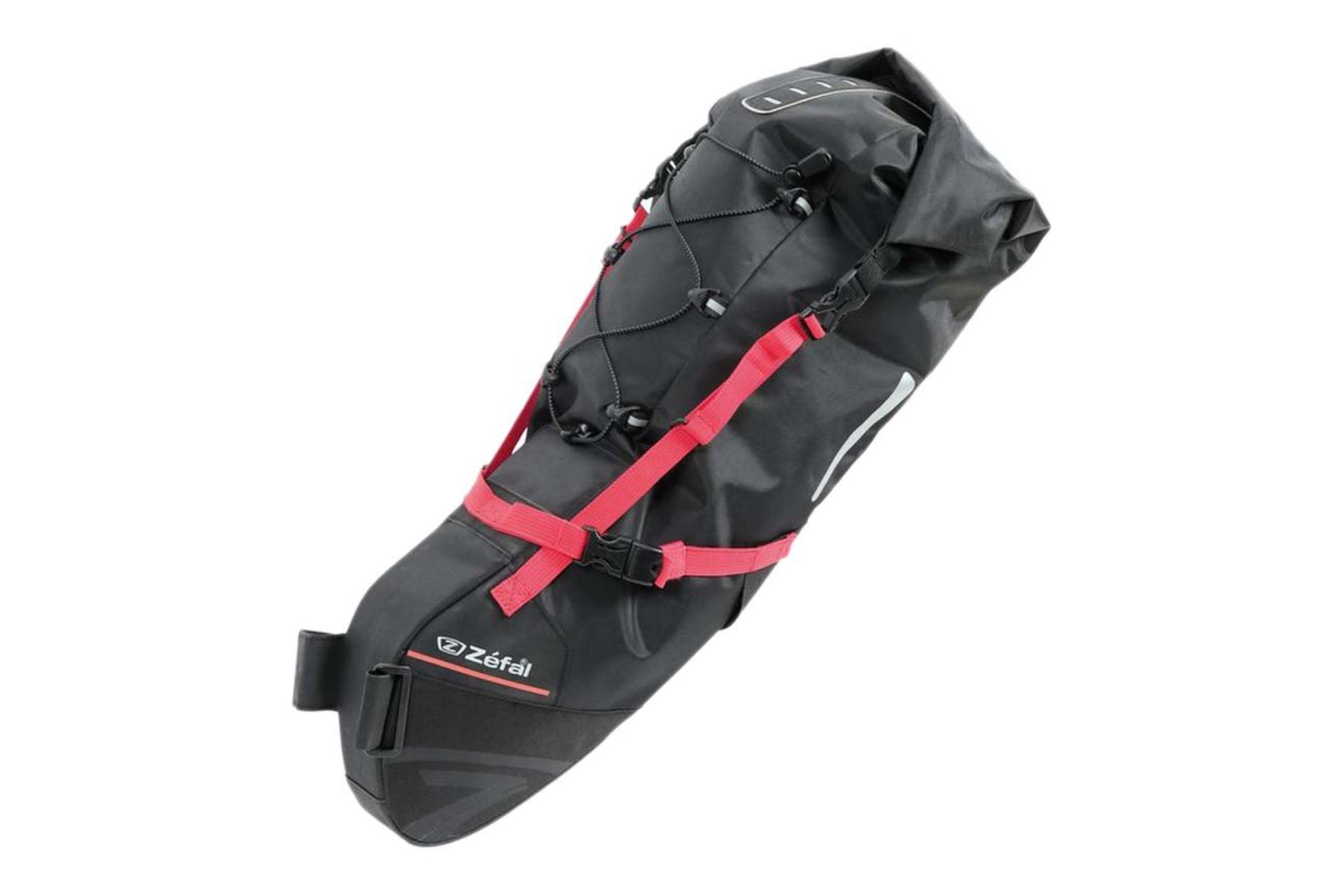
A large capacity is pretty much the number one thing to look for in a saddle bag. As they tend to feature a roll top closure, there is literally no point in getting a smaller one because if you’re not bringing much, you can just roll the top down a bit further.
Another good thing to look for are some bungie straps at the top, these are so useful for keeping wet kit separate from your other things – as well as storing snacks.
AeroPack Alloy
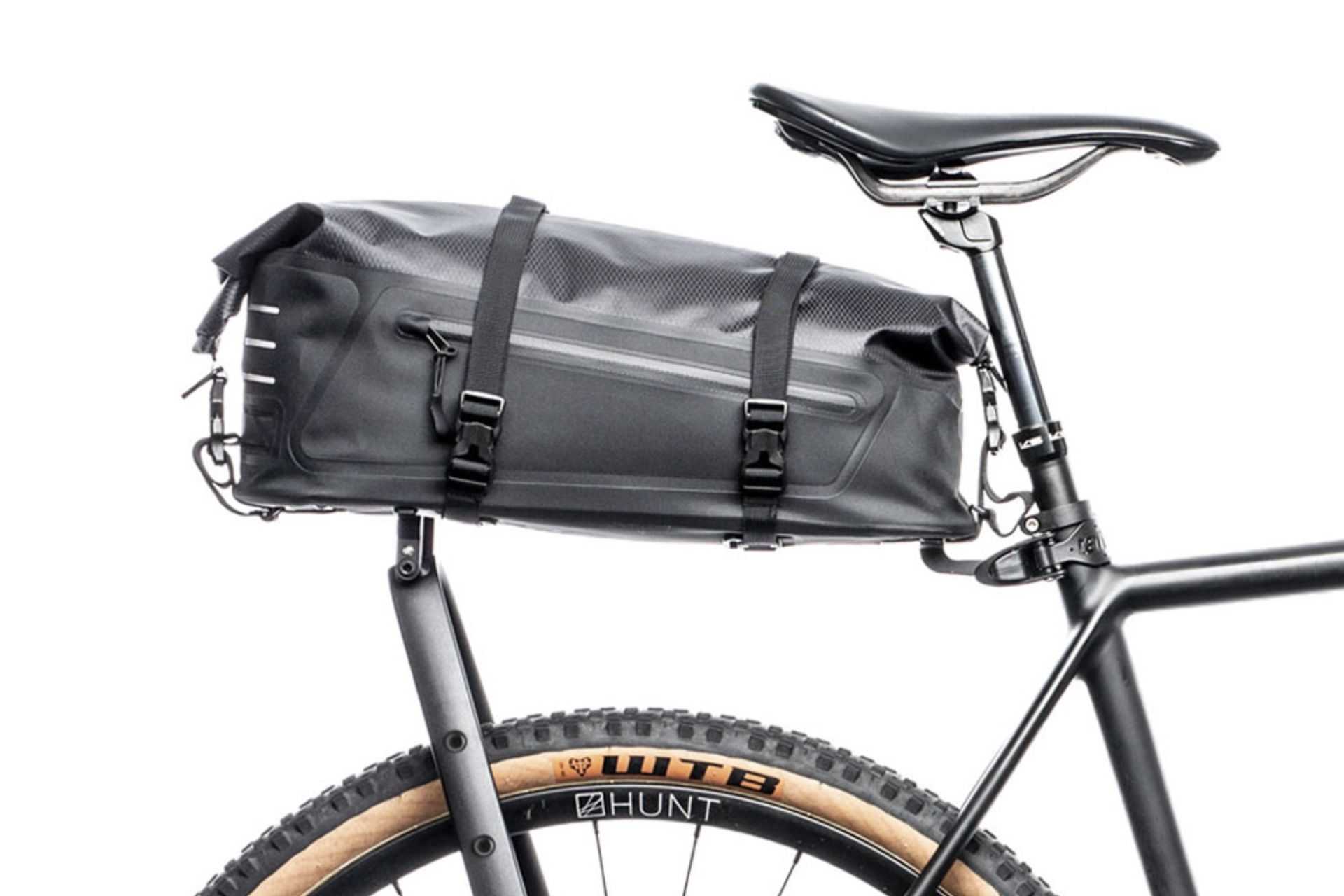
This might cost a lot more upfront, but we think it is absolutely worth the investment. Unlike a traditional giant saddle bag, it doesn’t sway, it has a far greater capacity, and it’s better able to cope with heavy loads. The large closure system also makes it so much easier to access your things.
Considering the extent of the capacity, the price is actually quite competitive against all the other bags you’d need to match it.
There are so many little features and aspects to this system, you should really read the review to get the full picture of why we think this is so great.
USA view item: Tailfin AeroPack Alloy at Tailfin from $283.00
UK View item: Tailfin AeroPack Alloy at Tailfin from £189.00
Helicopter tape
It’s very easy to scuff your frame with bike bag straps rubbing against it all day. Particularly with carbon frames, you can permanently damage the tubing by riding through the wrong conditions.
So before strapping bags to your bike, it’s a good idea to add some helicopter tape underneath where you’ll be attaching them. It’s completely clear and will help protect your bike.
Bike Shield Full Pack Frame Protection Set

There’s a quite a few different brands you can go for, this one is not too expensive but will do the job well.
Tool keg / downtube bottle cage
You’re going to need somewhere to store your tools and spares. In the saddlebag won’t work as heavy things have to be stored at the bottom and you need quick access. A handlebar bag with a side roll entry has similar issues with accessibility.
You could use a frame or top tube bag, but that’s not ideal if you don’t want to have your knees rubbing on bags – and if you’re camping that space will be all used up anyway.
The best place to keep your tools and spares is in a bottle-shaped keg stored in a cage on the underside of the downtube. This keeps the centre of gravity low, while also keeping the tools highly accessible.
Topeak Cagepack XL Bag
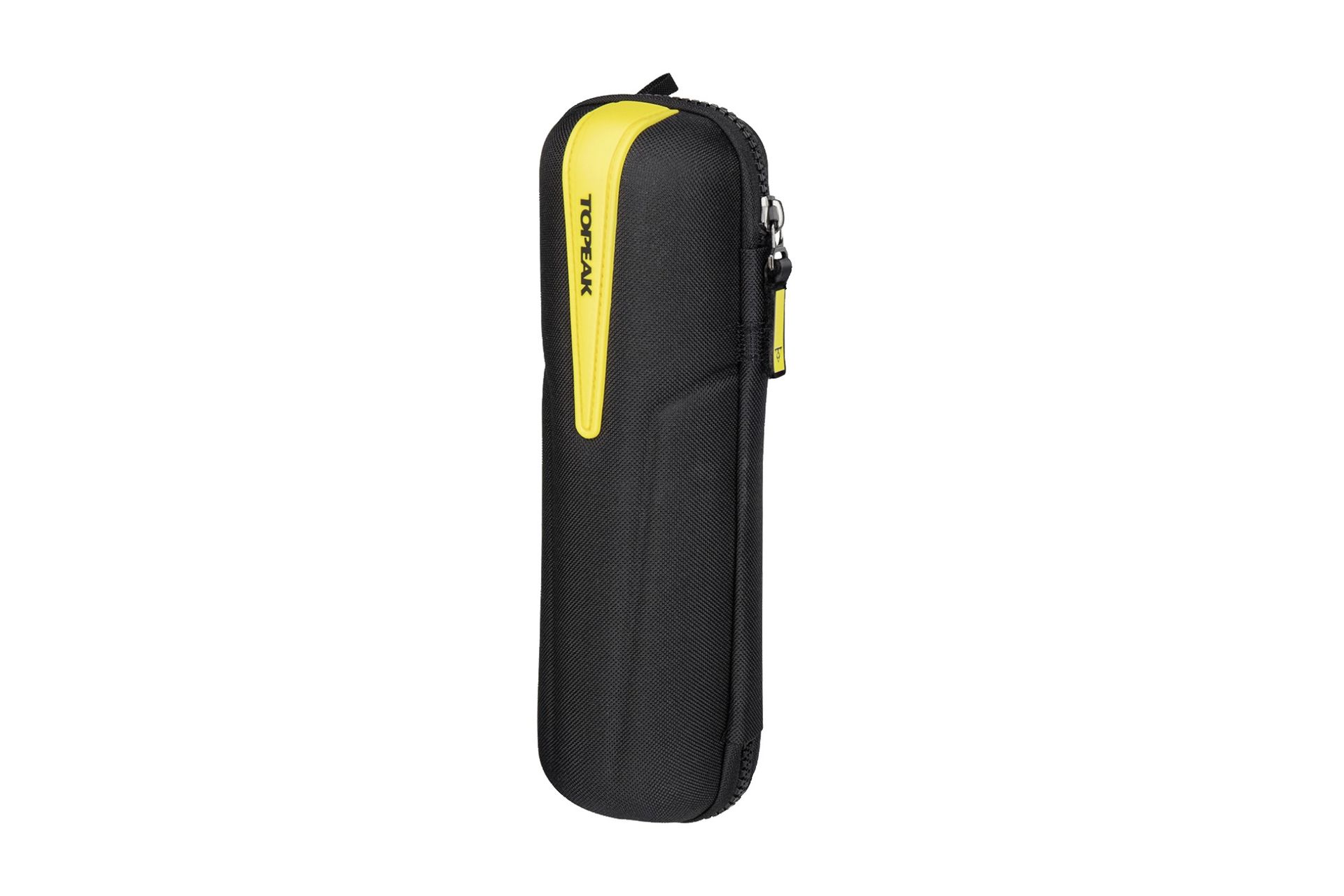
The longer you’re riding for, the greater the chance of mechanicals. You’re also more likely to experience a broader range of mechanicals, and so will need a matching range of tools and spares.
This becomes doubly important if you’re planning on cycling off to somewhere quite remote, but also, your life is made far easier when you’re not having to cram things so tightly in.
Topeak Ninja Cage
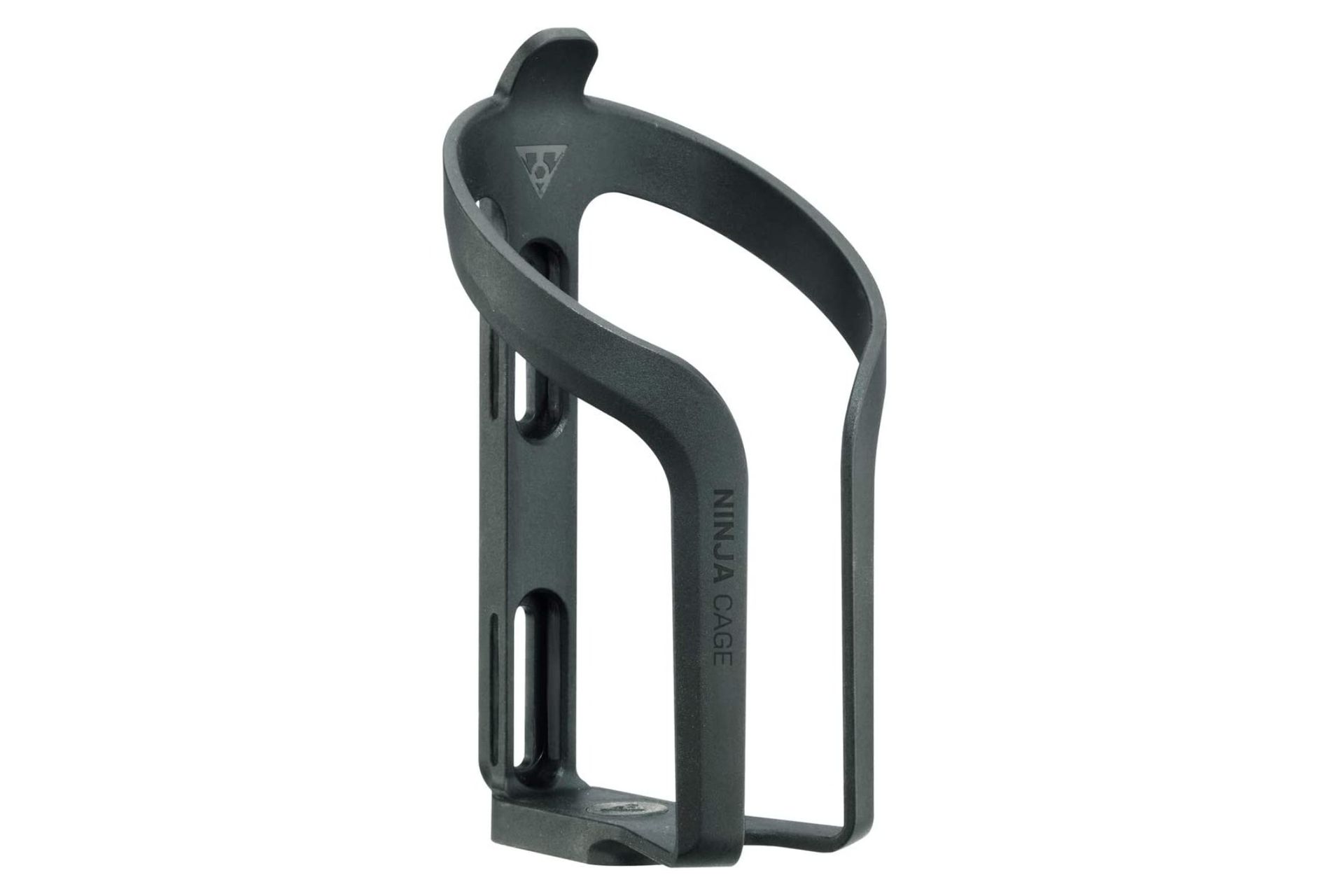
If you don’t have a bike with downtube bottle bosses in this location, that’s not necessarily a problem.
This bottle cage from Topeak can be strapped on anywhere with a couple of cable ties. Just make sure to use some beefy ones and to protect the area by wrapping it in heli-tape before strapping on the cage.
Frame bag
Frame bags are very useful for keeping important items close at hand and easily accessible. They’re also particularly good for things which don’t compress very well, such as tent poles and battery packs.
You can get full frame bags that take up the entirety of the main triangle of your bike. If going for this style, you’ll need to store a water bladder either in the frame bag or handlebar bag. These are a good option for maximising the amount of luggage you can take, but they do have some downsides which make them perhaps not the best solution for most people.
Most bikes have quite differently shaped main triangles, so generally, a full frame bag will have to be custom made, which adds to the cost. Also, it’s harder to quickly see how much water you have left in a bladder and they’re more awkward to fill up than a couple of bottles.
Some people do much prefer a full frame bag, but for most people, a half frame bag will be the optimal choice.
BBB Middle Mate BSB-142 Frame Bag
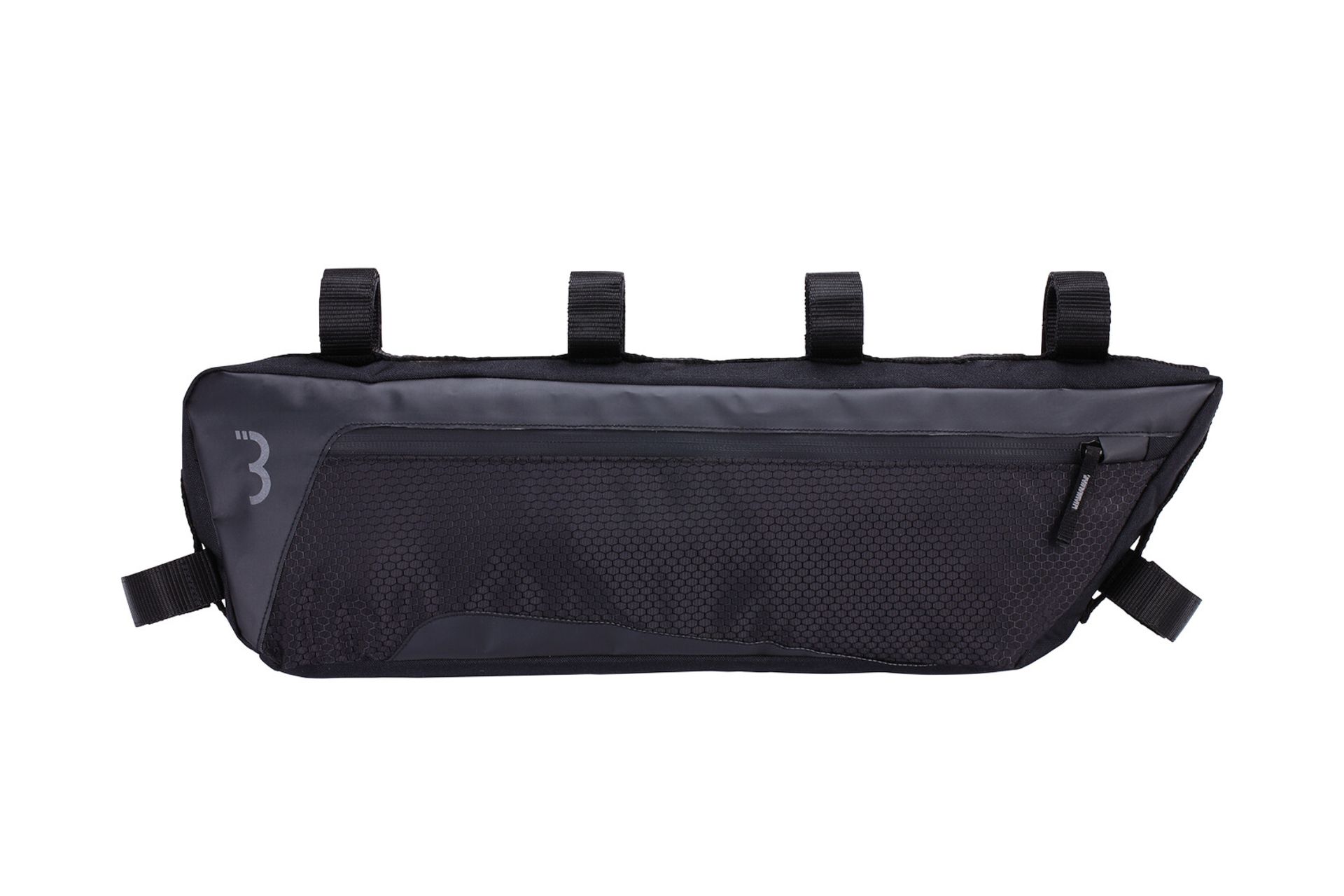
A frame bag with a middle divider can be useful when it comes to keeping things organised and not losing anything in there. This one fairly large, and so is great value for its size – a great option for expanding your on-the-bike storage options on a budget.
Apidura Expedition Frame Pack
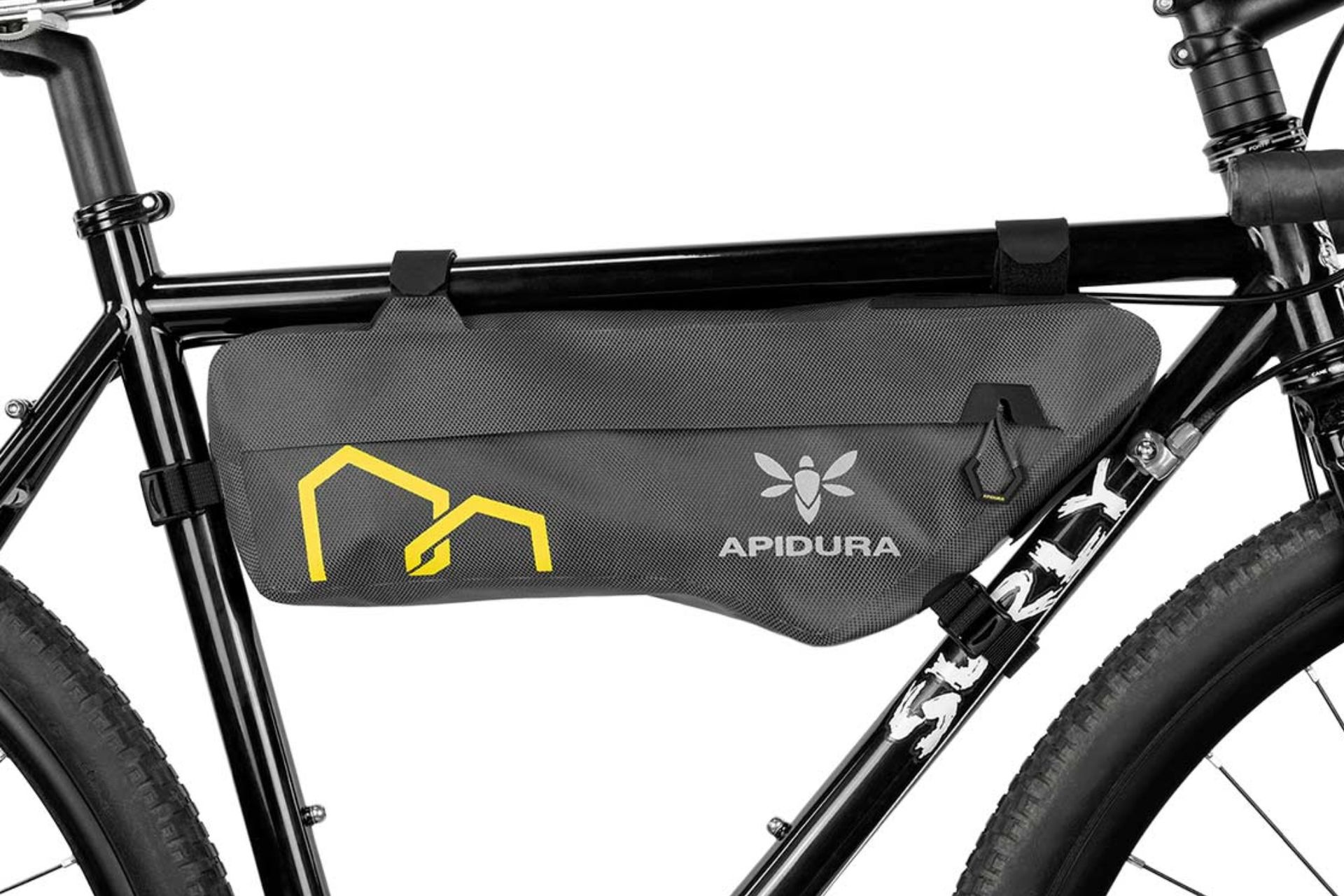
Apidura was one of the first brands to really start producing bikepacking specific bags and so its products are very well tried and tested. This half frame bag is pretty huge and a great option if you’re planning on sleeping under the stars.
Top tube bag
Just as with frame bags, top tube bags are great for valuables, food and things that don’t like being compressed.
LifeLine Adventure Top Tube Bag
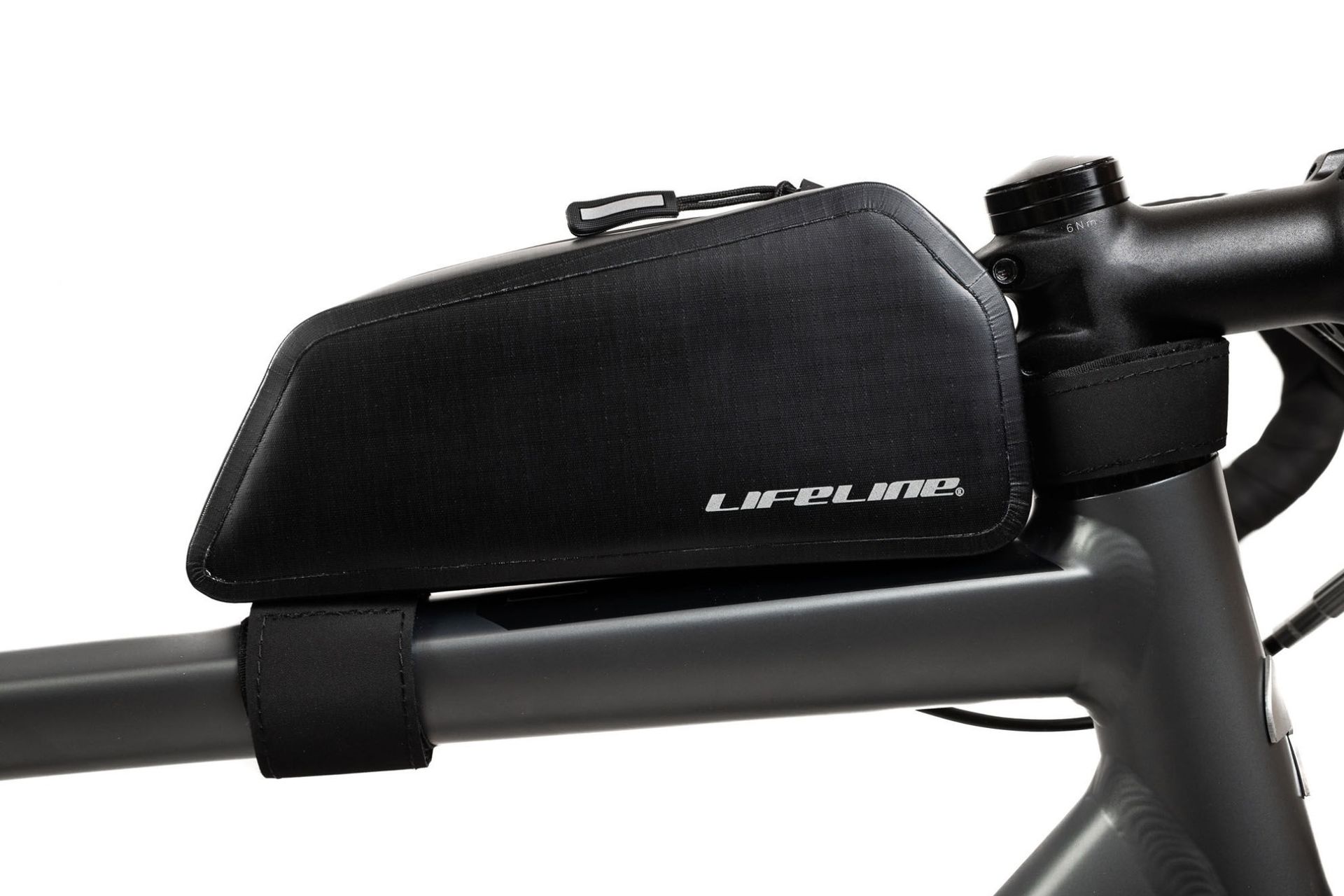
Admittedly, this one is quite small, but the cost is low enough that buying two and attaching the second one symmetrically to the seatpost and top tube is a viable option and (obviously) doubles capacity.
Apidura Racing Long Top Tube Pack

If you’re getting yourself a top tube bag, you may as well go the whole hog and utilise the entire top tube. Although quite expensive, when you factor in how much capacity this is adding, it’s not a bad deal.
Stem bag
These are really handy for keeping snacks and other things close at hand, thereby also freeing up the frame bag for carrying other items, such as tent poles.
BBB Bar Buddy Handlebar Pack Bag
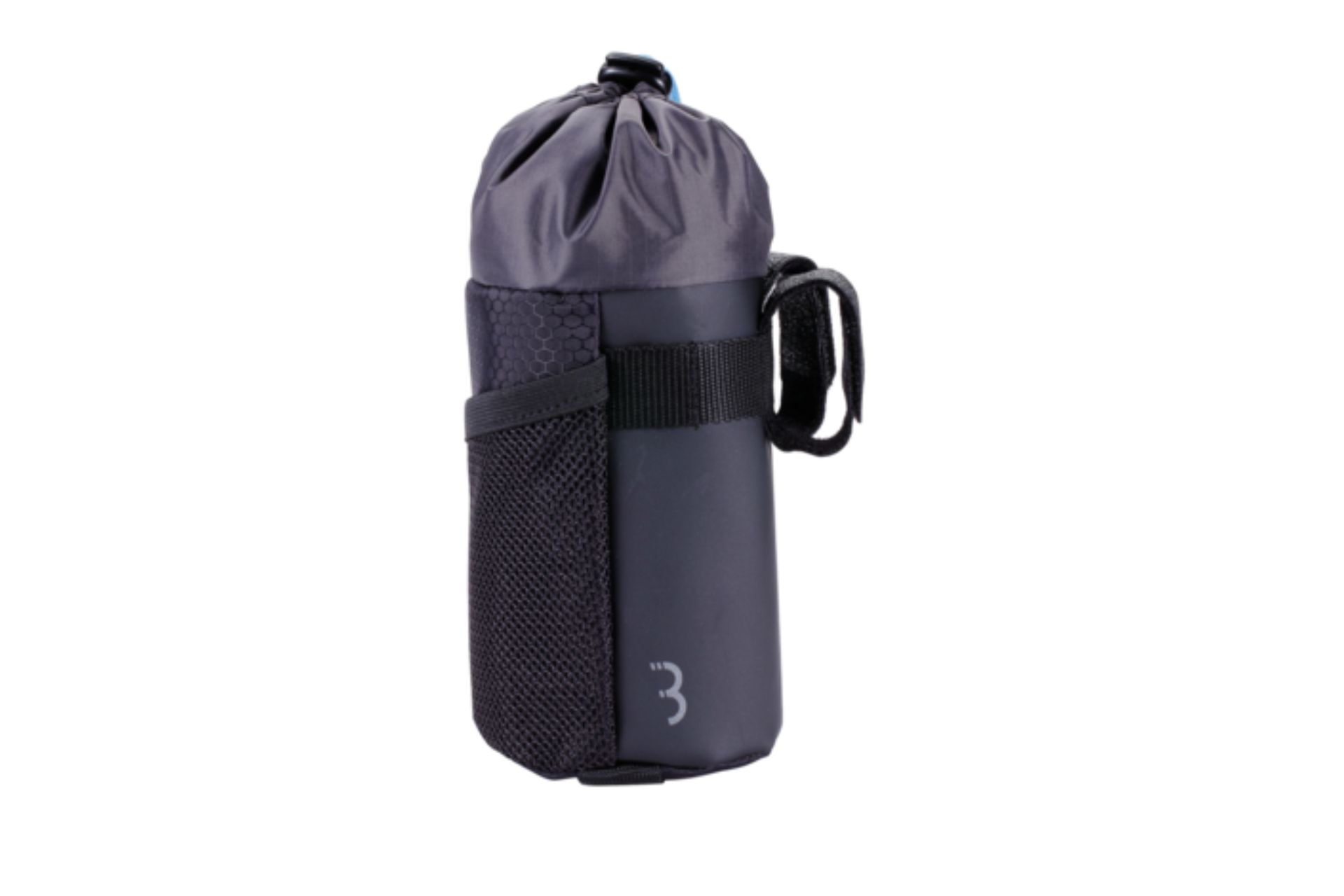
This one isn’t overly expensive and has the nice touch of a mesh pocket on the outside, helping to help your wrappers separate from the rest of the contents.
Panniers*
Although not as trendy as a set of bikepacking bags, you shouldn’t rule out a rack and panniers from your luggage bearing options.
You can pick up a set for not too much money and end up with even more storage space than a full set of bikepacking bags. They also tend to be a little easier to pack and unpack than bikepacking bags too.
We’d still recommend taking along a handlebar, top tube or any one of that style of bags in addition though. It really helps to have a bag you can access easily while still riding.
LifeLine Adventure Waterproof Pannier Bag
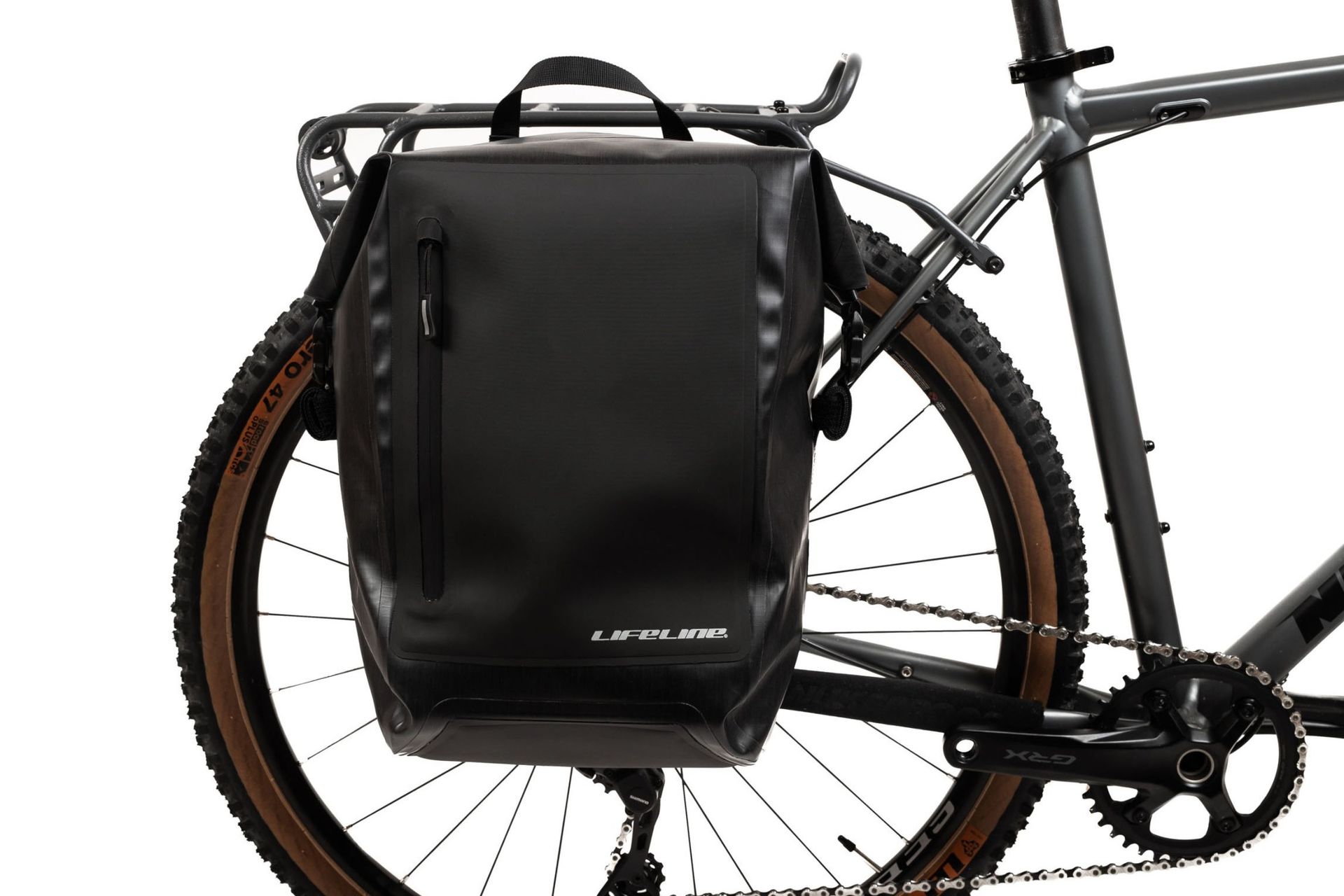
A fairly simplistic design, but with a sturdy and waterproof construction and quite a low price, you couldn’t really ask for more.
Ortlieb Back-Roller Pro Plus
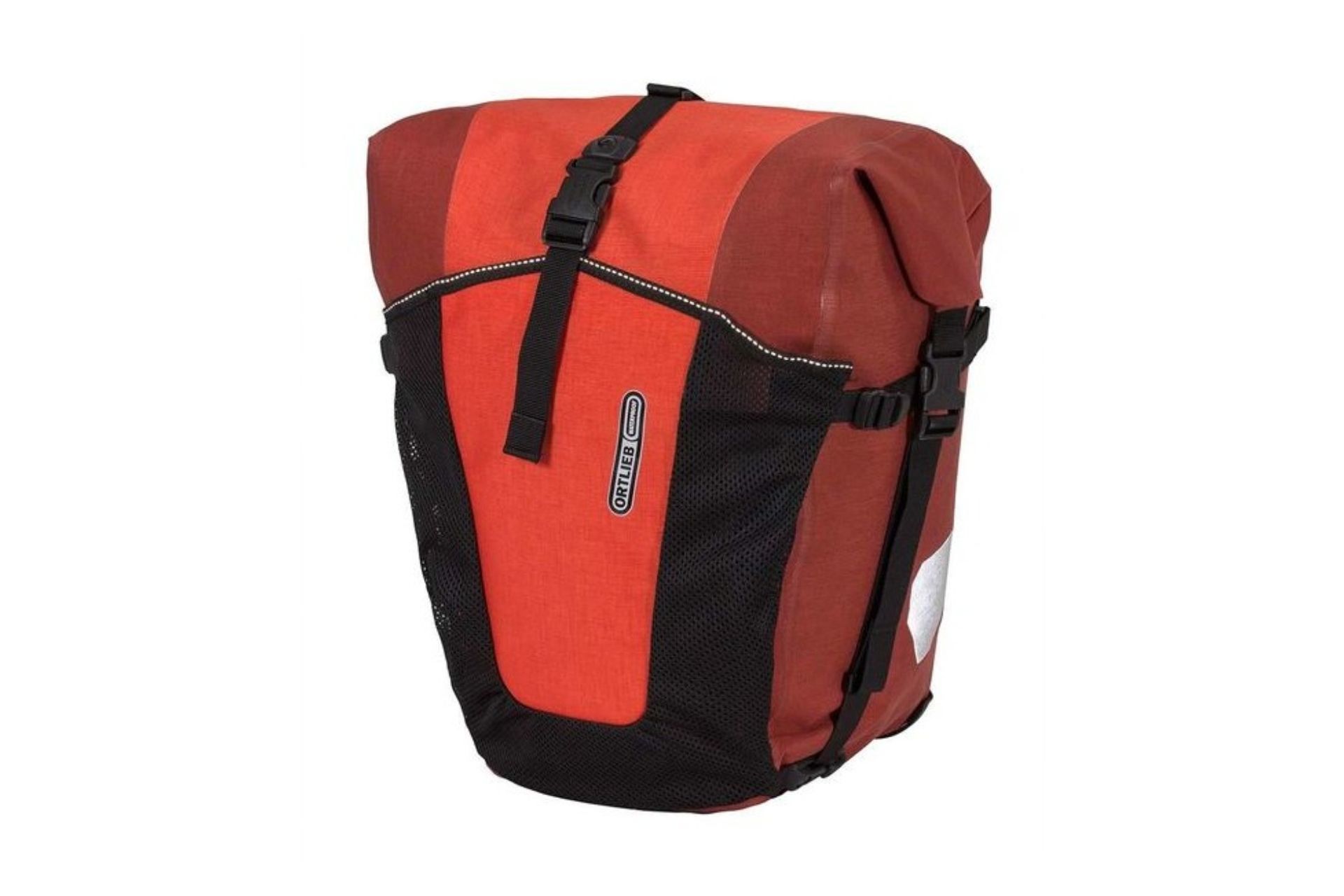
These are the ultimate pannier bags. Ortlieb has produced bags that have gone on to be taken around the world by countless numbers of people. They are super robust, easy to use, and with loads of handy little features which just make these bags a pleasure to use.
The main benefits are: the large size, compression straps, external pocket for waterproofs, internal divider, easy to take off the bike and the ability to wear them as a shoulder bag.
Rack*
Unlike bikepacking bags, you do need to attach a rack to fit a set of panniers. Fortunately, most bikes that you would wish to go bike packing on do come with mounts for these.
You can also get front racks to even further increase your carrying capacity, but that’s likely overkill for any trip a week or shorter.
Tortec Tour Ultralite Rear Rack
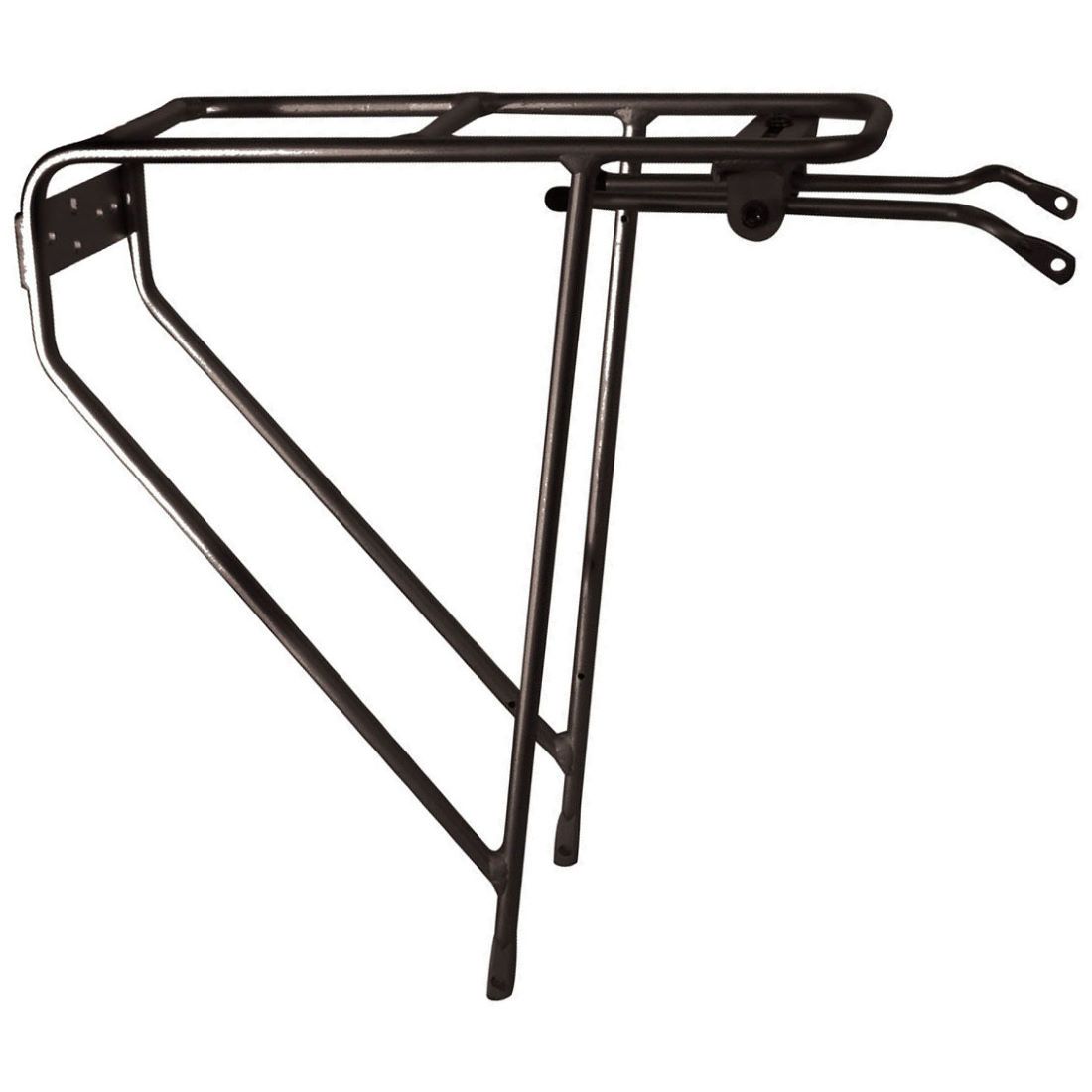
Quite cheap, quite light, stylish minimalist looks – but can still take a maximum load of 25kg. It’s pretty impressive in all and a good choice for most people.
Tubus Grand Tour Rear Rack
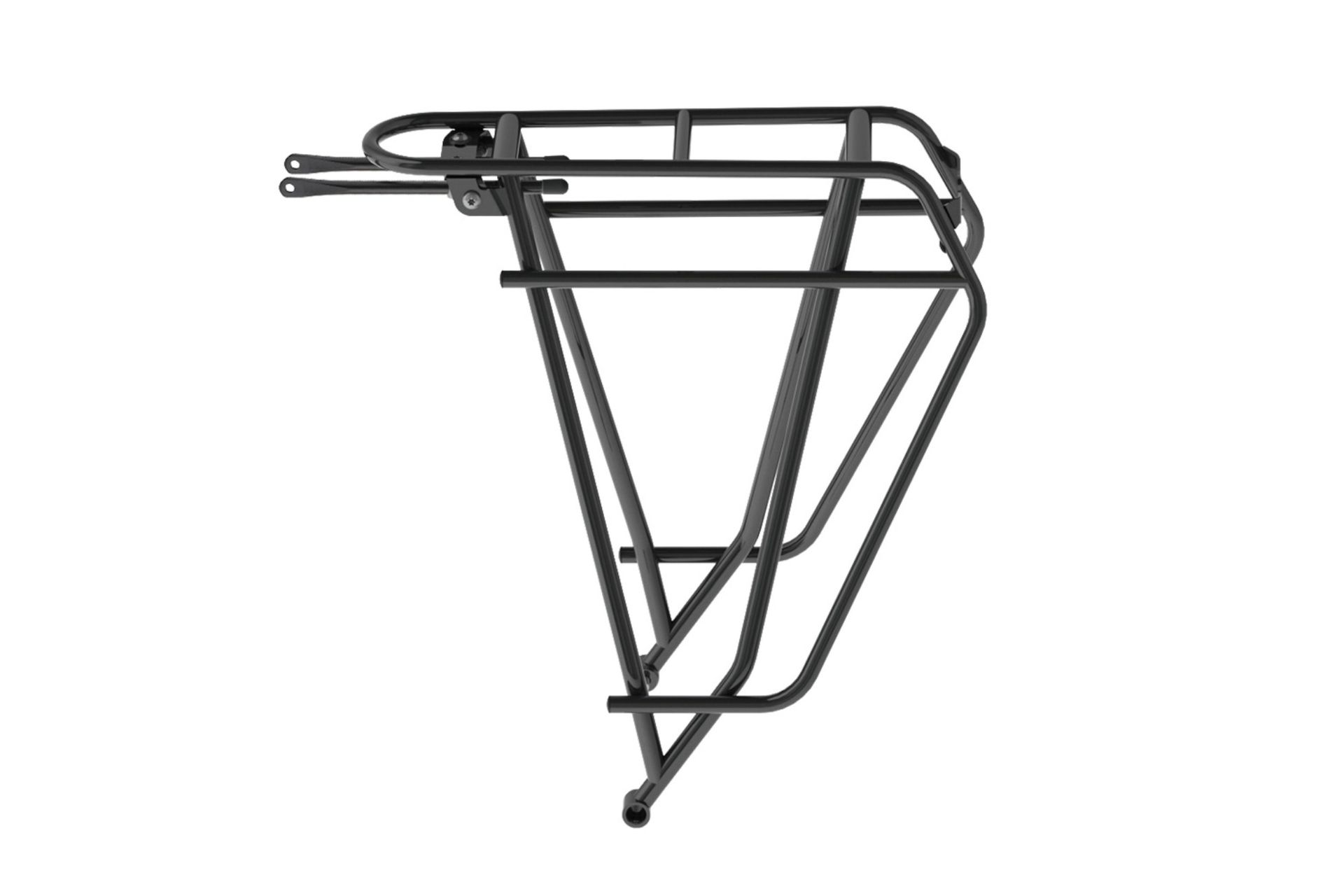
If you want a rack worthy of your Ortlieb panniers, this is the one to get. Tubus are very well known for their excellent racks and this one will happily accompany you around the world.
A very nice touch is the extra bar for mounting your panniers a little further down. This lowers the centre of gravity and makes your bike a little more stable to ride.
Camping gear
Despite all the imagery of tents pitched by lakes, if you’re just dipping your toes in the bikepacking world, there’s nothing wrong with sticking to other accommodation than camping.
If you don’t already own the necessary gear, buying a full set can add up to quite an expense – and then you need to factor in the price of more bikepacking bags to carry it all.
But if you’re ready to take the plunge and spend some nights out under the stars, here’s the kit that you’ll be needing.
Sleeping mattress
An inflatable sleeping mat is generally best for bikepacking, being much less bulky and generally lighter weight than a foam mat. There is the potential chance of punctures, but we don’t find that’s usually an issue.
As an aside, making sure you have some form of pillow will help you get a much better night’s sleep. Without one, your head tips back and your mouth naturally opens, which can lead to a very dry throat in the morning. Just putting some clothes in a bag for a makeshift pillow goes a long way.
Trekology Inflatable Sleeping Pad UL50
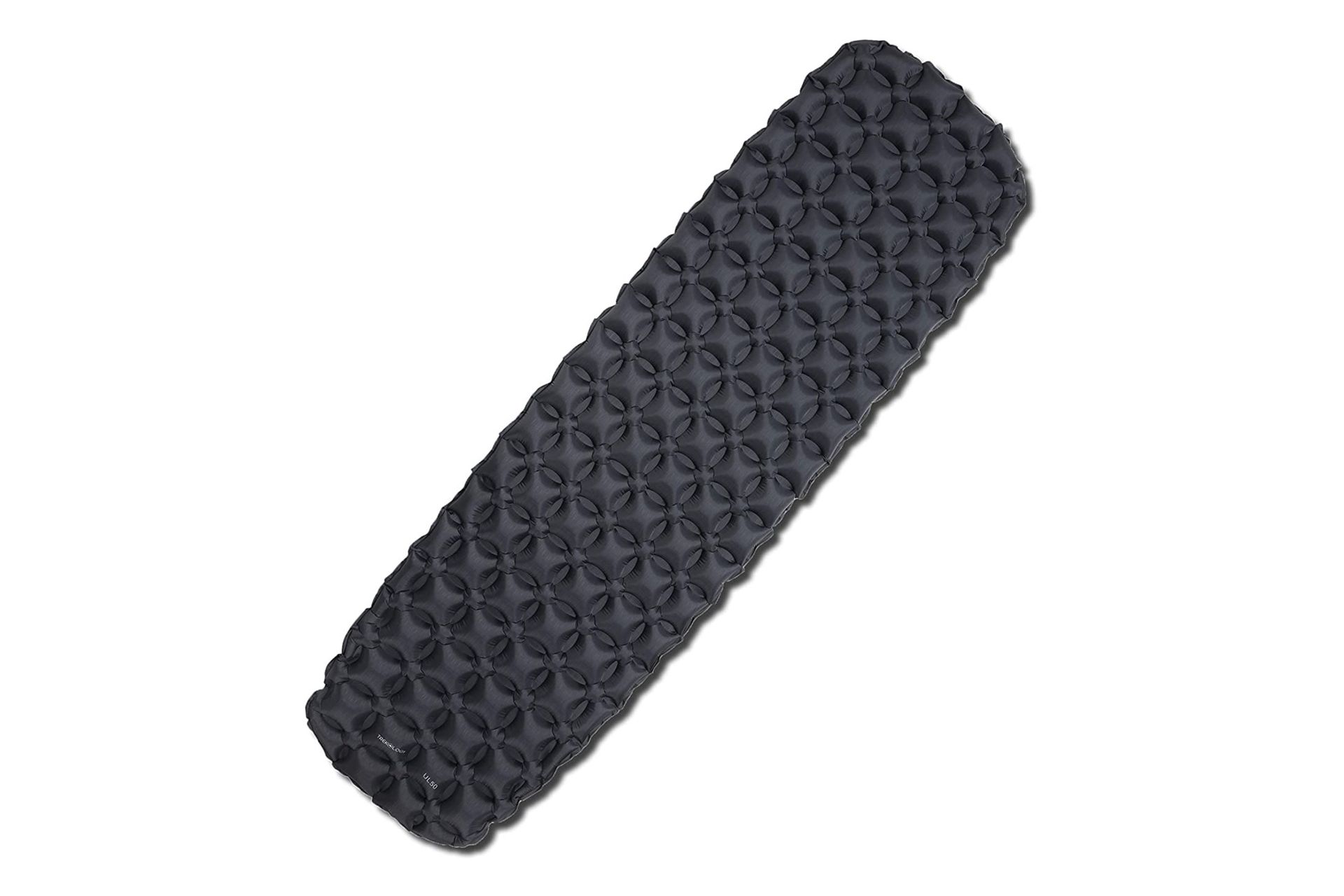
These are very good, the low profile makes it fast to inflate, generally taking about 12 breaths. We even find them more comfortable than the massive thick air mattresses you might normally take camping, you don’t lose yourself within it when you try and sit up.
It’s not much heavier than the more expensive options and in our experience, we’ve found they shape up to be quite reliable, so this is an area it can be quite worthwhile saving on.
Sea To Summit UltraLight ASC Mat

If you do want to spend more, this one is about 12.5% lighter than the cheap ones you can get off Amazon. It’s a good choice and it’s nice to have the reassurance that if anything does go wrong, it’s a lot easier to sort things out than with a seller halfway across the world.
Sleeping bag
When it comes to sleeping bags, there's three desirable traits: light, warm and cheap, unfortunately you only get to pick two.
If it looks like you're getting all three, you've probably stumbled across a 'summer' sleeping bag. These might work fine for a trip to France or Italy in July, but if you're in the beautiful highlands of Scotland, it's just not going to handle the night-time lows.
As with jackets, you should be looking for one with synthetic insulation rather than natural down, as it’s not going to be so badly affected by getting a bit wet – which, unfortunately, there’s always a chance of.
Vango Kanto 250 Sleeping Bag
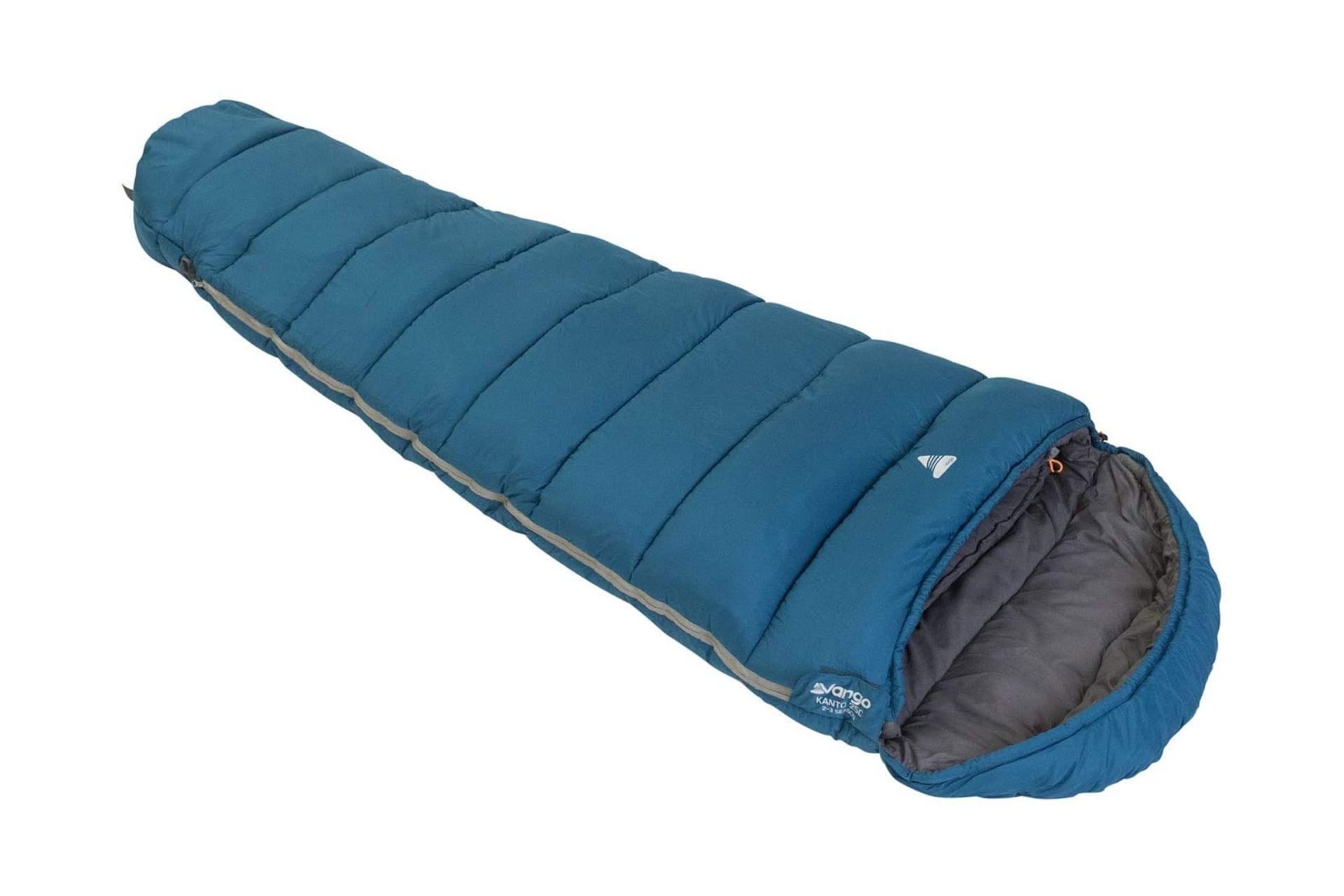
You’re a lot better off bringing a sleeping bag that’s slightly too warm and just unzipping it, rather than shivering through the night. This one is a good balance between insulation and size. But you don’t need to just take our word for it – apparently this model is also recommended by the UK Scout Association.
Rab Solar 3 Sleeping Bag
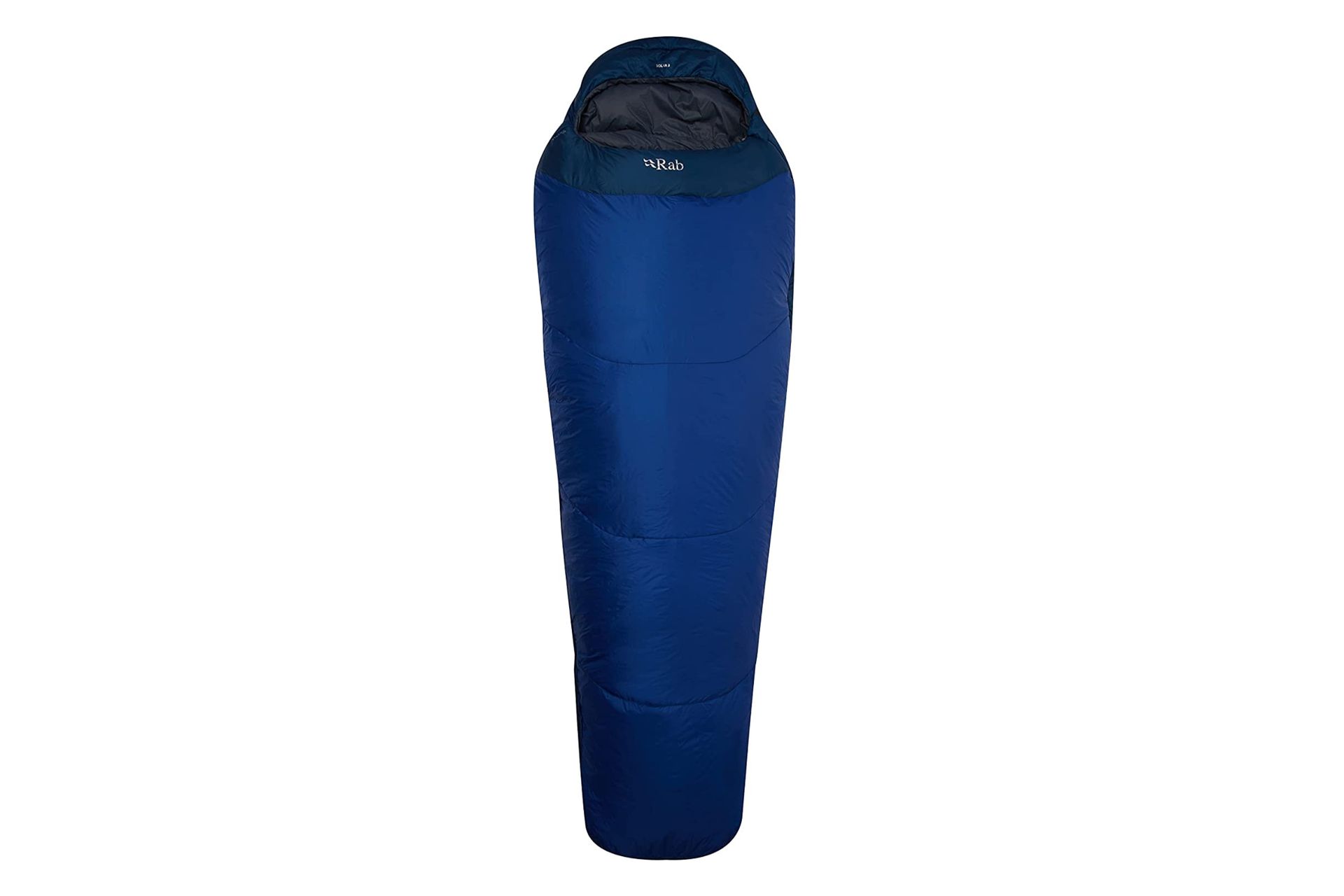
If you spend more money, you save on weight and bulk. In the regular length, this comes in at just over a kilo, but still will keep you warm at night.
Its stuff sack also has compression straps, which really do help when it comes to packing it down.
Ground sheet / bivvy bag
A bivvy bag is a waterproof shell you put around your sleeping bag and removes the need for a tent. For a solo rider, and even as a group, this is the lightest and least bulky way to spend the night outdoors. It’s also a lot quicker to set up than pitching a tent.
But if you take the route of the bivvy, you’ll also need to pick up a ground sheet, so you don’t puncture your sleeping mat on some thorns or rocks.
GeerTop Ultralight Camping Mat Waterproof Tent Tarp
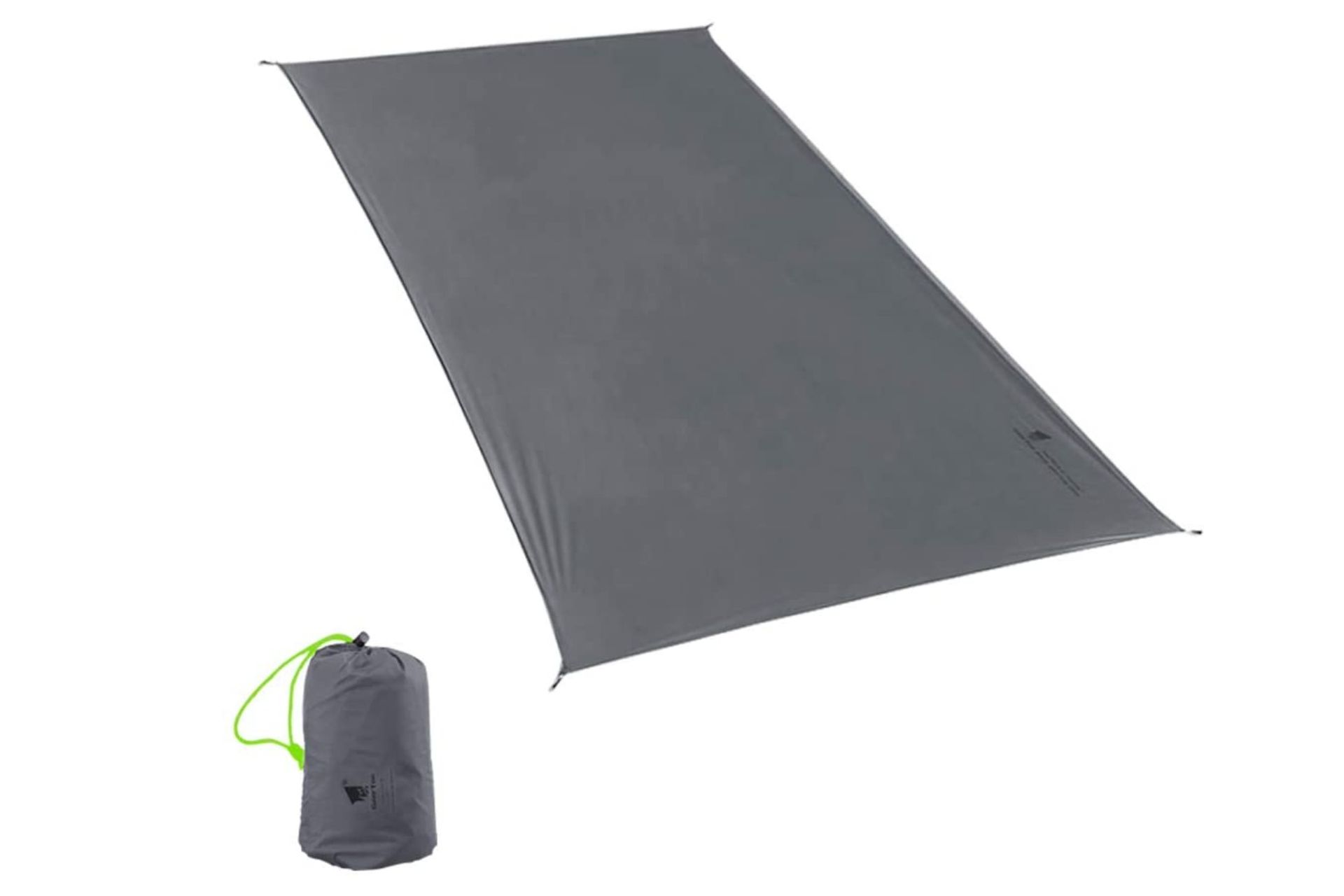
Not the catchiest of names, but it does speak to the versality of this great little piece of kit. You can use it for so many different things – beyond just being a ground sheet for your sleeping bag.
You could bring a hammock and use this to provide some shelter, with a bit of rope. Or you could use it as a lightweight picnic blanket, your imagination is limit.
MSR Pro Bivy
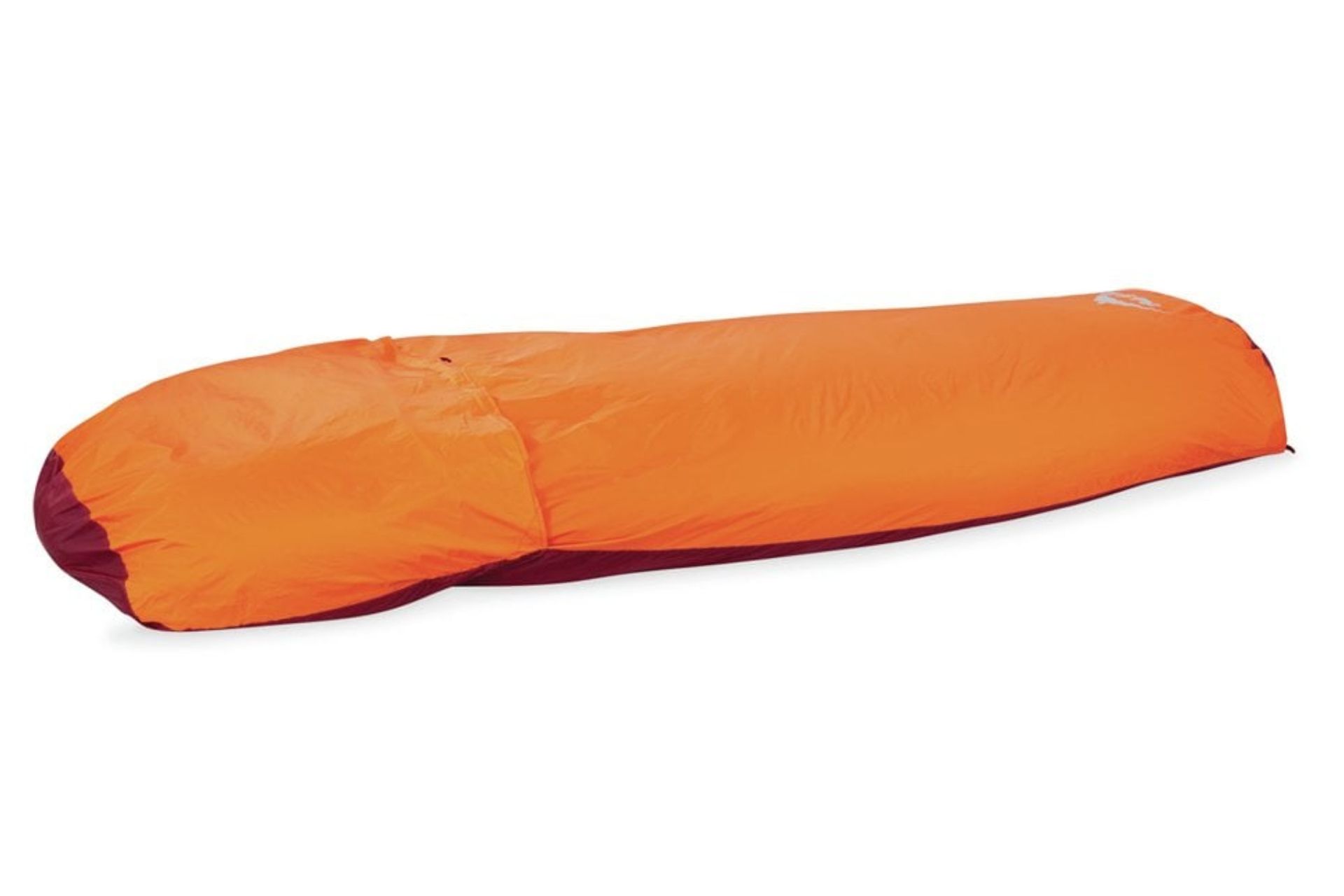
It really helps to get a bivvy bag which has an overlapping hood or a zip closure. Otherwise, your face gets eaten alive by bugs and hit by rain. Pulling the drawcords of a hood tight only does so much – and it's not a lot.
Tent
Opting for a tent over a bivvy bag adds quite a lot of weight and bulk. But going for a 3-person tent over a 1- or 2-person one doesn’t add much of an extra increase.
So, if you’ve made the decision to go for a tent, you really might as well get a fairly large one which will be nicer and easier to use – it really makes a big difference to not be feeling all cramped.
MSR FreeLite 3 Person Tent
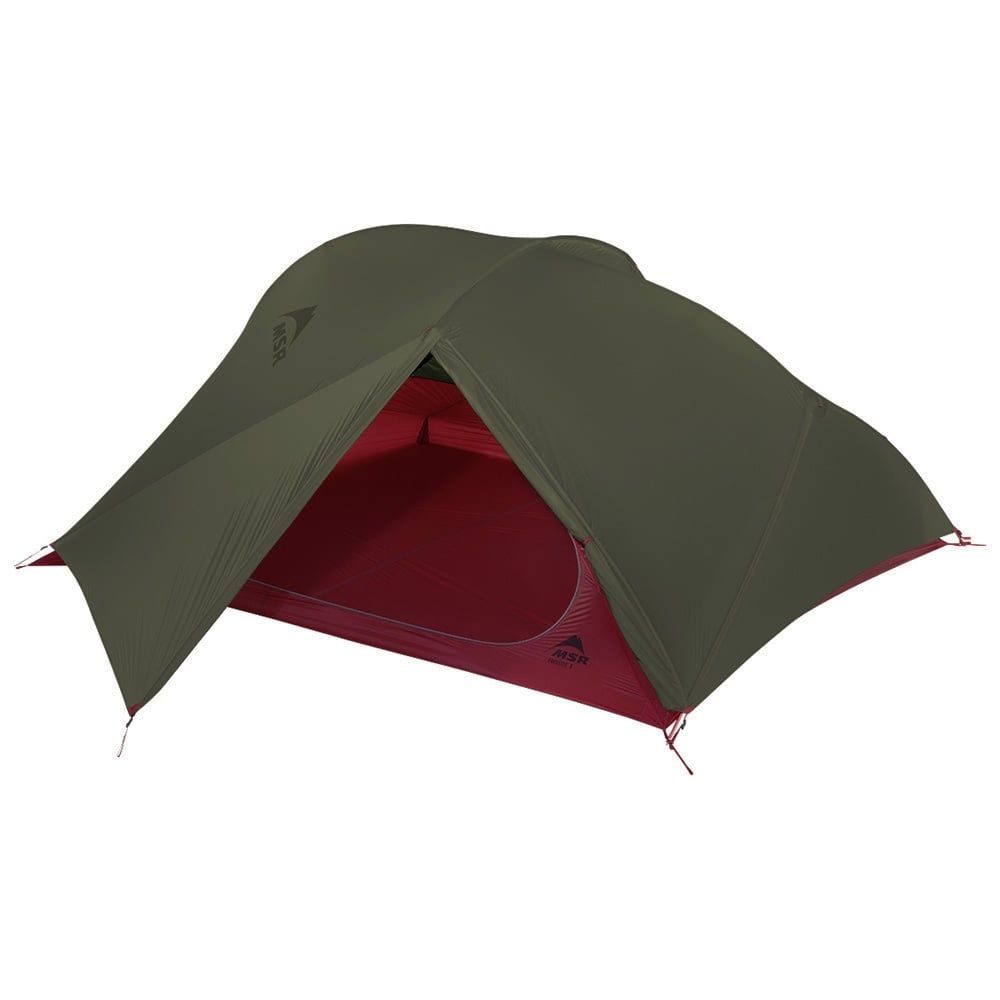
Weighing a claimed 1,368g, this is one of the lightest tents out there for the size. It’s got an out-front porch, which really helps with keeping your shoes and kit dry and safe.
Also, with the waterproof outer being a separate piece, you can leave this off if the evening is warm, so that the tent doesn’t get too hot and stuffy.
Camping stove
There is a whole, massive world to get into when it comes to camping stoves, with so many different types being best for different applications.
If you’re going on a very long-distance trip into a very remote place, something like the MSR WhisperLite Universal Stove would probably be best – it’ll work with a huge variety of fuels and is a very versatile option.
Or you could go really back to basics with something like the Bushcraft Essentials Bushbox LF, which is a wood burning stove that is super lightweight, compact and robust.
But for bikepacking a little closer to home, a stove that uses gas canisters are generally the simplest and lightest options.
Soto Amicus Stove and Cookset Combo
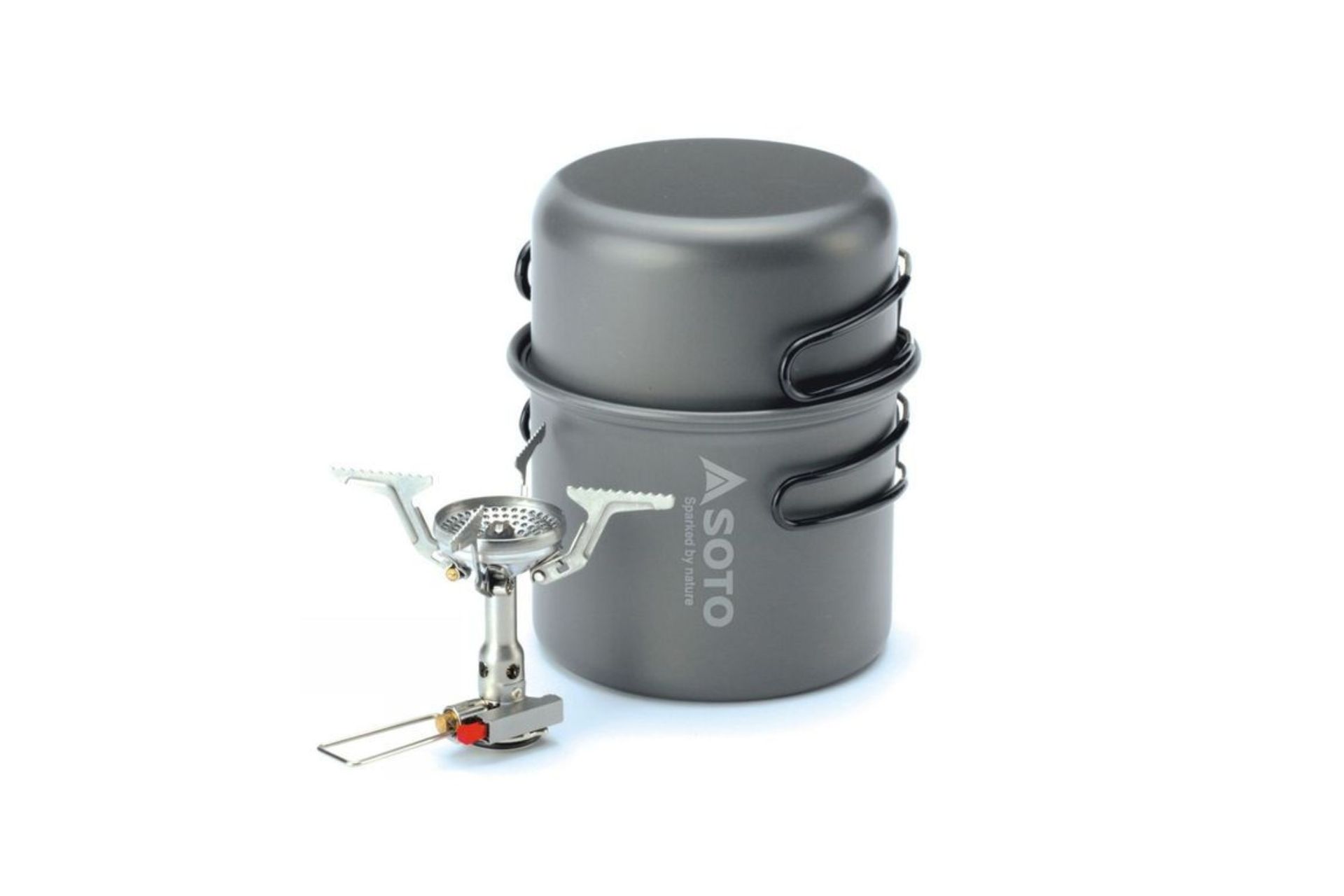
For first time buyers, it really helps to get a stove and cook set bundle, because then you know everything will pack nicely into each other.
Making sure to have two pots is really helpful too. This way it’s a little quicker and easier to make coffee and porridge in the mornings. Or in the evenings, you can get a nice curry going in one pot and have the other full of rice.
You could get yourself some packable bowls, but it’s much more efficient packing-wise to just eat out of the pots. And when it comes to cutlery, by all means buy a spork – but to be honest, just taking some from home isn’t that much heavier or bulkier and it’s a lot nicer to eat with.
H&S 10 Plates Foldable Outdoor Camping Cooker Wind Screen
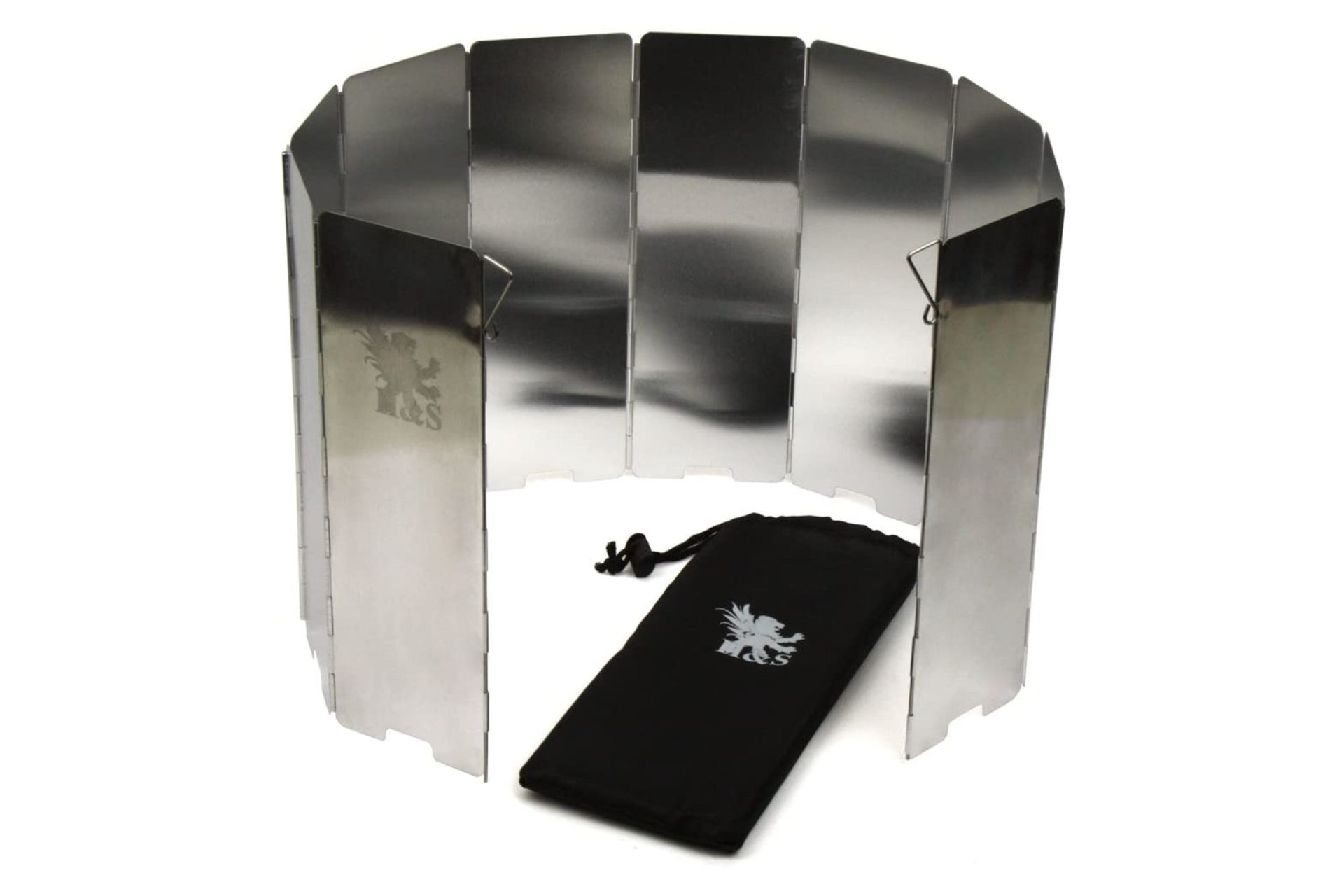
This isn’t essential, but a wind shield will ensure less heat is being wasted to the surroundings and will speed up cooking times as well as being more fuel efficient – which makes financial as well as environmental sense.
It’s not too big, heavy or costly, so it really is a worthwhile purchase – although it won’t cause you problems if you omit it.
Coffee making
AeroPress 10R11 Go Travel Coffee Maker
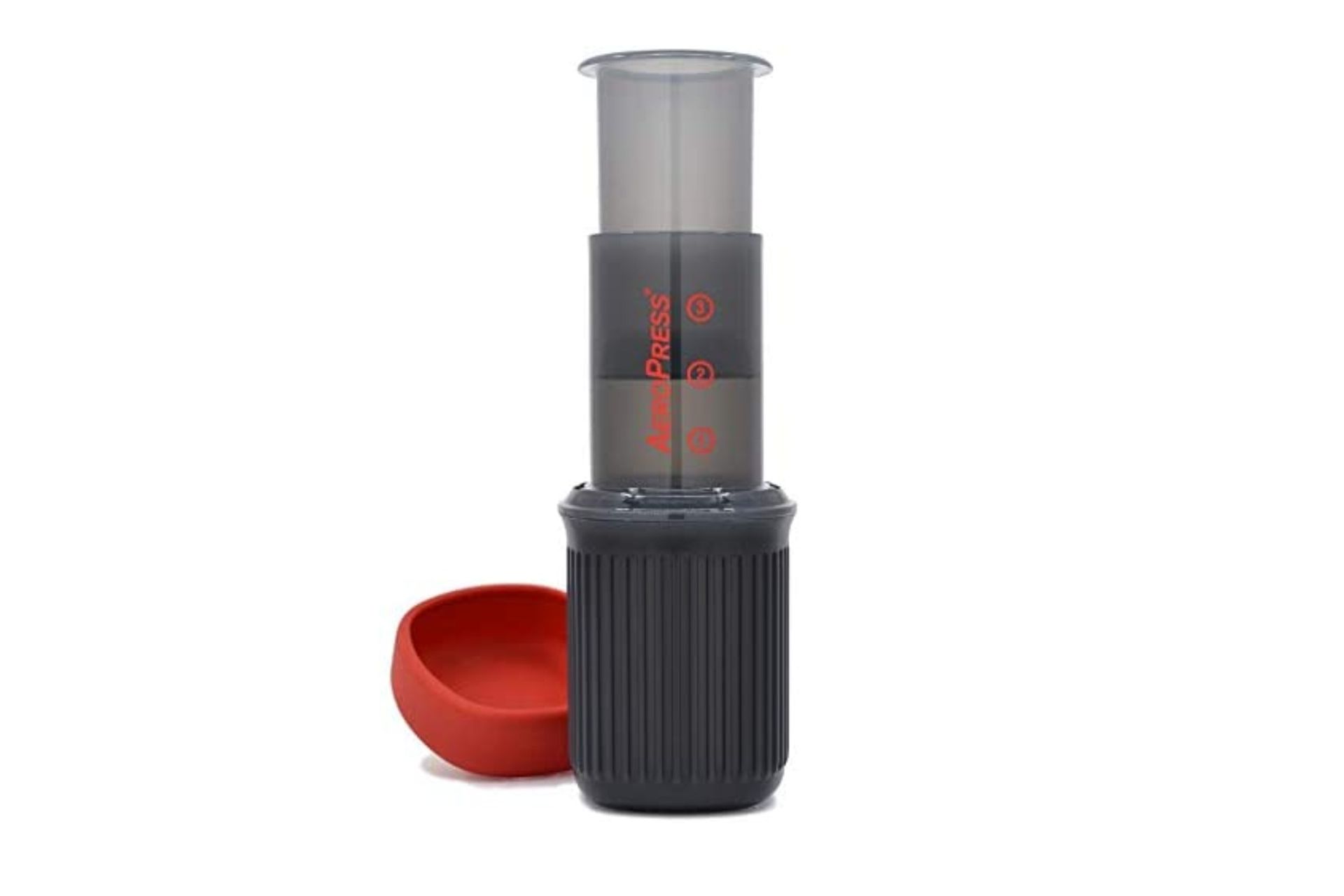
If you haven't yet tried the loveliness that is AeroPress coffee, it's well worth giving it a go with this one. It's an updated version of the original with design changes which make it more travel friendly – but also easier to use just day to day.
Personally, I prefer the more concentrated coffee from a traditional Italian moka pot. But AeroPress coffee is excellent nonetheless and I have it a lot when a moka pot is impractical for whatever reason. (Generally, in hotels, when camping, and in houses with an induction hob – my moka pot is aluminium).
Everything you need for a coffee – filters, brewing chamber, mug, scoop for the grounds – all fits in a size smaller than a 500ml water bottle, it's really perfect.
Tools and spares
Much of these you will already carry with you on everyday rides. However, with the longer distances of bikepacking – and in being a little further from home – there are some other items beyond the usual which are good to bring.
Inner tubes
A very obvious ones to start with – but an essential. Even you’re running tubeless, a bad enough cut will see it fail and you’ll need an inner tube to get yourself rolling again.
You should always take at least two (one for each wheel), but three is advisable as you might find yourself getting another puncture and being unable to patch one of the others.
LifeLine Wide Road Inner Tube
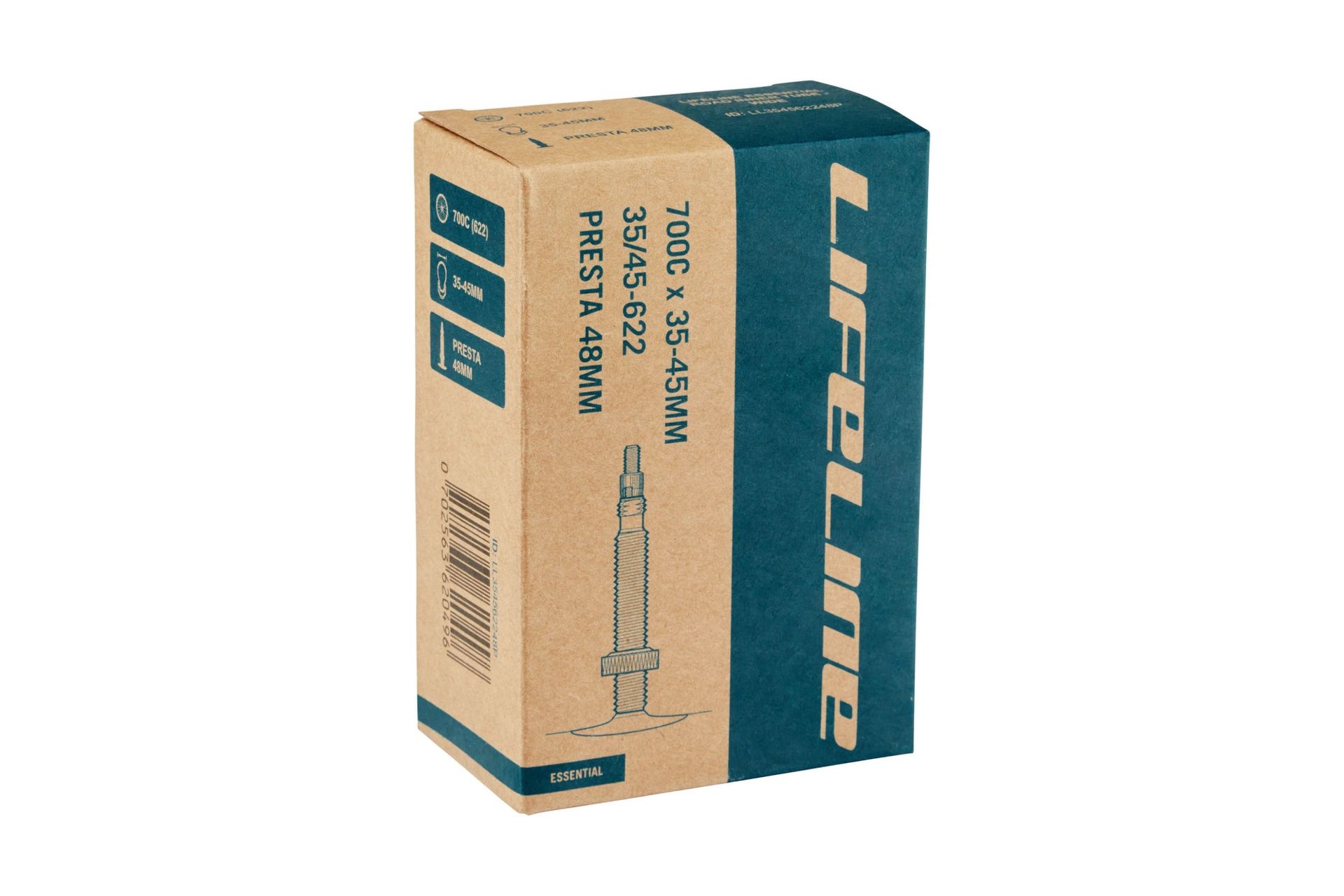
Not much to say, it's just an inner tube. This is a fairly typical size for a gravel bike which are nice to bikepack on, with their big squishy tyres offering more comfort and great off-road potential.
But if you have a standard road bike, you can still click the links and it's quick to navigate to the road ones.
Tubolito Tubo Gravel Inner Tube
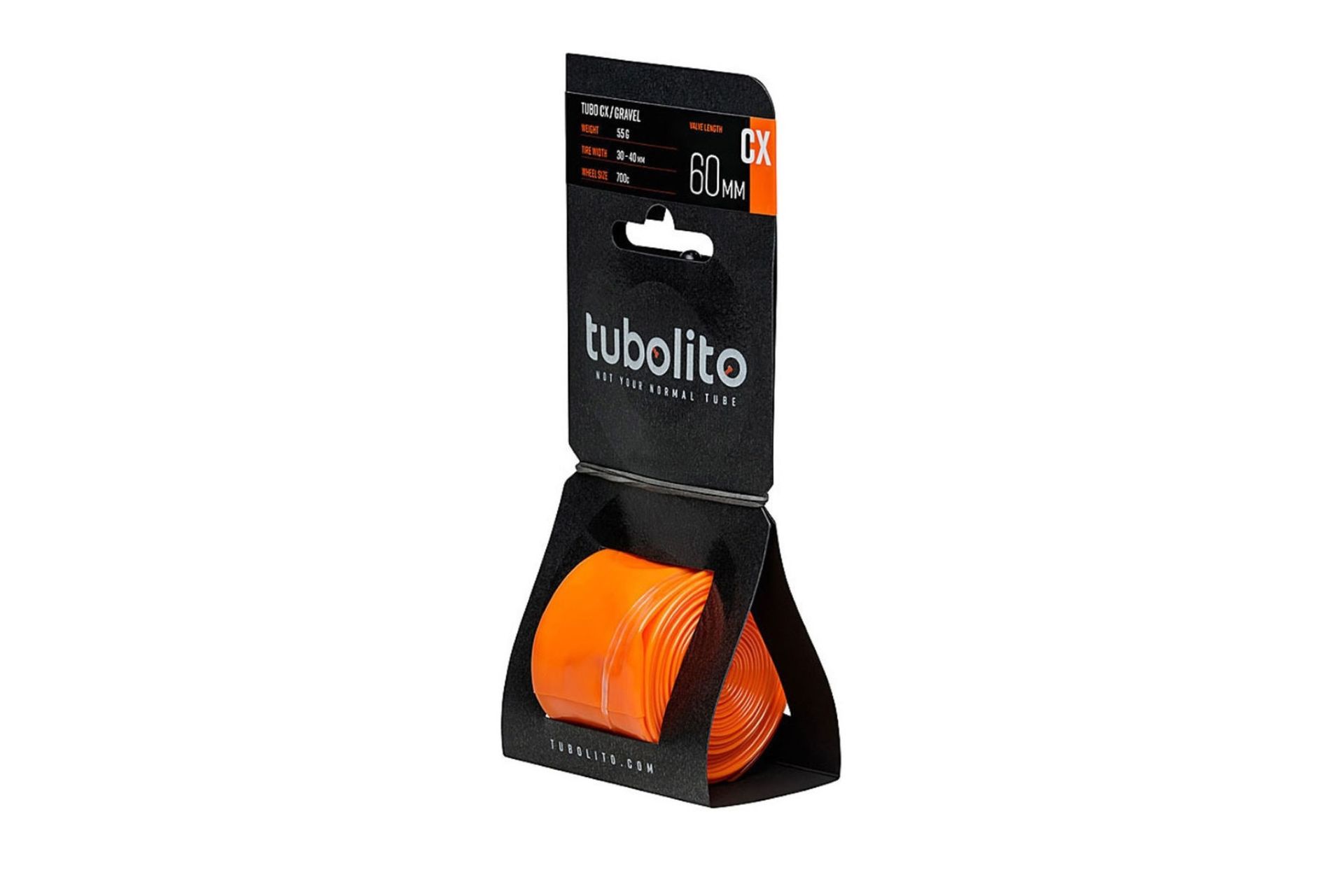
If you’re set up tubeless and not planning on using your tubes, it can be quite annoying how bulky and heavy they can be. The Tubolito tubes are a lot lighter and smaller than your standard Butyl ones – and they also claim to be more puncture resistant too.
Whether or not they do better protect you from punctures is hard to verify – but what is easily verifiable is that they are definitely smaller and lighter.
Puncture repair
Repairing a tubeless tyre can be a lot quicker than inserting a tube. And being able to patch a tube will allow you to keep on rolling no matter how unlucky you are with the punctures.
LifeLine Tubeless Repair Kit
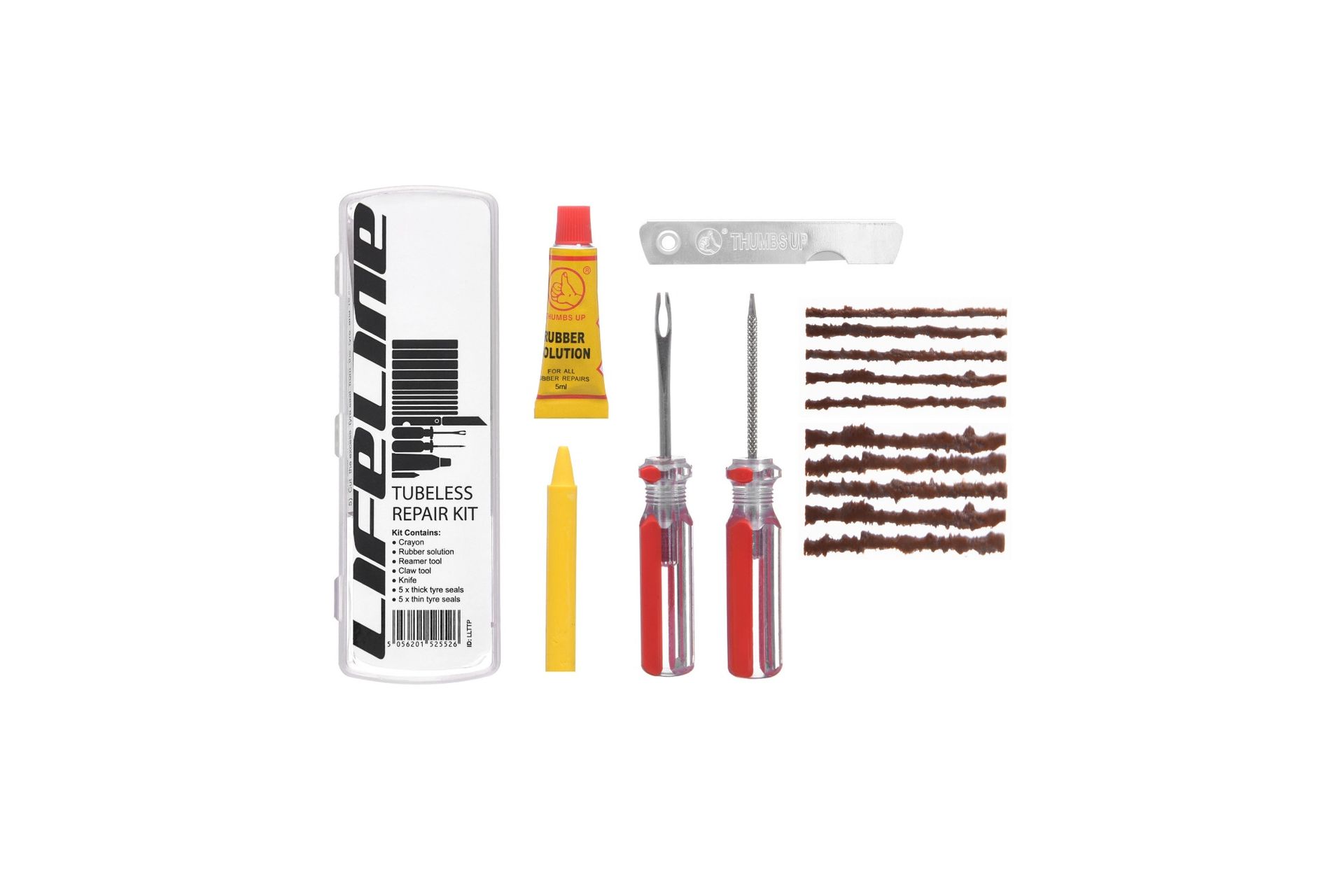
Cheap and effective. If you have a hole which the sealant just isn’t plugging, jab one of these strips into the hole and it will give the sealant something to work with.
Nukeproof Horizon Tubeless Tyre Repair Kit
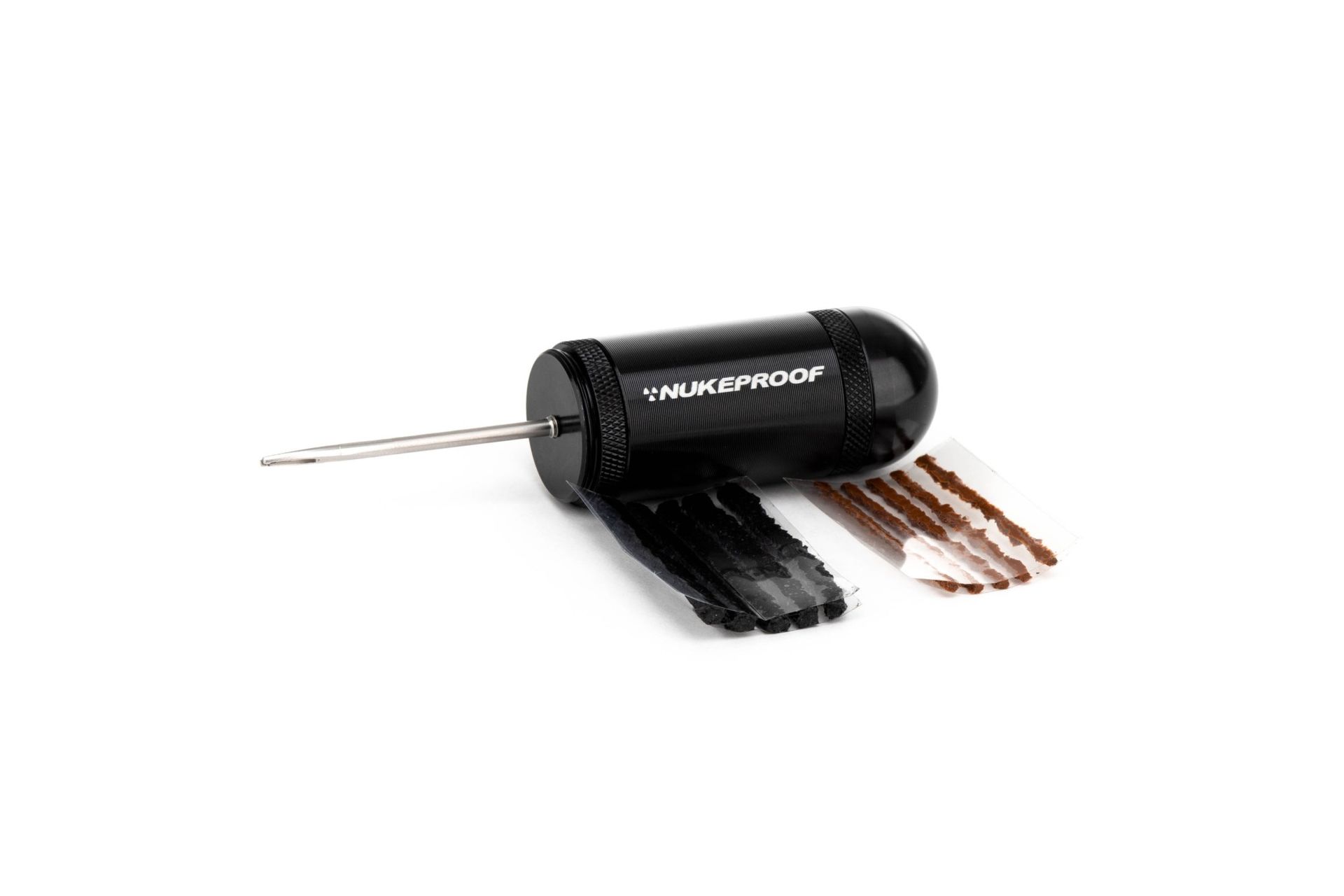
For something a little fancier – but which does the same job – this little metal pod is more compact and robust than the plastic case, making it easier to fit into your bag.
If you’ve not used one of these before, the best advice is that it takes a lot more force than you might be initially inclined to use on a lovely set of tyres.
LifeLine Puncture Repair Kit
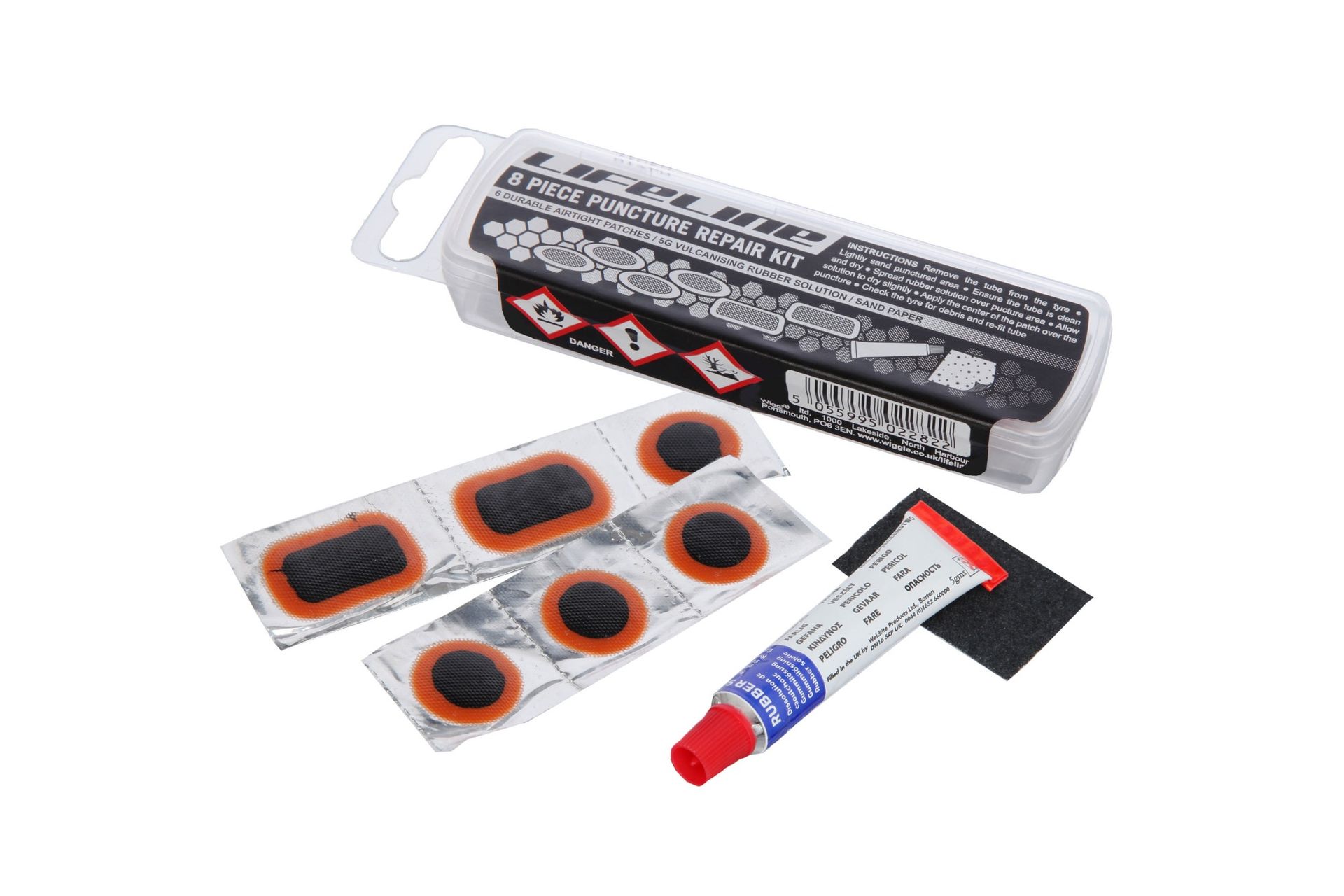
Cheap, simple, puncture repair kits have been around for a while and haven’t changed much. For the small expense and the minor weight and space penalty, it is very worthwhile bringing this – even if you’re not planning on even using the tubes!
Tubolito Flix Kit Repair Kit
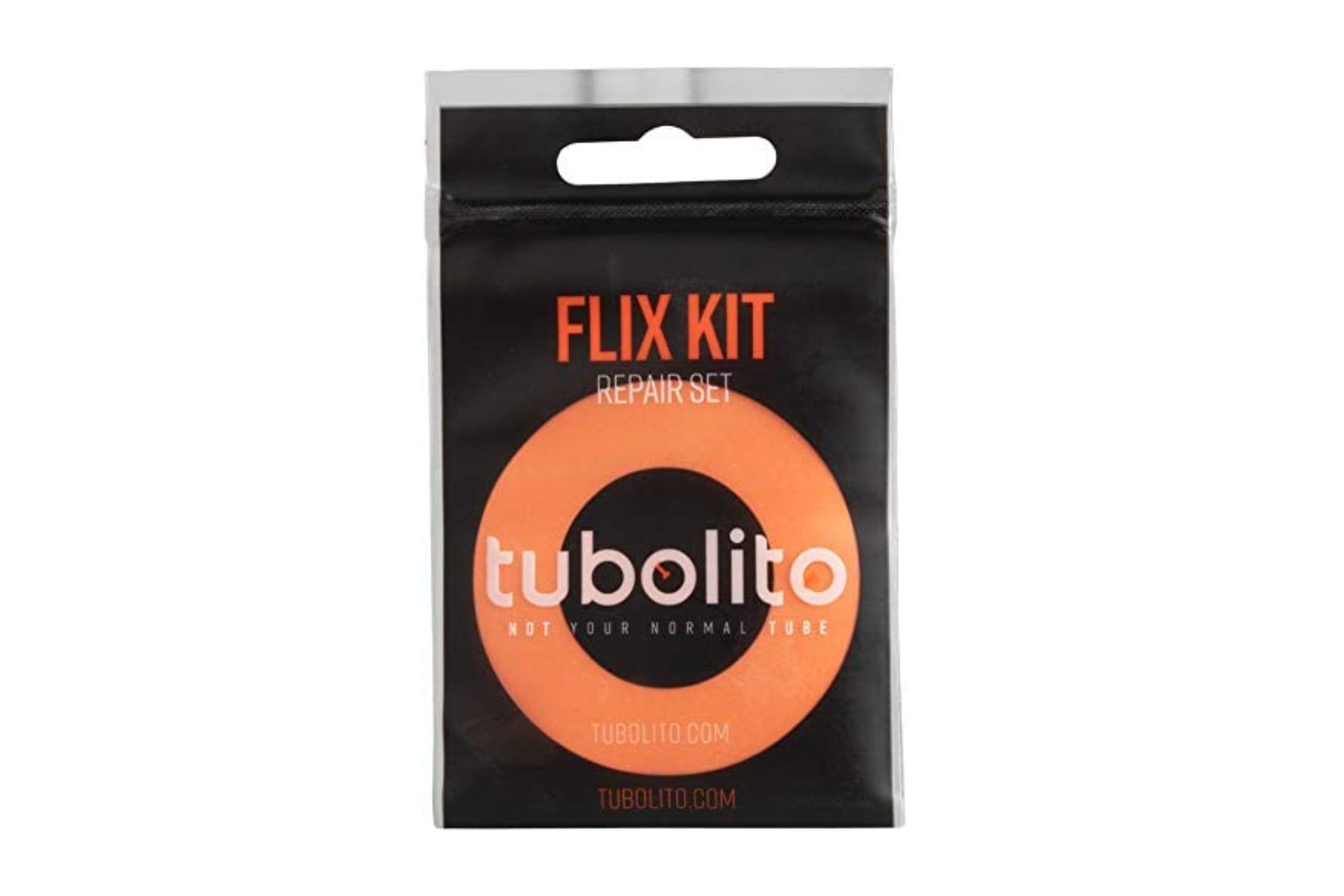
If you’ve gone for fancy tubes, you’ll need some fancy patches. That said, although there is a definite mark up beyond the cheapest Butyl tube puncture repair kits, these aren’t actually too expensive – very worth patching these tubes rather than throwing them away.
Tyre levers
You probably already have a set of these, but if you don’t – or if you aren’t satisfied with the ones you have – here’s our suggestion.
Pedro's Tyre Levers
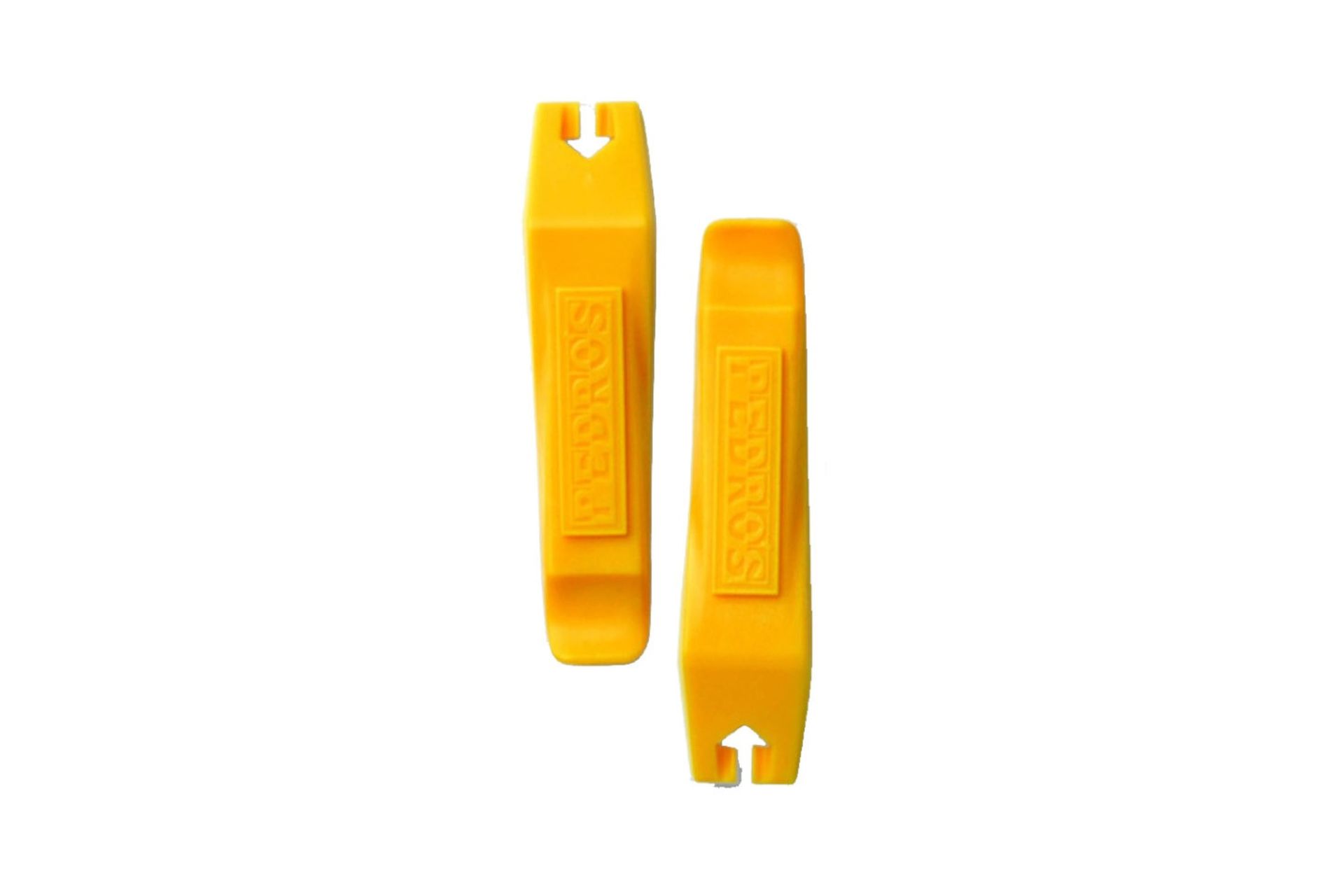
They might cost a little more than other tyre levers, they might be a little more bulky, but you will surely love them as we do.
They are exceptionally strong, so the risk of snapping a lever on a stubborn tubeless tyre is much lower. They are plastic, so won't damage your rims. They clip together which is great for not losing them – and they can attach to the spokes to hold in place if the tyre keeps popping back on the rim.
Just really great tyre levers in all.
Allen keys / chain tool / spoke key
You’ll likely already have all the tools of the multitool we’re about to suggest – but if you don’t, buying the tools on their own is really quite cheap.
Although a little heavier and bulkier to have all the tools separate, it is generally a lot cheaper and does make them easier to use. So it’s more a question of priorities really.
Silca Italian Army Knife - Venti

This is one of the most multi-functional multitools out there – but unlike some of the others, it even looks good and is pretty compact. The tools also haven’t been made impracticably small.
Here’s a list of all the tools it has, and we’ll say a few words about some of the important ones which sometimes get overlooked.
Hex Keys: 2mm, 2.5mm, 3mm, 4mm, 5mm, 6mm, 8mm
Torx Keys: T8, T10, T20, T25
Screwdrivers: Phillips Head 2, Straight Blade 4
Box Wrench: 7mm
Flare Nut Wrench: 8mm
Open End Wrench: 10mm
Spoke Wrenches: 13G, 15G
Forged Chain Breaker: Suitable for 10-12-speed chains
Others: Disc Pad Spreader, Valve Core Remover
An 8mm hex key is a very useful addition. Many multitools miss it off, but it’s commonly used for pedals. There’s perhaps more Torx keys than you need, but they are becoming more prevalent, so potentially good future proofing there.
The screwdriver heads and spanner sizes are all very common and great to have. Just double check with your spoke nipples to make sure this’ll work, but those are the most common sizes.
The value core remover tool – or perhaps more fittingly, the value core tightener – is a really great addition. There’s nothing worse than all the air quickly escaping from the tyre and making it pop off the bead. And those little plastic tighteners are so easy to lose.
Pump
Another item you’ll likely already have, so we’ll just give a suggestion of one we think is particularly good.
Crank Brothers Sterling Pump
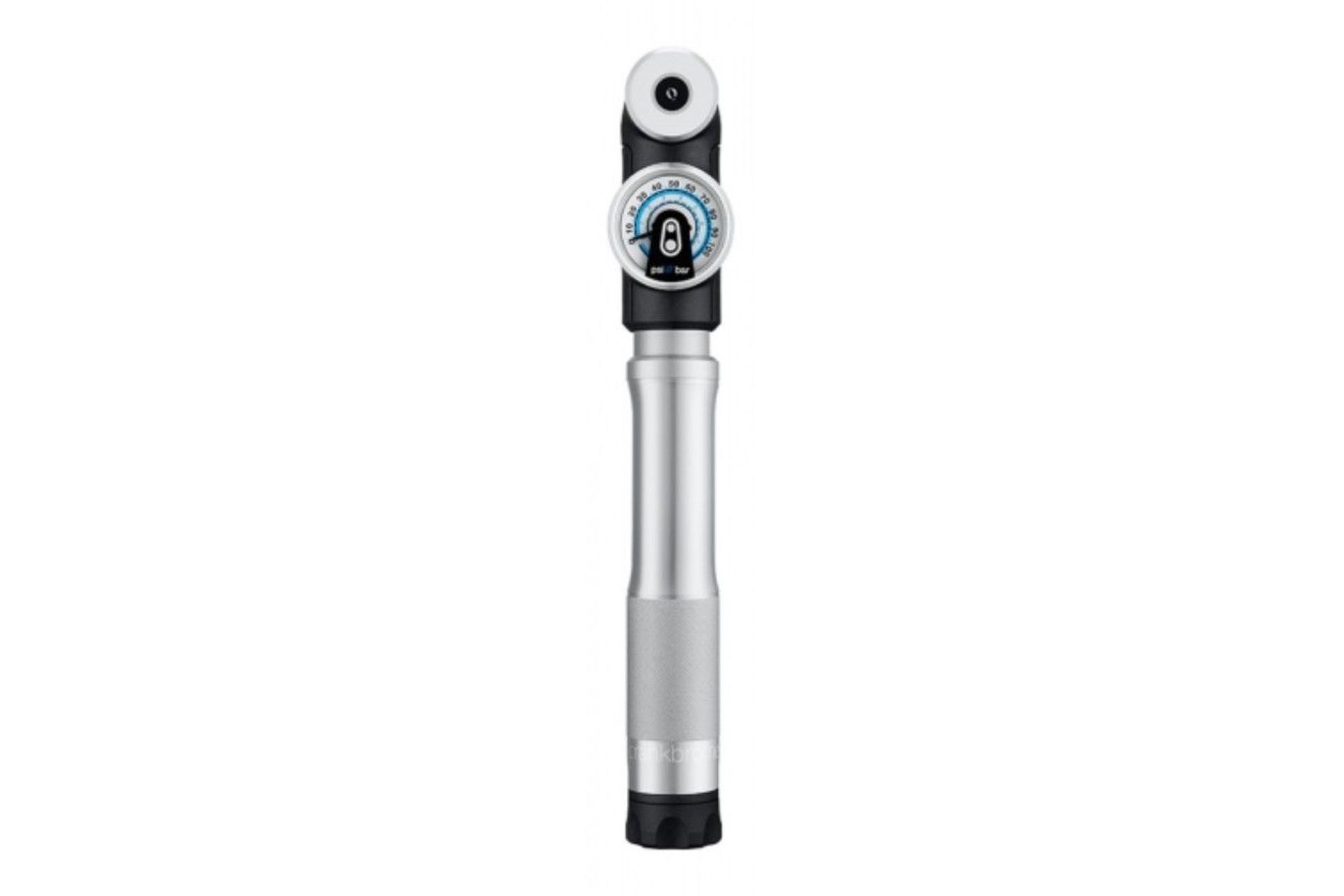
Setting the correct tyre pressure is so important for getting the optimal levels of grip, comfort and puncture protection – so it really helps to get a pump with an integrated gauge.
This one has settings for high volume and low volume tyres. Meaning more air can be sent through with each pump when the tyre is big, but for narrower tyres you’ll still be able to get them to high enough pressures without your arms crumpling around the pump.
Quick link
Shimano 11 Speed Quick Link SM-CN900
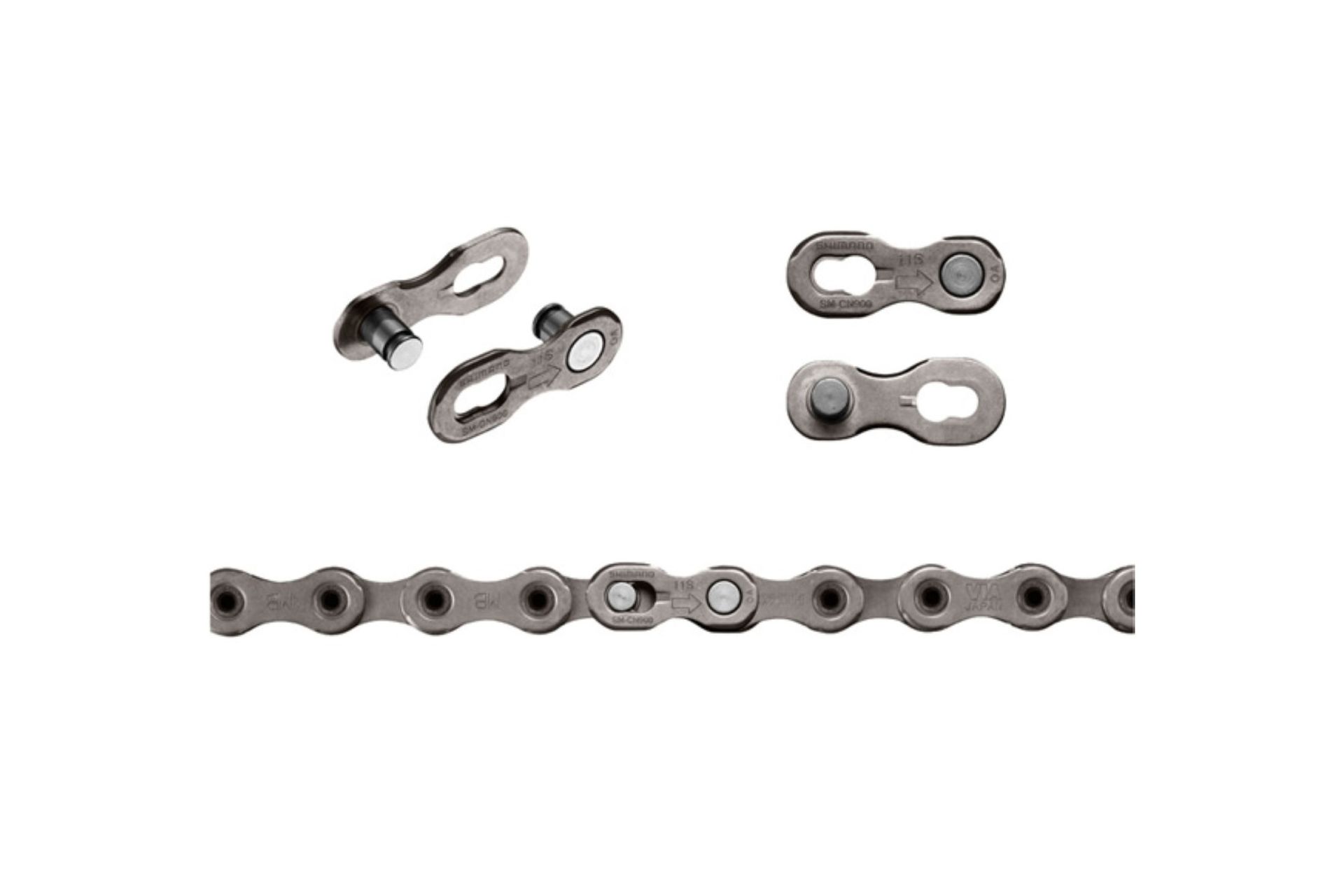
For something so small and lightweight, it can get you out of a massive pickle if your chain abruptly decides to snap.
Here’s a link to a Shimano 11-speed one, as these tend to be the most common (for now at least…). But if you click the link, you’ll be able to quickly navigate to all the other ones.
Tyre boot*
Now we come to the things which are really optional extras. If you’re going for a longer journey with a lot of people, it becomes more worthwhile bringing these things as rarer mishaps become more likely to happen.
But if you’re just going for a short trip with one other person, you could probably skip on these.
Park Tool Emergency Tyre Boot Patch

If you’ve cut such a large hole in your tyre that the sealant won’t fix it, then the chances are if you put in an inner tube it’ll just poke out the hole and get punctured almost immediately.
In that case, just place this inside the tyre covering the whole, and it’ll form a little barrier between the inner tube and the hole.
You can also use a polymer bank not for this, but they are a bit less rigid.
Mech hanger*
The point of a mech hanger is to be more fragile than the rear derailleur, so that if it takes a hit the mech hanger will snap instead of the – more expensive – rear mech.
That’s all well and good, but if you snap a hanger when out on a ride, you’re left in much the same position as if you had totalled your mech.
The rather obvious remedy to this is just to bring a spare one with you, they aren’t very big or heavy.
SRAM Universal Derailleur Hanger

Mech hangers are pretty specific to each bike, so it’s a little hard to come up with just one suggestion.
But there is this supposedly universal derailleur hanger, it won’t fit all bikes, but could help get a friend out of a tough situation if you take it along.
If you click the link, it’s quite quick to start searching through the many other hangers, although I’m sorry to say it probably won’t be so quick to find the one for your bike – but you’ll thank yourself for it if you do snap a hanger!
Brake pads*
Riding through wet and grimy conditions and braking with a heavy load can wear down your pads at a surprising rate. Given how small and light they are, and how disastrous the consequences are if you do wear your current set out, it’s a good idea to bring a set along.
Shimano Road Disc Brake Pads
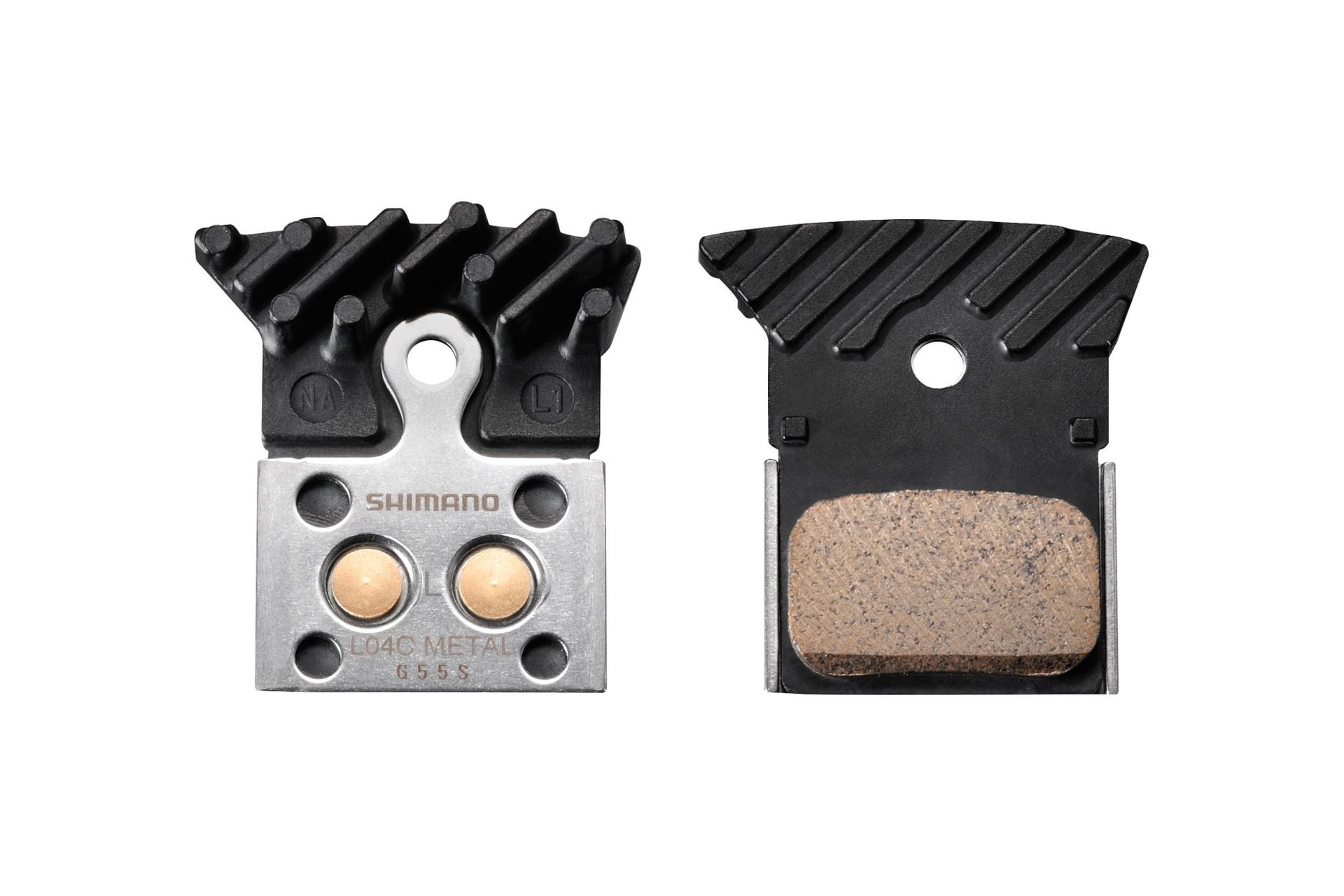
These pads will work with most of Shimano’s road offerings and the GRX gravel groupset. As with the other items, you’ll be able to find a full variety of the many other pad shapes by clicking on the links below.
Cassette tool*
It’s not very often your cassette nut will work itself loose, but if it does, that can be an avoidable end to your ride.
Park Tool FR-5.2 Cassette Lockring Tool

It’s not very big and it’s not very heavy, and as a cassette nut does require a specialist tool that not everyone has, it can really help to bring one along. But then again, this isn’t the most common of issues to have.
Gear cable*
For all the frustration a snapped gear cable can cause, compared to how small, light, and quick to fit they are, it can be a good idea to take one along with you.
If you’re maintaining your bike well, a cable randomly snapping isn’t overly likely, but the more of you there are, the greater the chances that one will.
Jagwire Inner Gear Cable
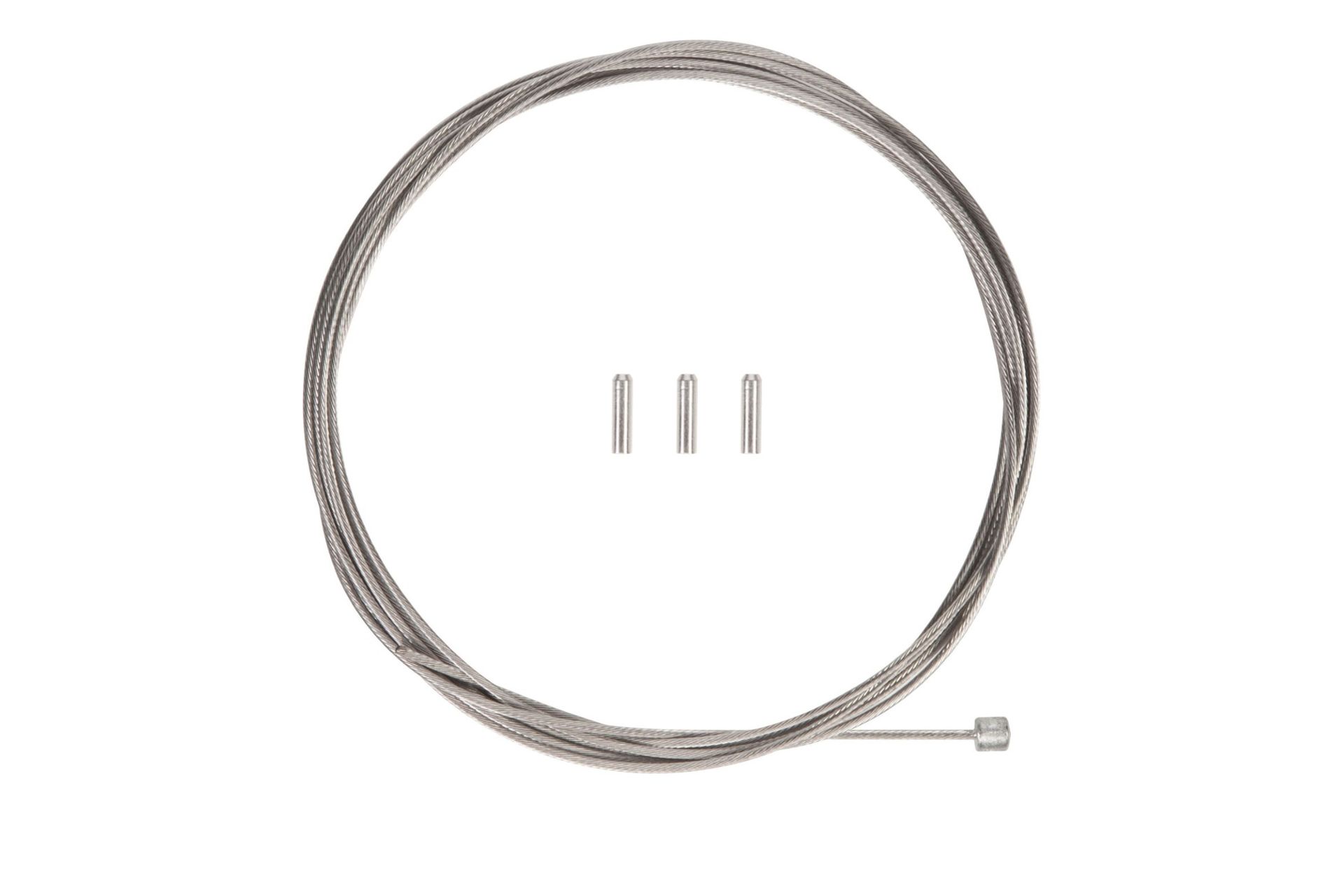
These don’t, and shouldn’t, cost much. Hopefully you’ll never need to us it and it’ll just sit in your tool bag forever. As such, there’s no point is getting a fancy one, just a basic one that will do the job.
But for your actual bike, a really high quality set of cables can make such a massive difference to how it feels to ride. An extra £20 on cables can make as big of a difference as spending an extra £200 on your wheels, so don’t economise here.
Adjustable spanner*
Last on the list as it’s the one you can most do without. But an adjustable spanner can still come in surprisingly useful and they aren’t that bulky, so it is worth a mention at least.
Casoter 10 Inch Adjustable Wrench
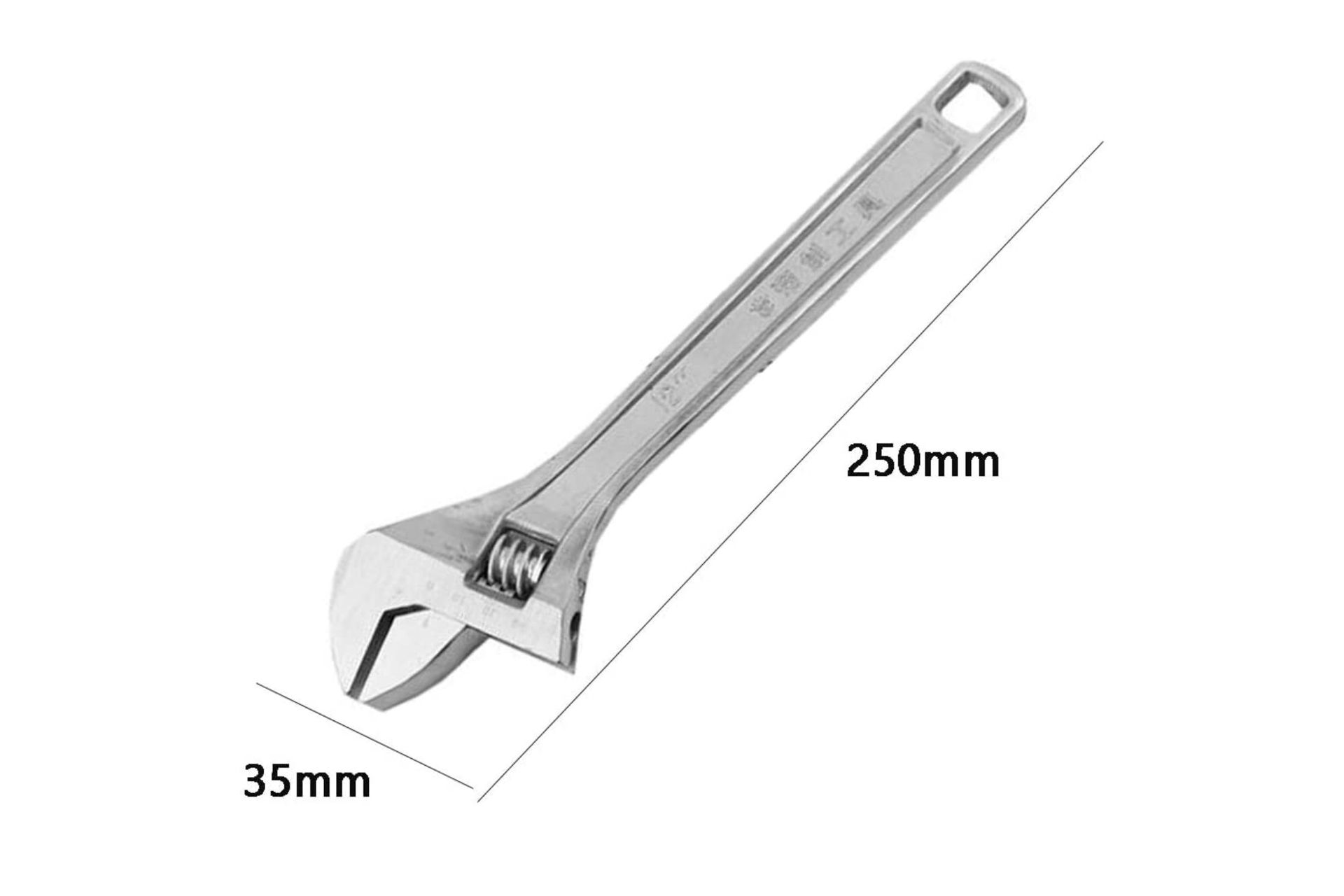
Not too big but still large enough for a cassette tool – so you can solve any issues there yourself!
Vital accessories
The recurring theme of this list is that you’ll have most of these things already – or you’ll at least have something that will do the job. The purpose here is more of being a reminder for most things and drawing your attention to perhaps a couple of things you might be missing.
Phone
Phone buying advice is quite far beyond our remit, so if you really want to drill into this, you’re better off checking with TechRadar. (opens in new tab)
But while you’re here, this is the phone they currently think has the best camera.
Samsung Galaxy S21 Ultra

To paraphrase an old adage; if you cycle into a forest and no one gets to see it, did you even bikepack?
Jokes aside, it is a nice thing to bring back some photographs of the places you’ve travelled to – particularly by bike!
Wallet / keys
Very important to bring these, but nothing we can link to – so here’s a stock image as a reminder.
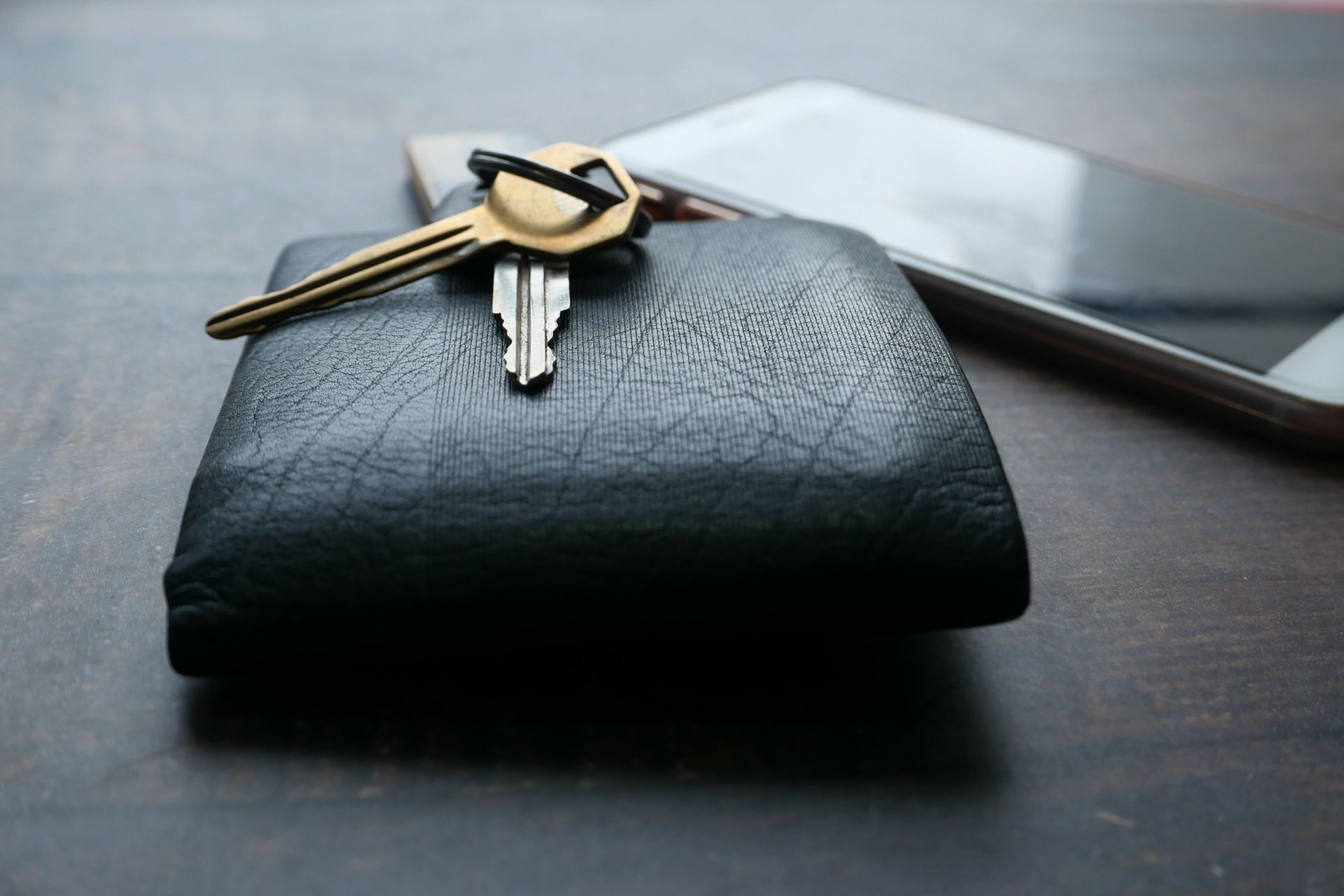
Head unit
You’re probably happy with the one you already have, but it is a real help for bikepacking to have a head unit with good mapping, so this could be the moment for an upgrade.
Garmin Edge 1030 Plus
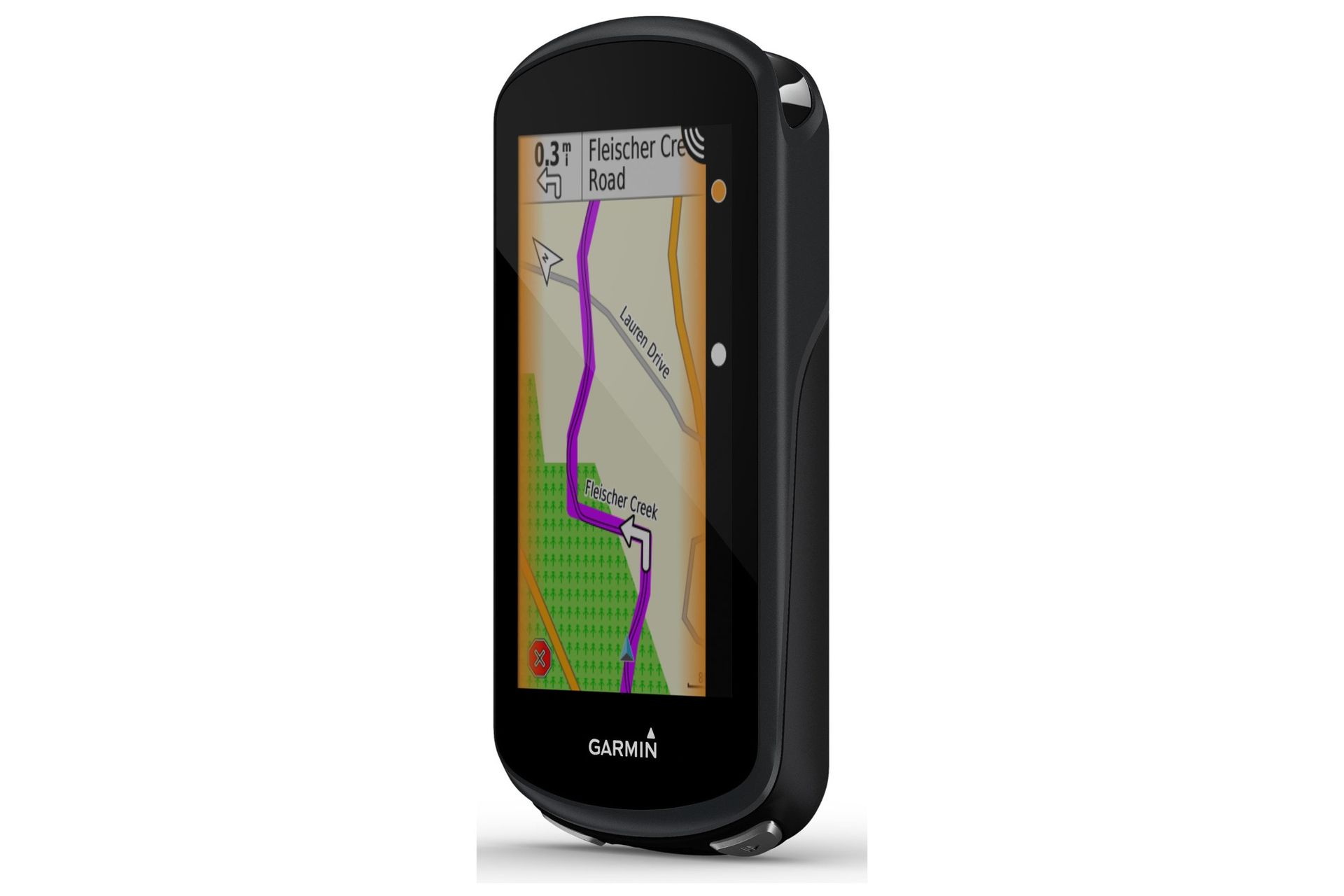
The huge screen makes it easy to follow a route, it also has excellent battery life which is always a real help.
We gave it a 10/10 in our review, but if you want to really delve into which headunit is best for you, you can check out our guide here.
Wall charger / battery pack / cables
Keeping all your devices charged while bikepacking does require some forethought. A wall changer in combination with a battery pack is the simplest solution, just remember to bring all the right cables!
Vida IT VS1 USB Dual 2 Port UK Mains Wall Charger
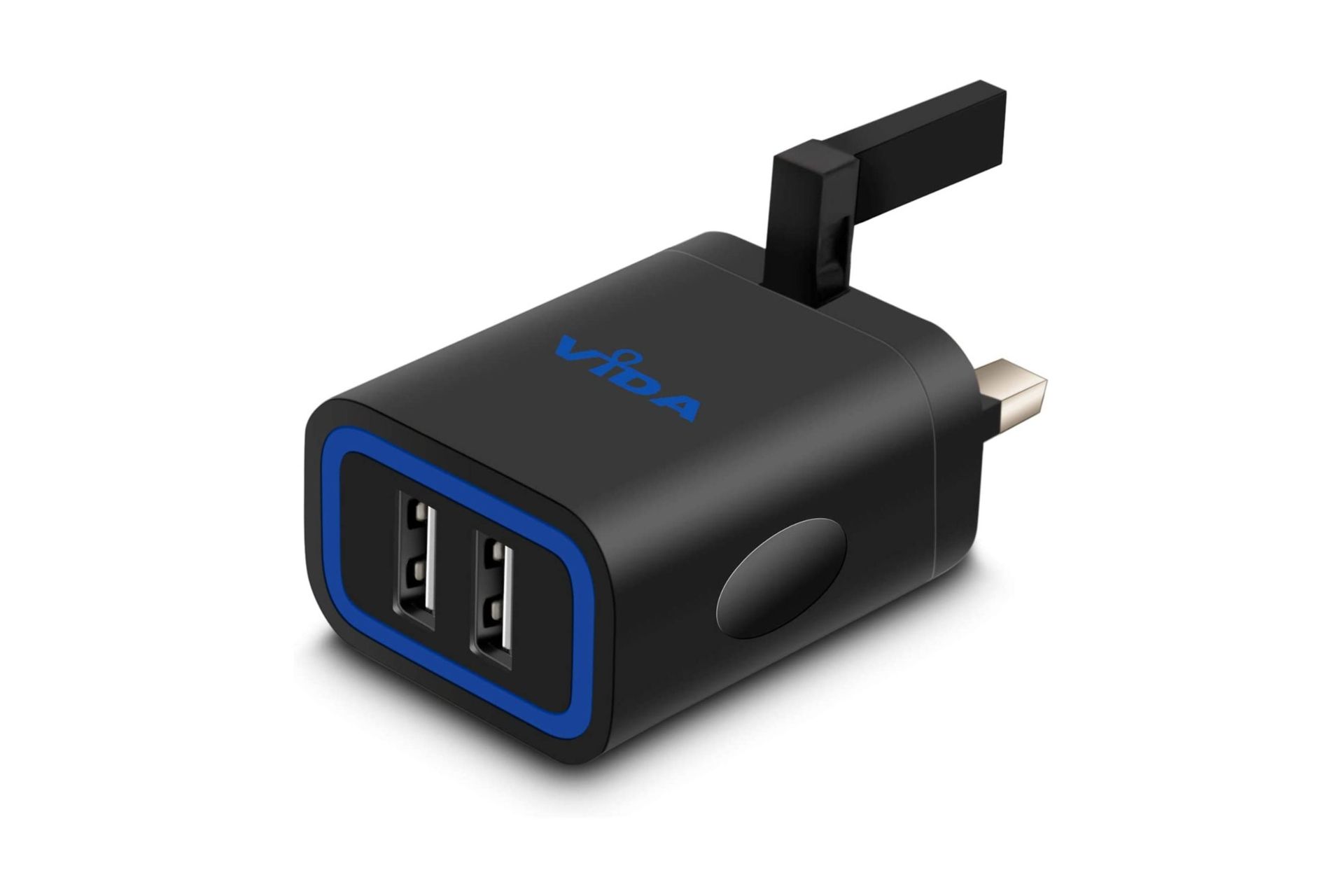
Just bringing any old wall charger will be fine, but if you do want to optimise a little more, this one can fold one of the pins down making it a bit more compact and easy to pack.
Omars Power Bank 10,000mAh
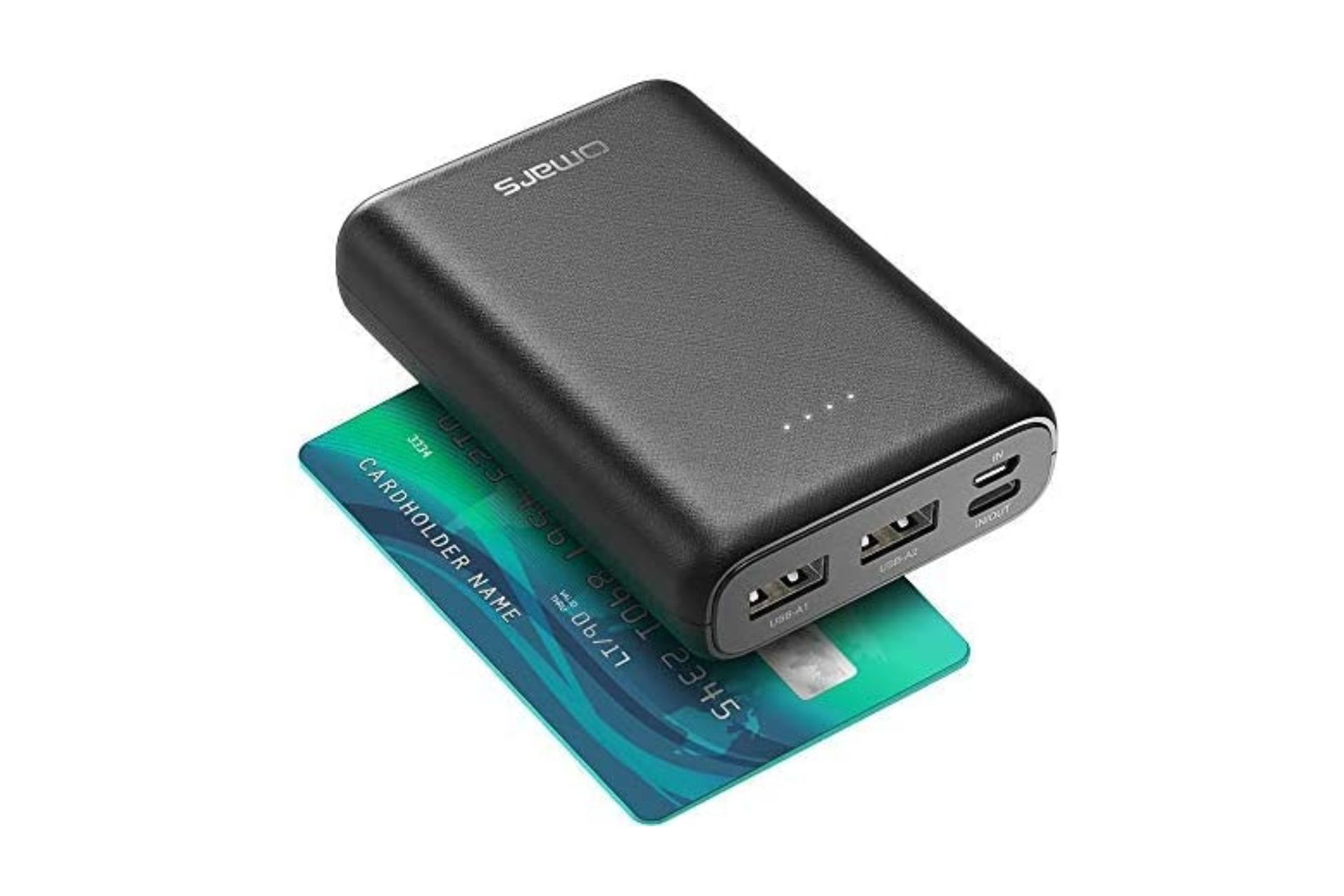
It is amazing how small and how much capacity battery packs have these days. 10,000 mAh is more than enough for bikepacking, unless you are heading off somewhere particularly remote and won’t be seeing a wall plug for several days.
This one can be charged by either micro USB or USB-C and it can pump out power from that same USB-C port and two normal USB ports, so super handy if you have lots of different cables.
Front and rear lights
Bikepacking is at its most pleasant when done in the summer, which handily is accompanied by plenty of daylight – so a powerful set of lights shouldn’t really be a necessity. But it is good to still have something as backup just in case you get caught out.
As these are just-in-case lights, they don’t need to be particularly powerful. Although if you are planning on spending a significant amount of time cycling in the dark, even in the summer, you’d best check out our guide to the best bike lights.
Exposure Trace & TraceR MK2 DayBright Light Set
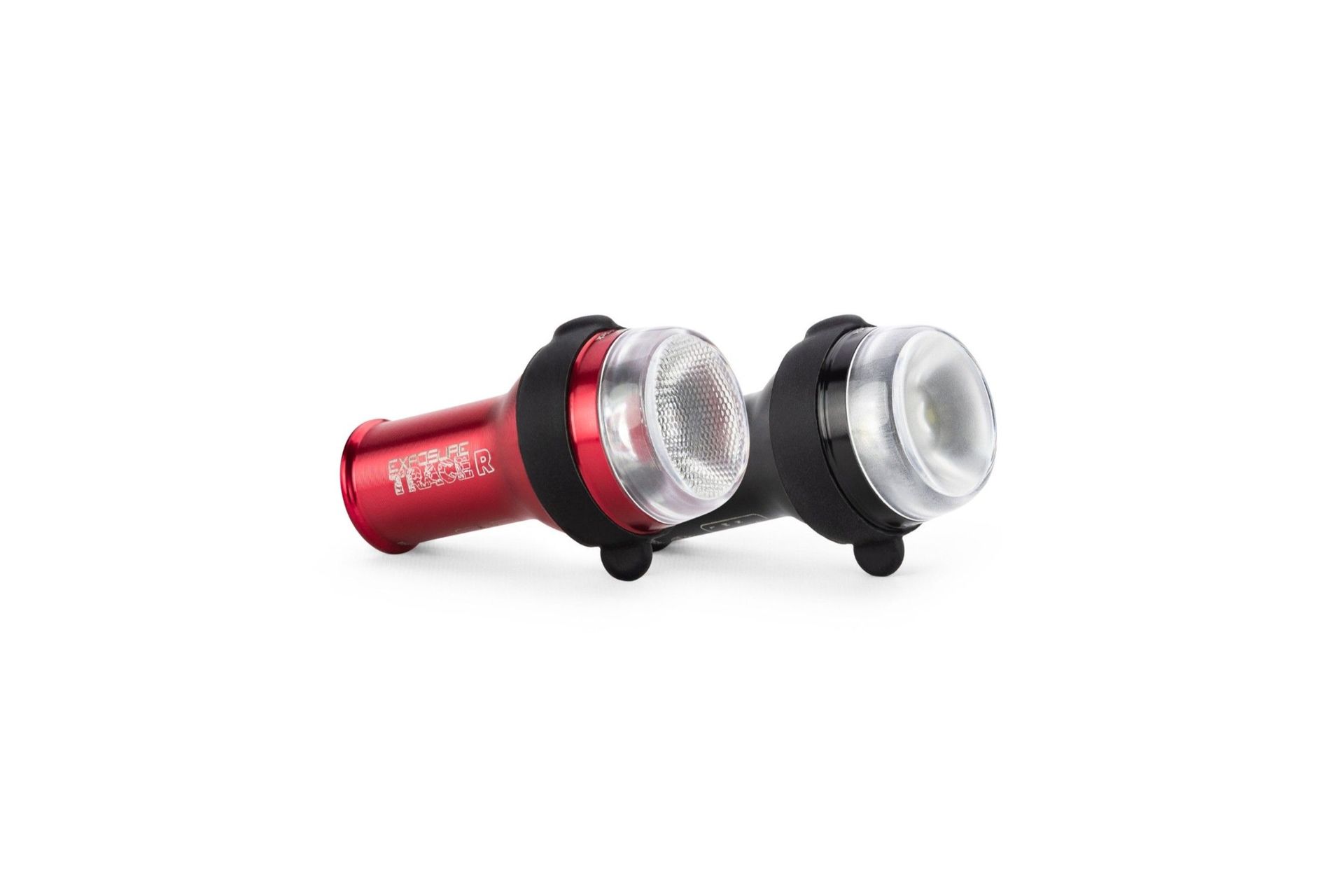
If you are in the market for some new lights, these are an excellent choice UK made, they’re small but bright and extremely reliable. The initial outlay might be a little on the large side, they will last you for ages and there is good customer service, so in the long run they might even work out as cheaper than buying a new set of lights every two years or so.
We were so impressed we have them a 9/10 and you can read the full review here.
Suncream, chamois cream, lip balm
It’s a lot of creams, and they’re all very useful, particularly when out on the bike all day. Naturally, it really helps to go for some travel sized ones as you won’t get through a lot and it’ll save you a lot of space and weight.
It might be tempting to skimp on some of these, but the risk of discomfort really isn’t worth it.
Happy Bottom Bum Butter
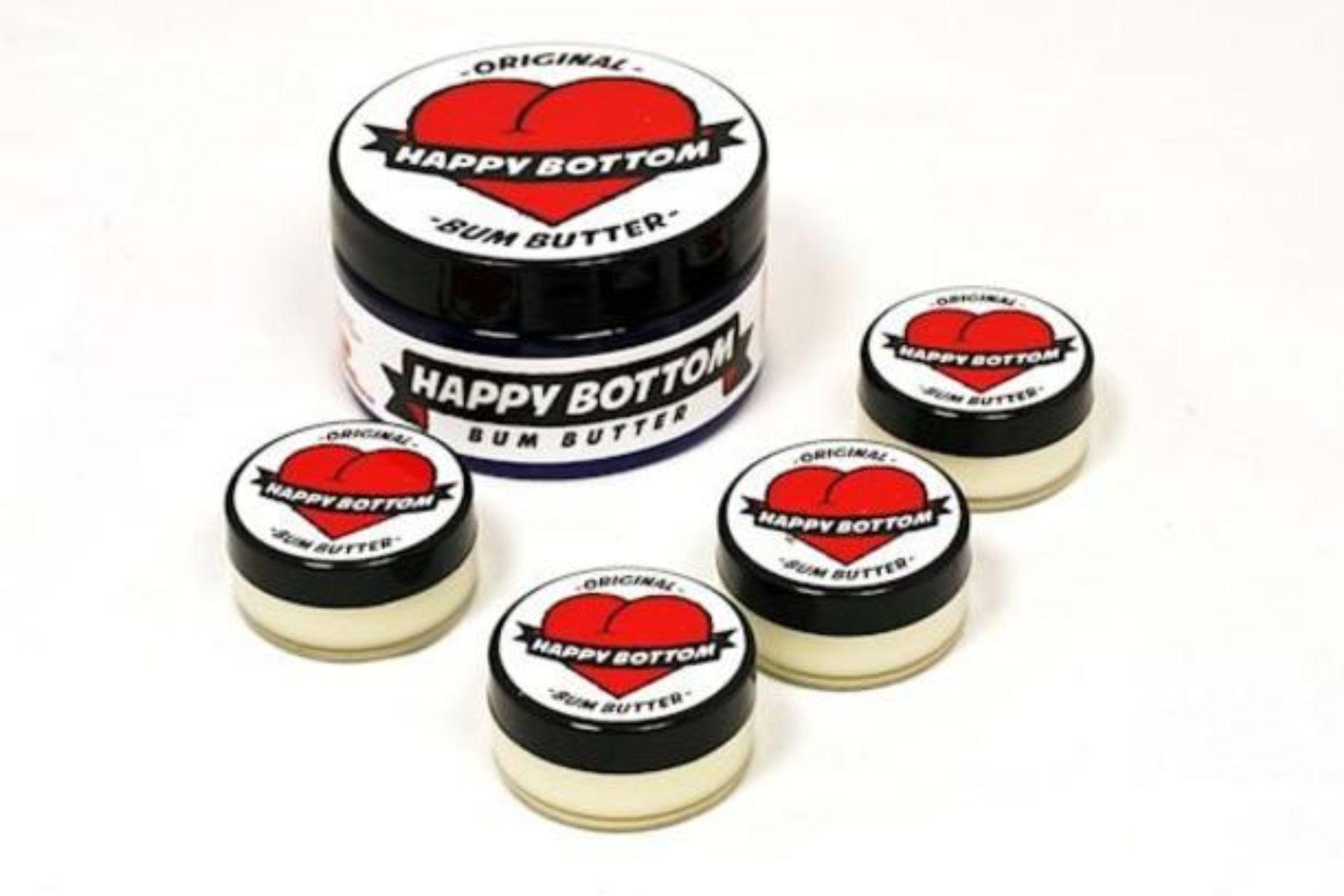
Lots of good things to say about this, it’s made from 100% natural ingredients, it’s vegan and not tested on animals, comes in a recyclable PET container. It’s female friendly, unlike some of those ‘zingier’ creams, and it comes in a very handy 10ml pot, perfect for traveling with.
You can even use it as a lip balm – just make sure you’re not double dipping!
NIVEA SUN Kids Protect & Care Pocket Size Sun Lotion 50SPF

It might say for kids, but anything that is kind on the skin and highly durable is something any bikepacker can very much appreciate too.
The small sizes it’s available in are particularly helpful too.
Lock
It’s really good to bring a lock, especially if traveling by yourself. The anxiety when popping into a shop of wondering if your bike will still be there when you come back out just isn’t worth the weight and space saving of not bringing on.
The decision to bring one is made much easier if you are taking the Restrap handlebar bag which has a handy integrated lock holder.
Oxford Alarm-D Pro Alarmed D-Lock 260mm
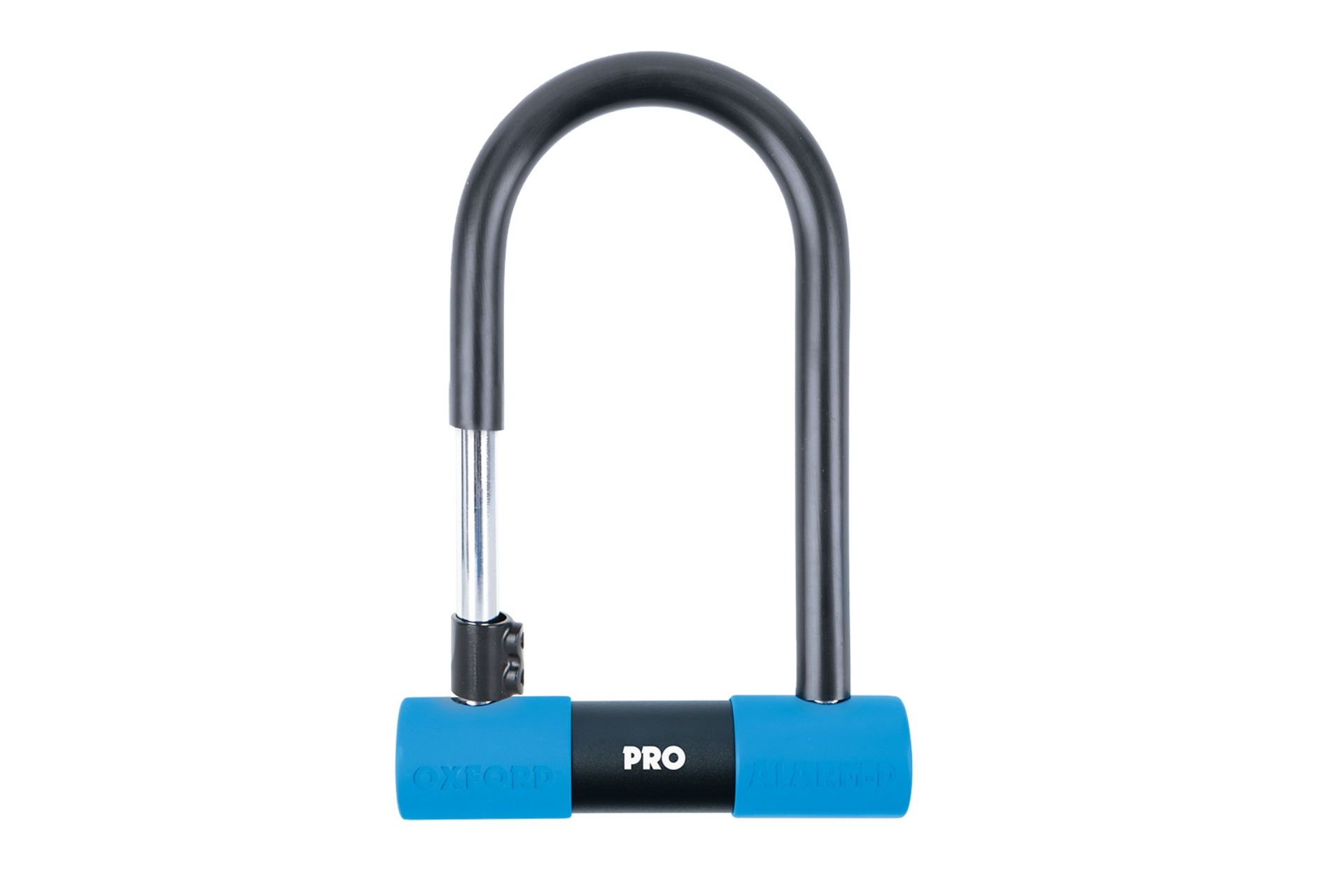
If you don’t already have a lock, or are looking to upgrade, this would be our recommendation. It’s Sold Secure Gold rated, and so will comply with your insurance policy – as well as providing a little more peace of mind.
It also features a motion sensitive alarm, which is very reassuring for those times when you’re camping in a field and there’s nowhere secure to lock your bikes up to. You can read our full review over here.
Waterbottles
Nothing fancy here, you’ll already have something that does the job. The only suggestion we can offer is going for something a little larger, as it can make a surprising difference being able to hold a full two litres of water on the bike – you have to worry much less about where you take your stops.
SiS 1000ml Wide Neck Water Bottle
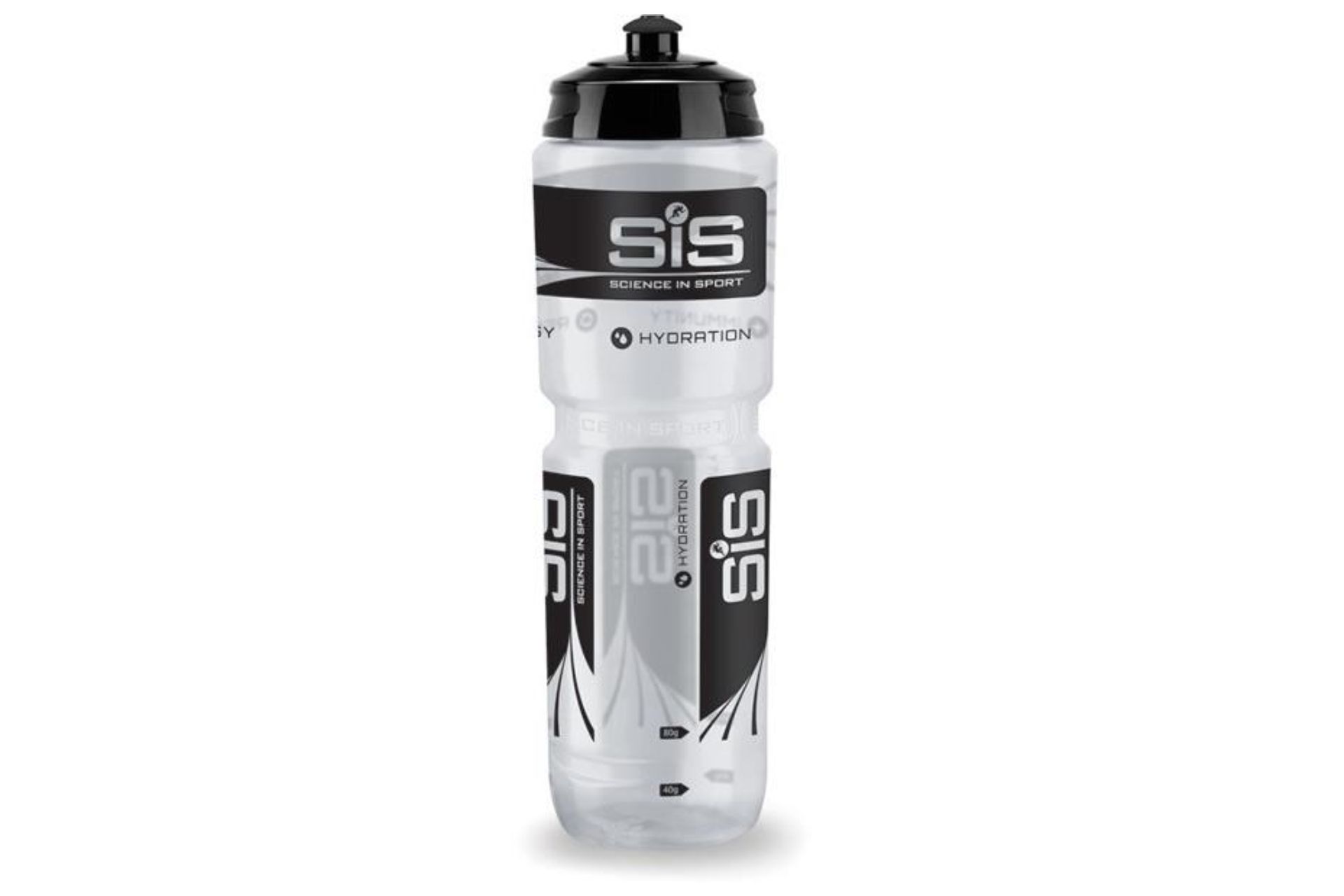
The nozzle is quite basic, just a simple pull up one. But these bottles will hold a full litre each, aren’t too expensive, and play nicely with most bottle cages.
Headtorch
These are so useful for doing anything in the dark, which you can end up doing surprisingly often, what with one thing and another.
You can also hang this up inside your tent to provide a little light to sort your stuff by – which is a lot more useful than it might sound.
SuperFire HL06 Head Torch
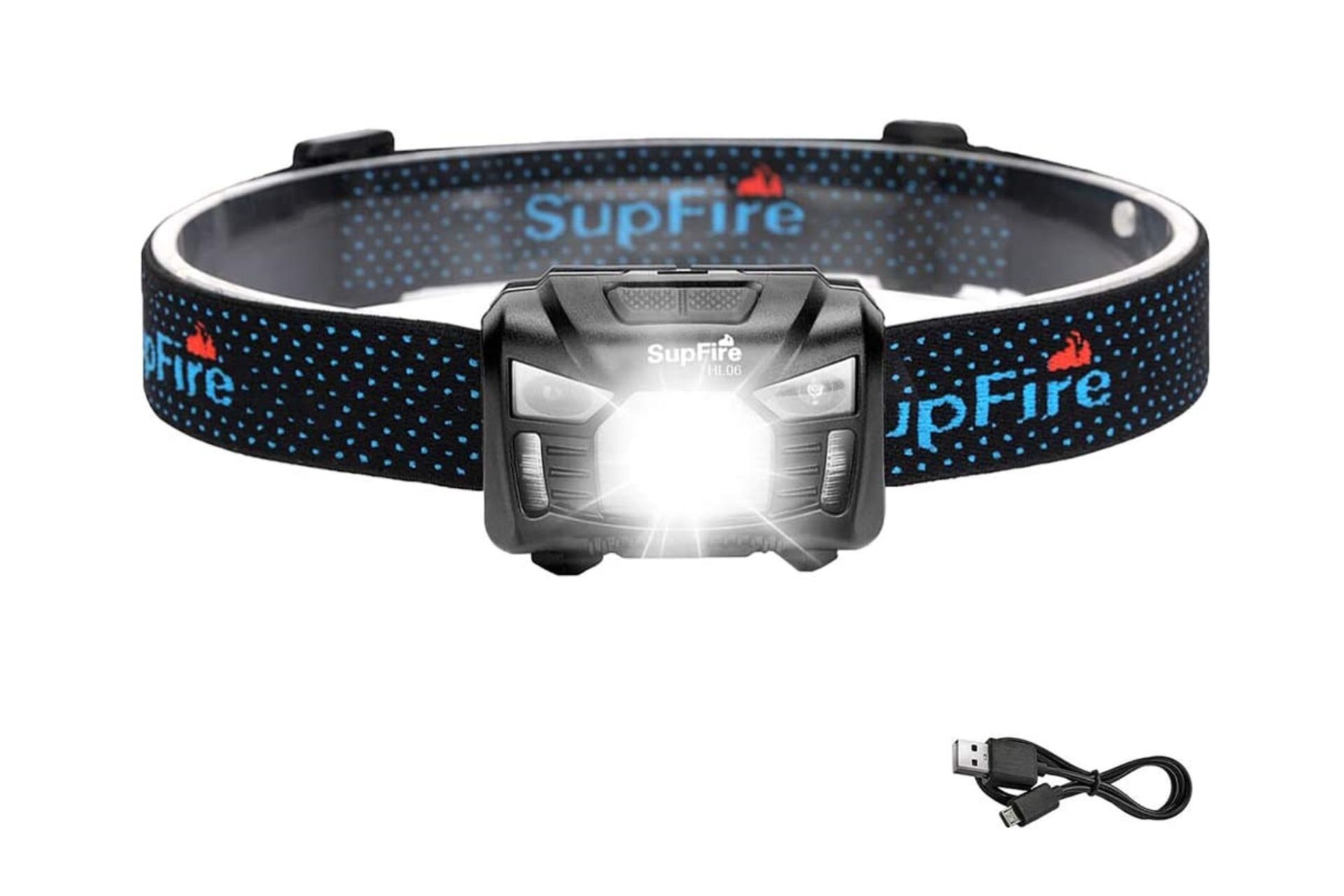
You don’t need to get anything fancy, this isn’t for high performance use. But one thing to look out for is that it is USB rechargeable, this really helps with knowing that it's fully topped up.
Ledlenser LED7298 H7R.2 Rechargeable Head Lamp

But if you are after something a little higher end, this one is more powerful and has a longer battery life. In higher quality head torches, look for ones with a rear mounted battery pack, this provides much better weight distribution.
Bike phone mount*
You don’t need to bring a phone mount with you, but it can be so useful for on-the-fly navigation like quickly trying to find a good café.
Going for a universal one not only makes it easy to foist navigational duties onto someone else in the group as phone model is irrelevant. But it also just makes it really quick and easy to mount and take off again.
Yenvine Bike Phone Mount
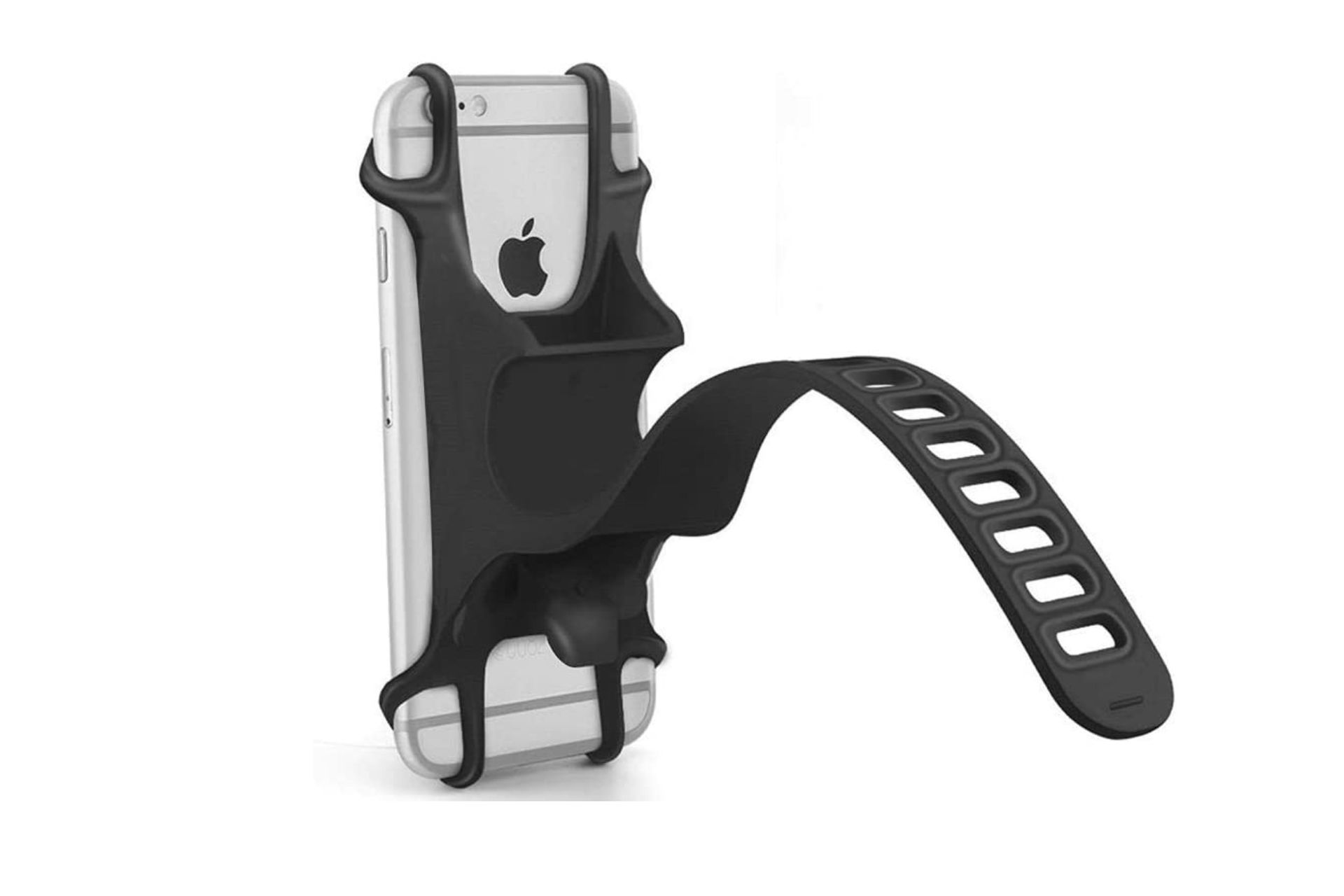
This one has a completely silicon construction and is essentially unbreakable. You don’t need to worry about stuffing it in your bags, it won’t cause damage to anything else and it won’t get damaged itself.
It’s not very heavy and given the number of times we’ve finished off a journey following google maps, it’s likely to end up getting a lot of use.
Penknife*
Might be overkill, but a penknife does often come in very useful and we’d always take one. We like Victorinox, so don’t be offended if you’re a diehard Leatherman fan – you already know what works best for you.
Victorinox Huntsman Swiss Army Pocket Knife

The two knives are obviously useful while the bottle opener, can opener and corkscrew all make for more enjoyable dinners. The tweezers and scissors are great for selfcare and while we haven’t often used the saw, we like to know it’s there.
That’s all the kit we’d bring, we hope you found this useful!

Thank you for reading 10 articles this month* Join now for unlimited access
Enjoy your first month for just £1 / $1 / €1
*Read 5 free articles per month without a subscription

Join now for unlimited access
Try first month for just £1 / $1 / €1

After winning the 2019 National Single-Speed Cross-Country Mountain Biking Championships and claiming the plushie unicorn (true story), Stefan swapped the flat-bars for drop-bars and has never looked back.
Since then, he’s earnt his 2ⁿᵈ cat racing licence in his first season racing as a third, completed the South Downs Double in under 20 hours and Everested in under 12.
But his favourite rides are multiday bikepacking trips, with all the huge amount of cycling tech and long days spent exploring new roads and trails - as well as histories and cultures. Most recently, he’s spent two weeks riding from Budapest into the mountains of Slovakia.
Height: 177cm
Weight: 67–69kg
-
-
 Closing the gap: David Gaudu emerges from Paris-Nice more confident than ever before
Closing the gap: David Gaudu emerges from Paris-Nice more confident than ever beforeThe Groupama-FDJ rider finished second overall at the Race to the Sun, but gained more than just the result
By Adam Becket • Published
-
 Goodbye lime: We need to talk about the Tour de France green jersey
Goodbye lime: We need to talk about the Tour de France green jerseyThere's change afoot at ASO's French races, with the combativity colour also undergoing a revamp
By Adam Becket • Published

